STORIES FROM HAWAIIAN AIRLINES

ARCHITECTURES OF LIGHT Seeing stars in the fireworks capital of Japan WALK ON THE WILD SIDE The power and beauty of Moloka‘i’s west coast HIDDEN VOLCANOES Exploring the Kahuku Unit of Hawai‘i Volcanoes National Park
V27 N 0 3 JUNE - JULY 2024

Turn a moment of fate into a lifetime of purpose.
MIKE COOTS / Kaua‘i, HI

OluKai.com/AnywhereAloha
Elevated Amenities, Unforgettable Moments
At The Launiu Ward Village residences in Honolulu, elevated amenities allow residents to relax, unwind, and celebrate.
Studio, One, Two, and Three Bedroom Residences
INQUIRE
thelauniuhawaii.com | +1 808 470 8066
Offered by Ward Village Properties, LLC RB-21701
THE PROJECT IS LOCATED IN WARD VILLAGE, A MASTER PLANNED DEVELOPMENT IN HONOLULU, HAWAII, WHICH IS STILL BEING CONSTRUCTED. ANY VISUAL REPRESENTATIONS OF WARD VILLAGE, INCLUDING WITHOUT LIMITATION, RETAIL ESTABLISHMENTS, PARKS, AMENITIES, OTHER FACILITIES AND THE CONDOMINIUM PROJECTS THEREIN, INCLUDING THEIR LOCATION, UNITS, VIEWS, FURNISHINGS, DESIGN, COMMON ELEMENTS AND AMENITIES, DO NOT ACCURATELY PORTRAY THE CONDOMINIUM PROJECTS OR THE MASTER PLANNED DEVELOPMENT. ALL VISUAL DEPICTIONS AND DESCRIPTIONS IN THIS ADVERTISEMENT ARE FOR ILLUSTRATIVE PURPOSES ONLY. THE DEVELOPER MAKES NO GUARANTEE, REPRESENTATION OR WARRANTY WHATSOEVER THAT THE DEVELOPMENTS, FACILITIES OR IMPROVEMENTS OR FURNISHINGS AND APPLIANCES DEPICTED WILL ULTIMATELY APPEAR AS SHOWN OR EVEN BE INCLUDED AS A PART OF WARD VILLAGE OR ANY CONDOMINIUM PROJECT THEREIN. EXCLUSIVE PROJECT BROKER WARD VILLAGE PROPERTIES, LLC, RB-21701. COPYRIGHT ©2024. EQUAL HOUSING OPPORTUNITY. WARNING: THE CALIFORNIA DEPARTMENT OF REAL ESTATE HAS NOT INSPECTED, EXAMINED OR QUALIFIED THIS OFFERING.
THIS IS NOT INTENDED TO BE AN OFFERING OR SOLICITATION OF SALE IN ANY JURISDICTION WHERE THE PROJECT IS NOT REGISTERED IN ACCORDANCE WITH APPLICABLE LAW OR WHERE SUCH OFFERING OR SOLICITATION WOULD OTHERWISE BE PROHIBITED BY LAW. NOTICE TO NEW YORK RESIDENTS: THE DEVELOPER OF THE LAUNIU WARD VILLAGE AND ITS PRINCIPALS ARE NOT INCORPORATED IN, LOCATED IN, OR RESIDENT IN THE STATE OF NEW YORK. NO OFFERING IS BEING MADE IN OR DIRECTED TO ANY PERSON OR ENTITY IN THE STATE OF NEW YORK OR TO NEW YORK RESIDENTS BY OR ON BEHALF OF THE DEVELOPER/OFFEROR OR ANYONE ACTING WITH THE DEVELOPER/ OFFEROR’S KNOWLEDGE. NO SUCH OFFERING, OR PURCHASE OR SALE OF REAL ESTATE BY OR TO RESIDENTS OF THE STATE OF NEW YORK, SHALL TAKE PLACE UNTIL ALL REGISTRATION AND FILING REQUIREMENTS UNDER THE MARTIN ACT AND THE ATTORNEY GENERAL’S REGULATIONS ARE COMPLIED WITH, A WRITTEN EXEMPTION IS OBTAINED PURSUANT TO AN APPLICATION IS GRANTED PURSUANT TO AND IN ACCORDANCE WITH COOPERATIVE POLICY STATEMENTS #1 OR #7, OR A “NO-ACTION” REQUEST IS GRANTED.
 THE LAUNIU WARD VILLAGE AMENITY LOBBY
THE LAUNIU WARD VILLAGE AMENITY LOBBY
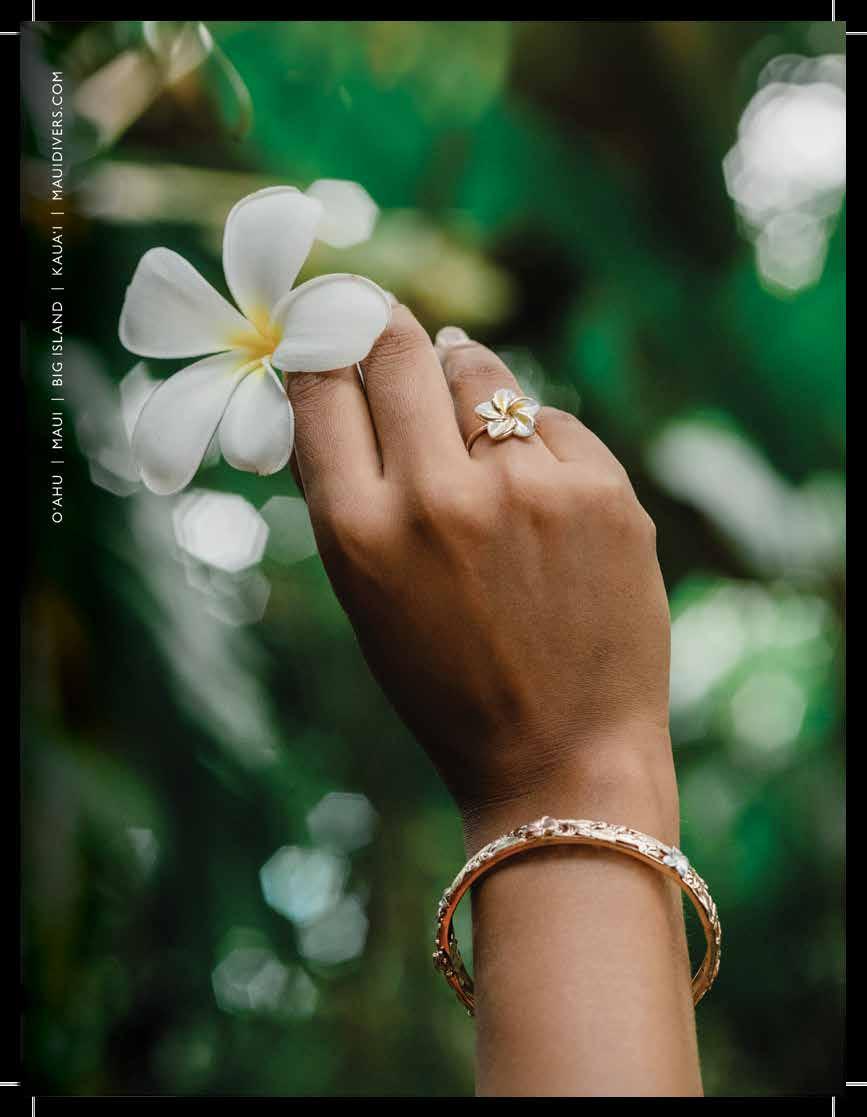


Heaven: Immersing yourself in an oasis at Kilolani Spa.
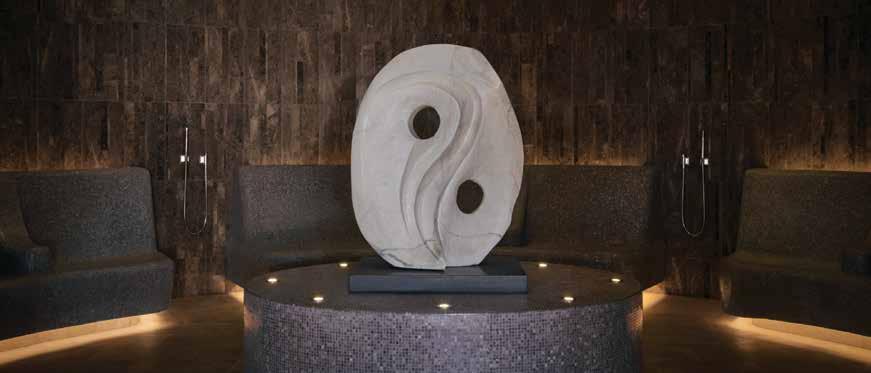
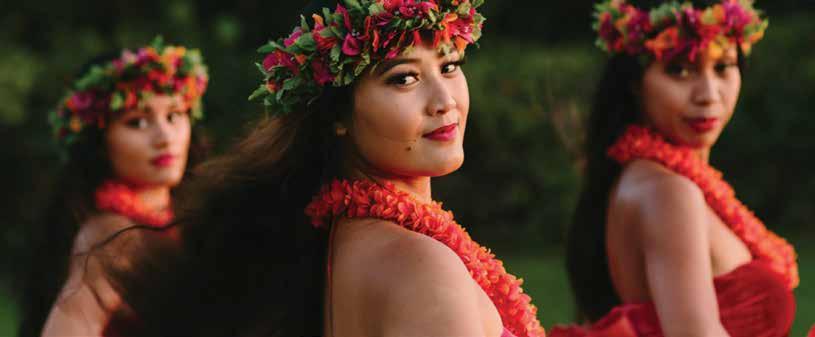
Ear th: Experiencing a ceremonial Lū‘ au.

Sea: Feeling weightless in the waves of the pacific.



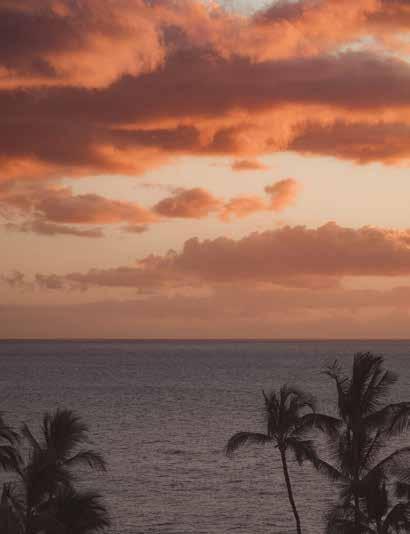
1 8 0 8 8 7 5 1 23 4 3 850 W A I L E A A L A N UI DRIV E , W AI L EA, H I GRA N D W AI L EA . CO M Heaven, Ear th, Sea.

DEPARTMENTS & FEATURES
38 / The Other Side of Volcanoes Exploring the Kahuku Unit of Hawai‘i Volcanoes National Park
STORY BY CONNER GORRY
PHOTOGRAPHY BY ANDREW RICHARD HARA
48 / Recorded History
The Hawai‘i State Archives is digitizing the largest collection of Hawaiian music in the world
STORY BY LARRY LIEBERMAN
PHOTOGRAPHY BY JOHN HOOK
56 / Gliding to Glory Hawai‘i’s only synchronized skating team is in it to win it—and they just might
STORY BY PETER VON BUOL
PHOTOGRAPHY BY ELYSE BUTLER
64 / The Artisans of Incandescence Building beautiful explosions in Nagaoka, the fireworks capital of Japan
STORY BY MARTHA CHENG
PHOTOGRAPHY BY BEN WELLER
76 / Realm of Stone and Sea Walking Moloka‘i’s wild west end
WORDS BY SHANNON WIANECKI
PHOTOGRAPHY BY PF BENTLEY
90 / The Trickster Heimana Reynolds has carved a career—and an Olympic berth—from the deck of a skateboard
STORY BY LIAM WILMOTT
PHOTOGRAPHY BY ARTO SAARI
102 / Nourishing the Roots Indigenous cuisine is experiencing a rebirth in Hawai‘i and around the world
STORY BY MARTHA CHENG
PHOTOGRAPHY BY LAURA LA MONACA

112 / Events Calendar & Island by Island
143 / Hawaiian Airlines Information
160 / PAU HANA
Interplanetary Culture
STORY BY SARAH ROSE
08 76 Contents V27 N 0 3 JUNE - JULY 2024 ISLAND INTELLIGENCE 22 / Wheels of Fire STORY BY CONNER GORRY PHOTOGRAPHY BY RICKY-THOMAS SERIKAWA 25
Not Just Your Po Po’s Game
/
MATT MALLAMS 26 / Disappearing Act
BY
BY MEGAN SPELMAN 29 / King Corm STORY BY CATHARINE LO GRIFFIN 30 / Pigments of the Imagination
BY KATIE YOUNG YAMANAKA PHOTOGRAPHY BY ASHLEY UPTAIN 32 / A Walk through Time STORY BY KATHLEEN WONG PHOTOGRAPHY BY CABLE HOOVER
STORY BY MARTHA CHENG PHOTOGRAPHY BY
STORY
MADELEINE HILL PHOTOGRAPHY
STORY


Our Wave collection comes in several styles and sizes and is available in 14K Yellow, White or Rose Gold. An incomparable collection of Hawaiian and Island lifestyle jewelry O‘AHU • MAUI • K AUA‘I • BIG ISLAND OF HAWAI‘I • NCL PRIDE OF AMERICA BELLEVUE • BOSTON • CH ICAGO • DALLAS • DENVER • L AS VEGAS • NEW YORK ORLANDO • PHILADELPHIA • PLEASANTON • PORTLAND • ROSEVILLE • SAN DIEGO SAN FRANCISCO • SAN JOSE • WASHINGTON, D.C. NaHoku.com • 1- 800 -260 -3912 HAWAII’S BEST People’s Choice Awards The Star-Advertiser 2014 – 2023 NAHO-39147_OpalUltWave_HanaHou__JuneJuly2024_7.3x9.8.indd 1 3/14/24 5:37 PM


MARKS OF DISTINCTION / Few Polynesian tattoos illustrate one’s commitment to culture and community more than the maka uhi, or facial tattoo. Meet the Native Hawaiian men who’ve earned their maka, revived a tradition that was nearly lost and assumed the kuleana (responsibility) that comes with it.
Forget to take your copy of Hana Hou! from the seat pocket? Miss a story from a back issue? Want to share a story or a video you’ve seen on the in-seat media player or on the Hawaiian Airlines app? Hana Hou! is now online as well as on-screen. Visit our new web site at the link below or scan the QR code to view the current issue and selections from our archive.
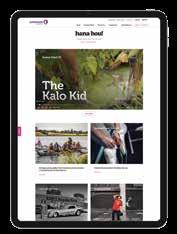



hawaiianairlines.com/hawaiistories/hana-hou
tv @hanahoumag
10
REALM OF STONE AND SEA / Raw, elemental, isolated and rough, the west end of Moloka‘i is a place of extremes. Photographer PF Bentley captures the rarely seen beauty and primoridal ferocity of his adoptive home.
photograph by pf bentley
/HanaHouMagazine
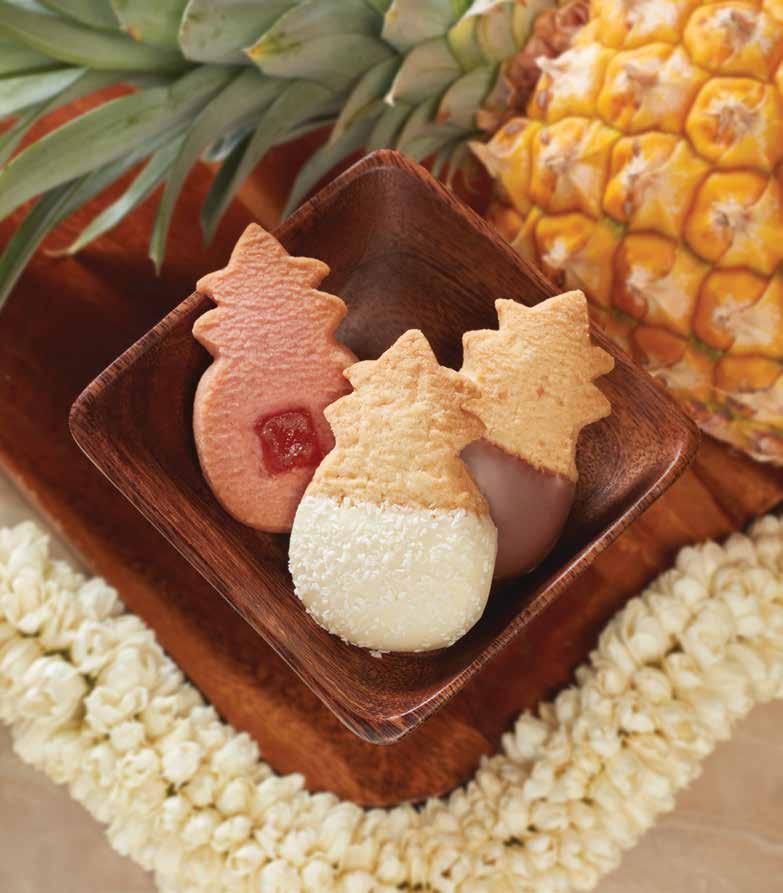
*For offer details visit honolulucookie.com/hawaiianmiles The pineapple shape of cookies is a registered U.S. patent and trademark of Honolulu Cookie Company. June-July 2024. Hana Hou! ©2024 Honolulu Cookie Company. All Rights Reserved. Earn 4 Miles per Dollar* For the Very Best, Look for the Pineapple Shape® honolulucookie.com 1 (866) 333-5800 Discover our elegantly packaged premium shortbread cookies. Indulge in Aloha with island-inspired flavors like Pineapple, Coconut, Guava, and more! Royal Hawaiian Center Sand Island Retail Store Waikiki Beach Marriott Waikiki Beach Walk® Waikiki Shopping Plaza OAHU Ala Moana Center Hilton Hawaiian Village Hyatt Regency Waikiki International Market Place Outrigger Waikiki Beach Resort MAUI The Shops at Wailea LAS VEGAS The LINQ Promenade GUAM The Plaza Shopping Center
PUBLISHER & CEO
Jason Cutinella
PARTNER/GM —HAWAI‘I
Joe V. Bock
EDITOR
Michael Shapiro
DIRECTOR OF PHOTOGRAPHY
Matt Mallams
MANAGING DESIGNER
Taylor Niimoto
DESIGNERS
Eleazar Herradura
Coby Shimabukuro-Sanchez
VP FILM
Gerard Elmore
FILMMAKERS
Blake Abes
Romeo Lapitan
Erick Melanson
VIDEO EDITOR
Jhante Iga
STUDIO DIRECTOR/ PRODUCER
Kaitlyn Ledzian
DIGITAL CONTENT MANAGER
Brigid Pittman
DIGITAL PRODUCTION DESIGNER
Arriana Veloso
PRODUCER
Taylor Kondo
HAWAIIAN CULTURAL ADVISER
Kahōkū Lindsey-Asing
OPERATIONS
ACCOUNTS RECEIVABLE
Gary Payne
OPERATIONS DIRECTOR
Sabrine Rivera
TRAFFIC MANAGER
Sheri Salmon
CLIENT SERVICES DIRECTOR
Kristine Pontecha
ADVERTISING
SENIOR DIRECTOR, SALES
Alejandro Moxey
VP SALES
Mike Wiley
ADVERTISING DIRECTOR
Simone Perez
DIRECTOR OF SALES
Tacy Bedell
HEAD OF MEDIA SOLUTIONS & ACTIVATIONS
Francine Beppu
ACCOUNT EXECUTIVE
Rachel Lee
SALES COORDINATOR
Will Forni
CONTACT
EDITORIAL INQUIRIES
editors@NMGnetwork.com
SALES INQUIRIES sales@NMGnetwork.com
CONTRIBUTORS
Andrew Richard Hara
Arto Saari
Ashley Uptain
Ben Weller
Cable Hoover
Catharine Lo Griffin
Conner Gorry
Elyse Butler
John Hook
Katie Young Yamanaka
Kathleen Wong
Laura La Monaca
Larry Lieberman
Liam Wilmott
Madeleine Hill
Martha Cheng
Matt Mallams
Megan Spelman
Peter von Buol
PF Bentley
Ricky-Thomas Serikawa
Sarah Rose
Shannon Wianecki
Published by: NMG Network 41 N. Hotel St. Honolulu, HI 96817
©2024 by NMG Network, LLC. Contents of Hana Hou! are protected by copyright and may not be reproduced without the expressed written consent of the publisher. Hana Hou! assumes no liability for products or services advertised herein.

3375 Koapaka Street, G-350 Honolulu, HI 96819
Phone: 808-835-3700
Fax: 808-835-3690
Mailing Address: PO Box 30008 Honolulu, HI 96820
For questions related to travel, visit us online at HawaiianAirlines.com or contact us at any of the following numbers:
UNITED STATES / CANADA
1-800-367-5320
Monday-Sunday, 24 hours Text 38285 Monday-Sunday, 5:00am - 11:00pm HST
AUSTRALIA (61) 1-800-955-912
CHINA (86) 10-6502-6766
JAPAN (81) 570-018-011 Monday-Sunday
NEW ZEALAND (64) 0800-449-415
AMERICAN SĀMOA (684) 699-1875
SOUTH KOREA (82) 2-775-5552
TAHITI (689) 40-866-000
CONSUMER AFFAIRS
HawaiianAirlines.com/CAO
BAGGAGE INQUIRIES 1-866-389-6654 Monday-Sunday, 8:00am - 4:30pm HST
H awaiian M iles
For information on our frequent flyer program, please contact our HawaiianMiles Service Center Monday-Friday, 7:00am - 4:30pm HST 1-877-HA-MILES or 1-877-426-4537
HAWAIIAN AIR CARGO INQUIRIES 1-877-422-2746
HawaiianAirCargo.com

ON THE COVER When Worlds Collide
A wave breaks at Kaiaka Rock on the west end of Moloka‘i.
PHOTOGRAPH BY PF BENTLEY
V27 N 0 3 JUNE - JULY 2024
12 TO SUBSCRIBE, VISIT NMGNETWORK.COM/PUBLICATIONS
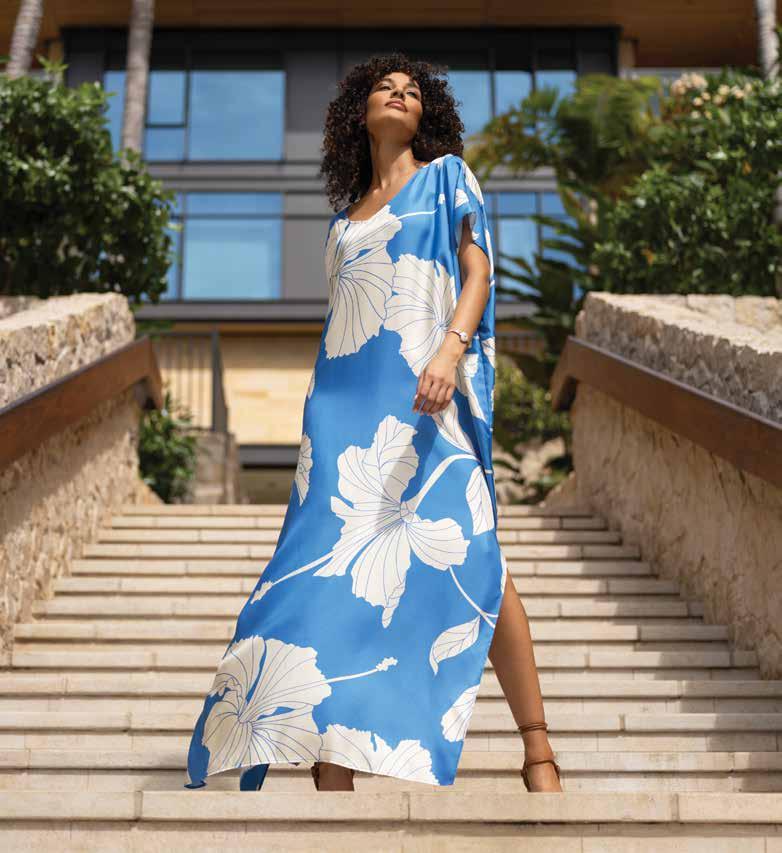
MAUI:
AT WAILEA HYATT REGENCY MAUI RESORT & SPA KAUAI: GRAND HYATT KAUAI RESORT SHOPS AT KUKUI‘ULA BIG ISLAND: KINGS’ SHOPS TORIRICHARD.COM
OAHU: ALA MOANA CENTER OUTRIGGER WAIKIKI BEACH RESORT HILTON HAWAIIAN VILLAGE ROYAL HAWAIIAN HOTEL KAILUA VILLAGE SHOPS KAHALA MALL
WHALERS VILLAGE SHOPS
“Pua Nui” 100% Mulberry Silk Amari Caftan.
PF Bentley

“They call West Moloka‘i ‘the Wild West’ for a reason,” says photographer and West Moloka‘i resident PF Bentley, who shot “Realm of Stone and Sea” for this issue. “It’s a world apart from the rest of Hawai‘i, running on its own time, miles from civilization and Moloka‘i’s limited conveniences. Selfreliance and a knowledge of the environment is a necessity to deal with daily life on this rugged frontier, with its few paved roads. Our biggest fear driving is not fellow drivers or traffic but hitting deer racing across the road.” Bentley, who grew up in Waikīkī, first came to Moloka‘i in 1971 when he was a student at the University of Hawai‘i at Mānoa. “I was an urban kid landing in this very rural Hawaiian environment, which I fell right into,” he says. Bentley spent twenty years covering the nation’s political landscape for TIME magazine before returning to the Islands to photograph without wearing a suit and tie. He’s won several Pele Awards for Hana Hou! including the National Gold First Place award for his “Face of Moloka‘i” project.

“ You’re truly part of the ‘ohana when folks share their secret spots, especially on Hawai‘i Island, where even the rocks pulsate with mana,” with spiritual energy, says Conner Gorry, who wrote “The Other Side of Volcanoes” for this issue. For twenty years, she kept the secret of Kahuku Beach close while nurturing her passion for the Ka‘ū district, home to ancient rebels and modern renegades, not to mention some of the state’s best coffee.
“I was hooked after my first hike in the Kahuku Unit of Hawai‘i Volcanoes National Park—the ‘ōhi‘a trees were popping, Ka‘ū’s legendary winds were whipping and the coastal views blew my mind. And there wasn’t another soul to be seen.” Gorry says she feels privileged to share the wonder of the park’s Kahuku Unit and grateful for what she learned while exploring HVNP’s less visited areas.
A writer and journalist drawn to unsung heroes and untold tales, Gorry splits her time between Havana, Cuba and Hawai‘i Island.
Ben Weller

“For generations, the Abe family has been plying their pyrotechnic trade in this beautifully isolated part of the country, but their impact extends around the world,” says Ben Weller who visited Nagaoka, the fireworks capital of Japan, to shoot “The Artisans of Incandescence” for this issue. “It was fascinating seeing how fireworks are made. In some ways, it looks like a rudimentary process, but they’re applying a complex knowledge of chemistry, explosives and propulsion and translating that into these stunning aerial displays of color and light. The most challenging part was shooting the fireworks themselves. I’m used to watching fireworks on hot summer nights, but the display we watched was in December, with wind and freezing rain. I was trying to keep water off my lens while also anticipating the explosions.” Weller’s work appears in the Wall Street Journal, National Geographic and the forthcoming The Breitling Book of Surfing: A Ride to the Heart of Community. He lives in Japan with his wife and two sons.
Liam Wilmott

“I think most people will find Heimana Reynolds’ story inspiring,” says Liam Wilmott, who profiled the Hawaiian skateboarder and Olympian for “The Trickster” in this issue. Wilmott’s youngest son, Kamalei, attended the Reynolds family skate camp at Proper Ride Shop for many years. But it wasn’t until writing this story that Wilmott appreciated the impact skateboarding has had on his own family and how much the Reynoldses have done to give to others. “I was not only taken aback by Heimana’s achievements on the world stage but also by how wonderful his parents have been, not just in supporting their own children’s dreams but how from the beginning they’ve opened a pathway into the world of skateboarding for all of Hawai‘i’s keiki.” Wilmott is an Australian and US citizen who’s lived on O‘ahu’s North Shore for over twenty years. He is a part-time longshoreman for Hawaii Stevedores Inc., a carpenter and an aspiring writer. This is his first piece for Hana Hou!
Contributors 14
Conner Gorry



An incomparable collection of Hawaiian and Island lifestyle jewelry O‘AHU • MAUI • K AUA‘I • BIG ISLAND OF HAWAI‘I • NCL PRIDE OF AMERICA BELLEVUE • BOSTON • CH ICAGO • DALLAS • DENVER • L AS VEGAS • NEW YORK ORLANDO • PHILADELPHIA • PLEASANTON • PORTLAND • ROSEVILLE • SAN DIEGO SAN FRANCISCO • SAN JOSE • WASHINGTON, D.C. NaHoku.com • 1- 800 -260 -3912 HAWAII’S BEST People’s Choice Awards The Star-Advertiser 2014 – 2023
and
in 14K Yellow or White Gold NAHO-38319_GreenFlashSunsetPdt_HanaHou_AprMay2024_7.3x9.8.indd 1 3/14/24 2:07 PM
Green Flash Sunset Pendant with
Opal Inlay, Diamonds
Tsavorites
BY PETER INGRAM , PRESIDENT AND CHIEF EXECUTIVE OFFICER, HAWAIIAN AIRLINES
‘� lelo Hawai‘i Takes Flight
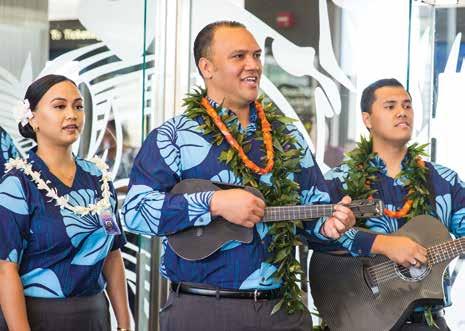
Hawaiian music is often part of our celebration during mahina ‘ōlelo Hawai‘i (Hawaiian-language month) in February, when we operate commemorative flights to share Hawai‘i’s native language with our guests.
Each February, in honor of mahina
‘ōlelo Hawai‘i (Hawaiian-language month), a team of Hawaiian Airlines employees share Hawai‘i’s native language with our guests on special flights. In what has become an annual tradition, our airport agents and flight crew surprise our guests with gate, boarding and cabin announcements in both English and ‘ōlelo Hawai‘i. Earlier this year, on our Hawaiian-language roundtrip flight between Honolulu and Boston, our crew also handed guests translation cards with useful phrases such as “I _____ na‘u ke ‘olu‘olu” (May I please have _____) and educational coloring sheets for keiki (children). During their layover, our employees visited the Peabody Essex Museum to pay homage to the Hawaiian god Kū, represented by a six-foot-plus wooden statue acquired by the museum in the mid-nineteenth century.
The ‘ōlelo Hawai‘i flights—which have flown to many destinations across our network, from our interisland routes to Tokyo, Portland and Las Vegas—are
among many ways we seek to perpetuate a language that was banned from Hawai‘i classrooms in the late 1800s but has flourished under a revitalization movement that began in the 1970s. A key figure behind the decades-long community effort to lift the language is Dr. Larry Kimura, a University of Hawai‘i–Hilo professor with whom we partnered in 2019 to establish our ‘ōlelo Hawai‘i certification program. We recognize qualified speakers with the Hae Hawai‘i (Hawai‘i state flag) imprinted on their name tags, joining other colleagues who are fluent in a variety of languages including Japanese, French, Korean and Samoan.
“When I started college, I was fortunate to receive the advice from a counselor that learning Hawaiian might be fun. I didn’t know it then, but I would come to fall in love with the language and get my master’s degree in ‘ōlelo Hawai‘i,” said Manako Tanaka, a member of our Community and Cultural Relations team who now teaches ‘ōlelo Hawai‘i classes to fellow employees.
“I am grateful to the kumu [teachers] who invested time in teaching me to know and love the language, and I try to bring that passion when engaging with employees about it. Hopefully, it becomes infectious and inspires them to continue on as well.”
Today, we honor Hawaiian culture in large and small aspects of our operations, including giving each aircraft in our fleet a Hawaiian name for native birds (on our Boeing 717s), stars or constellations used by Polynesian voyagers in celestial navigation (on our Airbus A330s and Boeing 787s) and native and culturally significant plants (on our Airbus A321neos). You can read Hawaiian on our seat numbers and other signage, hear it on our boarding music and safety video, and find it on our social media channels. Whenever we welcome a new aircraft, open an office or launch a route, we celebrate it with a traditional Hawaiian blessing.
Our support for the language also extends to our communities. Last year, we partnered with Awaiaulu to donate hundreds of copies of the book Ke Kumu Aupuni: The Foundation of Hawaiian Nationhood to thirty-four Hawaiianlanguage immersion schools, in addition to distributing it to our airport stations, hangar and office spaces. We also gifted $10,000 to Pūnana Leo o Lahaina, another immersion school, to help it rebuild facilities destroyed by the tragic West Maui wildfires.
As Hawai‘i’s airline, it is gratifying to leverage our business to normalize ‘ōlelo Hawai‘i in the workplace. The passion our teammates have for this beautiful language is inspiring, and it gives me hope that it will continue to thrive for generations to come.
From our ‘ohana to yours,
16
CONNECTING FLIGHT
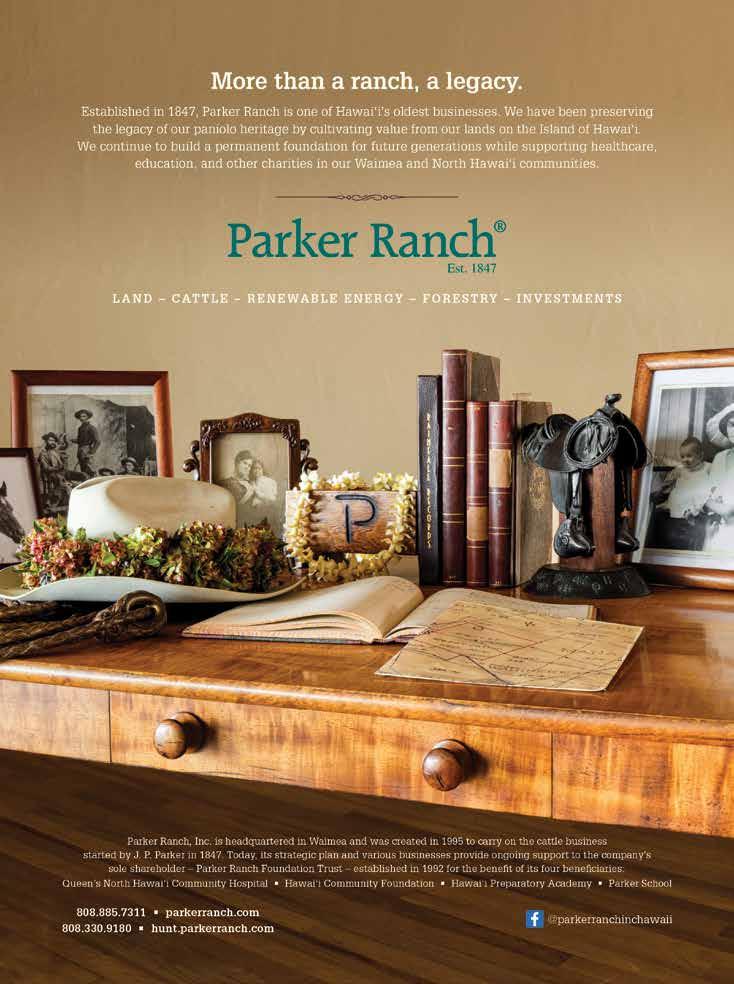

Experience Elevated Island Living
Homeowners can indulge in a variety of gathering and recreational spaces, including reservable barbecue cabanas, club rooms, and penthouse level private dining suites – one of which features its own karaoke lounge.
Beyond our community, residents enjoy easy access to a wealth of historic neighborhoods, schools, and recreational destinations such as Kapi‘olani Park, Waikīkī, and Kaimukī.

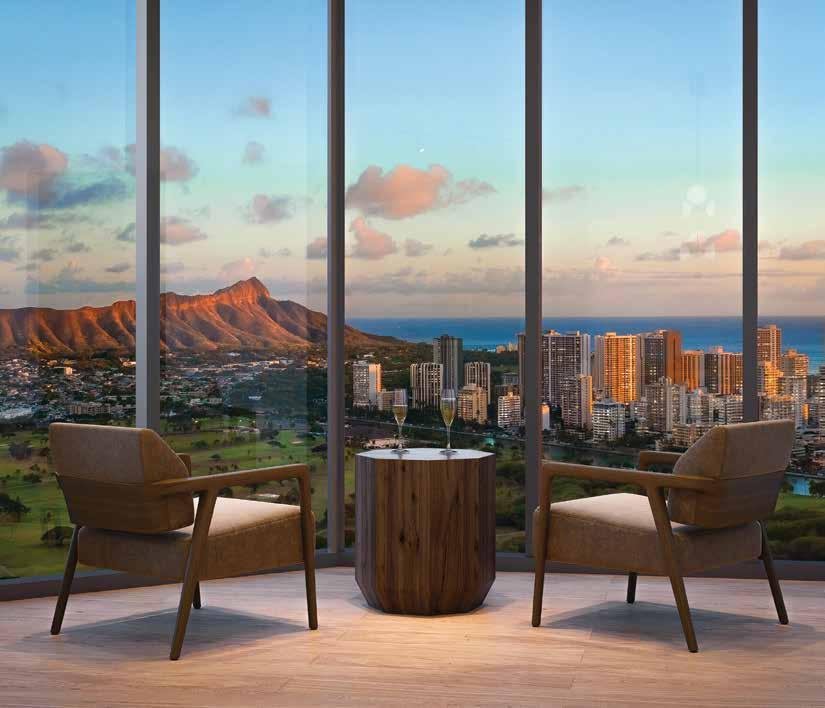

For more information, please visit our sales gallery. Ala Moana Center, Level 3 Ewa Wing 1450 Ala Moana Blvd. Suite 3505, Honolulu, Hawai‘i 96814 Starting Pricing: 1-bed: $680K 2-bed $890K 3-bed $980K www.kuileiplace.com | 808.751.2599 Kuilei Place is a proposed project that is being developed by 2599 Kapi‘olani, LLC and does not yet exist. All figures, facts, information, and prices included in this advertisement are approximate and subject to change at any time. Compass Hawaii, LLC is the exclusive broker designated for this project. Courtesy to qualifying brokers; see project broker for details. Connect with us on social: @kuileiplace | #KuileiPlace
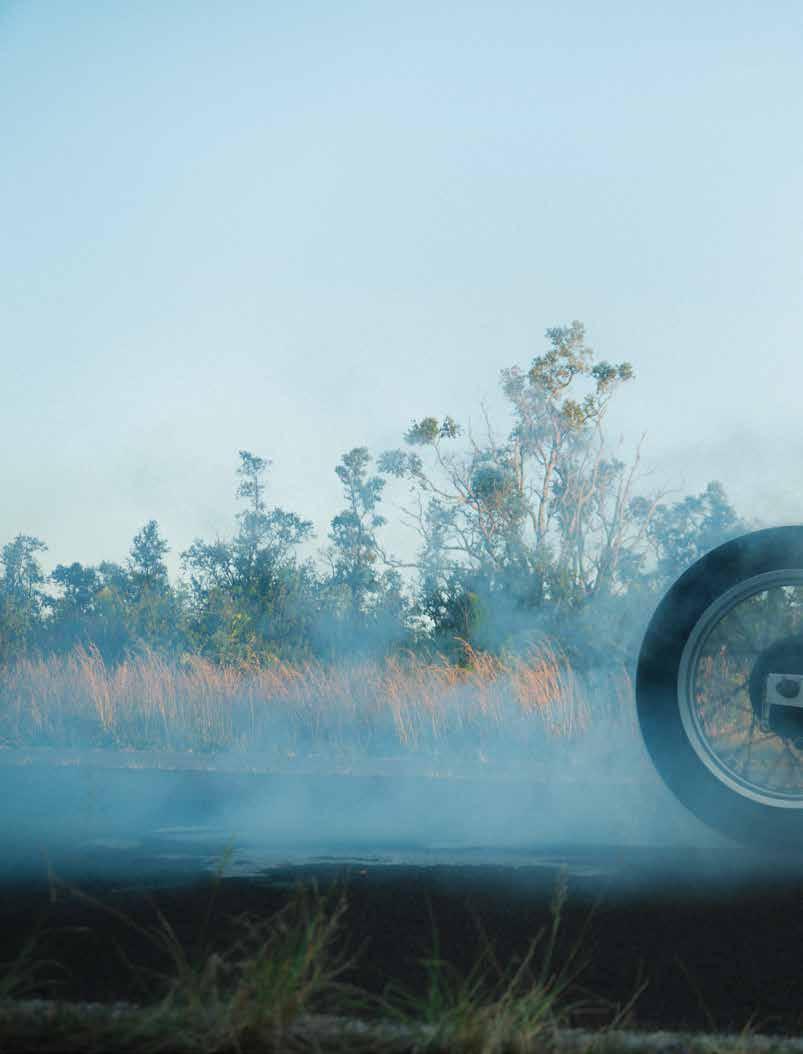
island intelligence
 STORY BY CONNER GORRY
STORY BY CONNER GORRY
Wheels of Fire

The Davis family admits they were terrified when they rolled up to Hilo Drag Strip for the first time. Understandably: They were gunning to race bicycles.
But these, obviously, are no regular bikes. Built on a shoestring as a pandemic diversion for his family, Neill C. Davis Jr. cobbled together these
gas-powered bikes from salvaged parts and cannibalized two-stroke engines. Neill, a self-proclaimed speed demon, his son Odin and wife Tanya, who got her first dirt bike at age four, knew their creation was fast. But how fast?
On Hawai‘i Island, speeds are officially measured at Hilo Drag Strip, a track sanctioned by the International
Hot Rod Association. “When they first came to the strip in 2021, everyone laughed. A bicycle with a motor? And they gotta pedal!” recalls veteran moped racer and performance engine builder Darin Akiyama. Luckily, Keith Aguiar of the Hawai‘i Drag Racing League headquartered at the county-owned facility, is an engine guy. “Retrofitting a bicycle with a chain-saw motor? The ingenuity is fantastic.” After consulting the rule book and calling in the vehicle inspector to assure safety compliance, the Davis bike got the green light.
“It was July 4 and the strip was packed. I’m at the starting line shaking. I knew nothing!” says Neill. After some quick coaching by drag racing videographer Mike Balbarino of 808 Fuel, the novice pedaled furiously to break inertia and let the bike fly; it clocked fifty mph. The crowd went wild and the Davis family was hooked.
Neill went on to retrofit a vintage Schwinn—christened Whirlwind—with a racing engine donated by Don Butler of Don’s Speed Shop, and Tanya, a daredevil with motocross racing in her blood, offered to jockey. “I spent the first two years learning, working my way up. By the 2023 season I knew what to do to compete,” she says. Tanya, a clever strategist, started winning dial-in competitions (the winning rider crosses the finish line closest to a predetermined time) against $50,000 motorcycles. “Those guys started getting upset,” says Aguiar, “losing to a lady, on a bike—it was kinda funny.”
After making modifications to Whirlwind for the 2024 season, Tanya will likely break her 55.82 mph record set in Hilo. And they want more: In September the family will travel to Utah’s Bonneville Salt Flats, where Tanya aims to break the land speed record for a motorized bicycle. “With that setup,” predicts Don Butler, “she will legitimately be the fastest person ever at Bonneville on a gas bike.”
22
Tanya Davis revs up on Whirlwind, a gas-powered bike built by her husband, Neill C. Davis Jr. (seen on pages 20-21), at Hilo Drag Strip. The 1970s Schwinn beach cruiser, modded with a seventy-five-cc engine, clocks over fifty-five mph.
RICKY-THOMAS SERIKAWA HAWAI‘I ISLAND INTELLIGENCE
PHOTOGRAPHY BY

 STORY BY MARTHA CHENG
STORY BY MARTHA CHENG
Not Just Your Po Po’s Game


For years Cassie Louie would drop her grandmother off at her weekly mahjong dates, but as much as Louie wanted to learn the game, her lack of Cantonese fluency deterred her. Then, on New Year’s Eve in 2022, her friend Dane Nakama came over and taught her how to play with her grandma. Louie was hooked. Soon after, she and Nakama started the monthly mahjong party now called Bad Luck Club, which in less than a year proved so popular that it outgrew the original space and moved to Arts & Letters Nu‘uanu, a bookstore and art gallery in Chinatown. Across the country, young people like Louie, who works in marketing, are introducing a new generation to mahjong (the name, in some Chinese dialects, means “sparrow”). From Los Angeles’ Mahjong Mistress to New York’s Green Tile Social Club, 20- and 30-somethings are finding their way to the four-person, tile-based game born in China in the
nineteenth century. In Honolulu, Bad Luck Club regularly draws about forty people to its events. While some grew up playing with their families (“It feels like every family here in Hawai‘i plays it,” says club regular Laura Zen), many at a recent event sat down at the square mahjong tables for the first time. More than one person says the pivotal round of mahjong in the movie Crazy Rich Asians sparked their interest.
But unlike that scene of power and intimidation, the vibe at Bad Luck Club, with nostalgic Cantopop playing over the soft clack of shuffling tiles, feels welcoming. The potluck table might include takeout dim sum and Panda Express, and people tote their mahjong tiles—in candy colors of jade green, lilac and fuchsia—in everything from formal wooden cases to Ziplocs. The name, Louie says, “is definitely a play on Joy Luck Club,” the best-selling book by Chinese American novelist Amy Tan,
“but it’s a little bit of the blind leading the blind here”— Louie and some of the other teachers are themselves relatively new to the game. “We’re probably not playing it as perfectly as our ancestors would have liked, but this space is safe for everyone to play their own way.”
Part of the impetus in starting the club is that for the younger generation, Louie says, “mahjong has lived inside of individual families and not so much between friends, so it’s also about making friends through mahjong.” Being a relatively fast-paced four-player game, mahjong is social and keeps people off their phones. “It’s a different way to connect and meet new people, without the awkward conversations,” said newcomer Erika Lee. “It’s more fun than just getting a drink at the bar.”
25
O‘AHU INTELLIGENCE
Long a stalwart among Chinese grandmas and the Boca Raton retiree set, mahjong is making a comeback among Millennials and Gen Z. Above, members of the Bad Luck Club gather for not-so-cutthroat play at Arts & Letters Nu‘uanu bookstore in, appropriately, Chinatown.
@HIBADLUCKCLUB
PHOTOGRAPHY BY MATT MALLAMS
STORY BY MADELEINE HILL
Disappearing Act
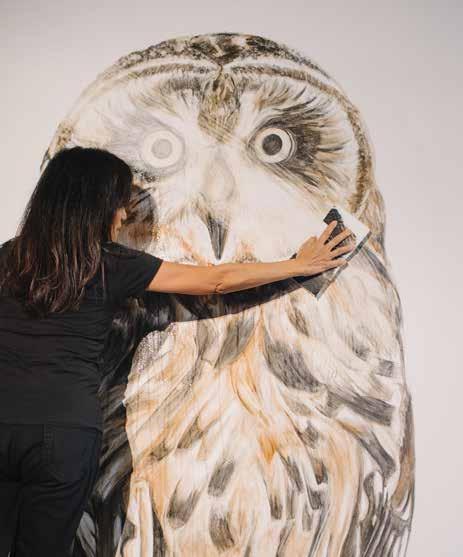
In 2020, reeling from the news of the Australian wildfires and isolated from loved ones due to the pandemic, Jana Ireijo began questioning her purpose.
“The world is just on fire. Art doesn’t even make sense anymore,” the artist and Kaimukī resident recalls thinking.
“What am I doing here? What does it mean?” Ireijo, born on Hawai‘i Island and raised on Maui and in California,
was especially heartbroken about the koala bears that couldn’t escape the fires. She decided to use her art to express her grief.
On a wall in downtown Westport, Connecticut, where she was living at the time, Ireijo painted a mural of a koala using charcoal from the bush fires that a friend sent. Three other artists participated as well, each painting a
different endangered species. When it rained, Ireijo’s koala washed away, leaving tear-like streaks and highlighting our mutual connection through the natural world. That project inspired Ireijo to make more “vanishing murals.”
In 2021, The Nature Conservancy commissioned her to paint a mural for the Maui Ocean Center. The illustration of a young woman, modeled on her teenage niece, Ava, had hair made of salmon-colored coral against a turquoise background, surrounded by other marine life in vibrant rose, gold, emerald and red. Ireijo used non-permanent chalk—the color has faded over time, leaving behind only white, figuratively enacting how coral bleaching is destroying the reefs along Hawai‘i’s coasts.
Most recently, Kahilu Theatre on Hawai‘i Island exhibited “Vanishing Pueo,” Ireijo’s mural of the native Hawaiian short-eared owl. She used charcoal from wildfires that swept across Hawai‘i Island in August 2023, red dirt to paint the bird’s ash- and rust-colored feathers, yellow pigment from local ‘ōlena (turmeric) and hibiscus flower stamens for its amber eyes and water from nearby Waikoloa Stream to moisten the pigments. Ireijo envisioned the owl rising out of the earth with a message of impermanence and then returning to earth—on March 3, the last day of the exhibit, Ireijo washed the mural away
Other vanishing murals include renderings of manta rays, whale sharks and portraits. Ireijo said she loves all her illustrations, but Nani, a humpback whale she’s drawn repeatedly, is her favorite. Is it painful to watch something she loves disappear? It doesn’t completely, she says. “I feel like I’m holding on to it at the same time. When I wash it away, there’s always a ghost imprint. It’s very therapeutic. During these past few years, it’s just easier to realize things change. We can be a part of the future but at the same time letting go.”
26
PHOTOGRAPHY BY MEGAN SPELMAN O‘AHU INTELLIGENCE
VANISHINGMURALS.COM
Artist Jana Ireijo wipes away “Vanishing Pueo” at Kahilu Theatre on Hawai‘i Island, one of a series of temporary works made from natural, locally available materials. Like Buddhist sand mandalas, Ireijo’s vanishing murals are meditations on impermanence.
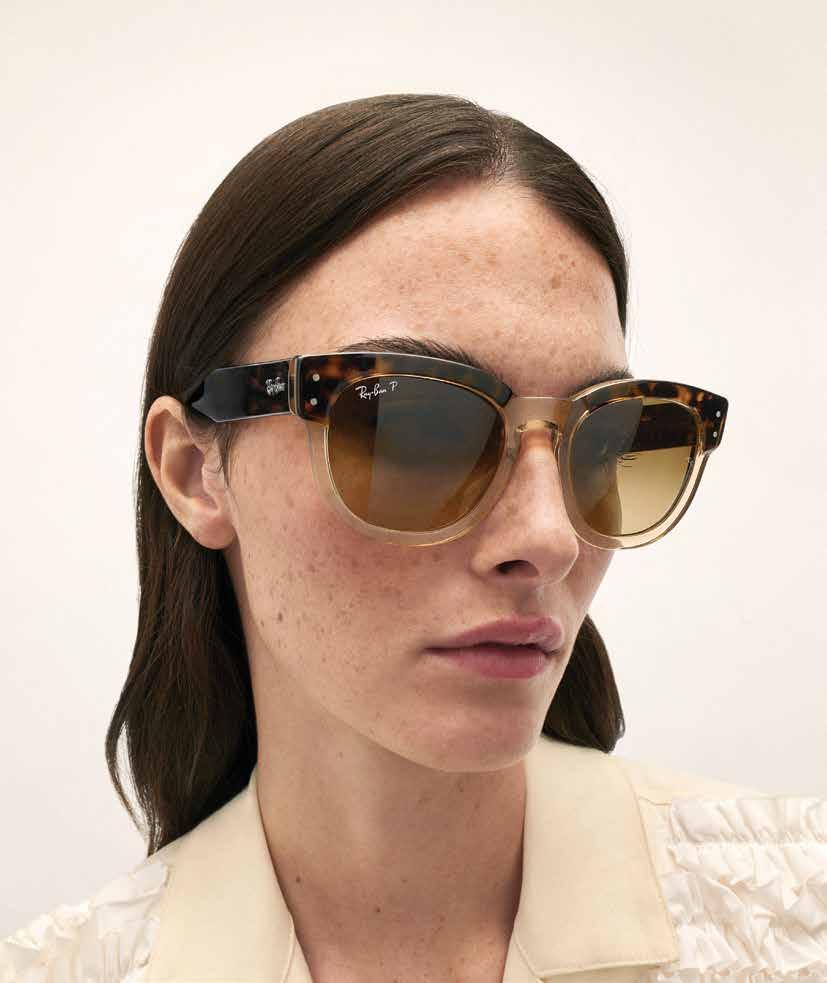
Every shade of you Ala Moana Center 808.941.8800
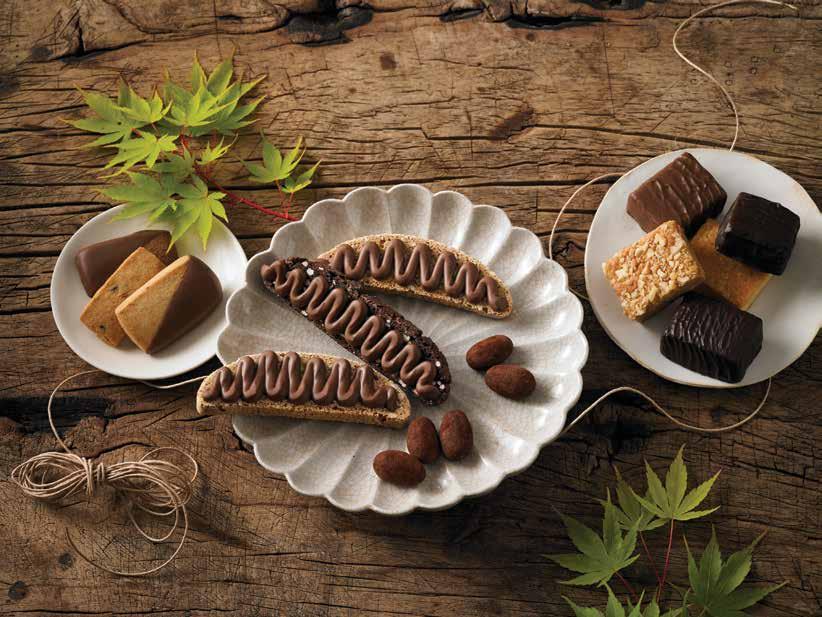


King Corm
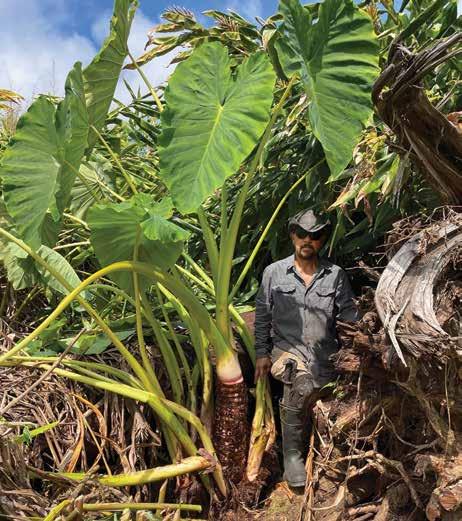
Then South Kona farmer Clarence Medeiros planted huli (taro stems) around Thanksgiving of 2020, he never thought one of them would become the largest taro he’d ever grown—or that anyone had ever grown. Fifteen months later it towered above the eight-foot-tall white ginger. Its Jurassic-size leaves were big enough for the 5’6” farmer to wrap himself in. Clarence suspected the corm, or tuber, would be a “big boy.” On February 21, 2022, Clarence, wife Nellie, their grandson Lincoln and Hawai‘i ‘Ulu Cooperative facility
manager Holokai Brown harvested the mighty corm. It took Clarence and Lincoln twenty minutes to dig it out.
To weigh it they drove to the Hawai‘i ‘Ulu Cooperative’s Honalo facility, where more than 150 farmers bring their harvest—staples like ‘ulu (breadfruit), kalo (taro), ‘uala (sweet potato), pala‘ai (squash)—to be processed and sold. While twenty-pounders weren’t unusual for Clarence, this kalo tipped the scale at a whopping fifty pounds.
Clarence, 72, comes from a long line of farmers. He’s the fifth great-grandson STORY BY CATHARINE LO GRIFFIN
PHOTOGRAPHY COURTESY CLARENCE
MEDEIROS / HAWAI‘I ‘ULU COOPERATIVE
of Don Francisco de Paula Marín, who planted Hawai‘i’s first vineyard (after which Vineyard Street is named) and introduced coffee, pineapple, mango and many other plants to the Islands. Clarence has been growing kalo that’s been passed down through the generations since he was a kid. His father had a poi factory; his dad and great-uncles taught him to farm in arid, sun-blasted Kona. “We use the morning dew, the black dirt and whatever rains we’re lucky to get—and hopefully Maunaloa and Kīlauea no erupt and don’t make vog and acid rain,” he says.
The “big boy” kalo is a South Kona variety called lehua pākē, also called ‘iliuaua (“tough hide”). Its thick rind is impenetrable to insects, and its soft pulp makes it ideal for palu (fish bait). Clarence used to trade it with traditional ‘ōpelu (mackerel scad) fishermen, who would mash it with pumpkin to feed the ‘ōpelu in their fishing grounds. For a few months of the year, ‘ōpelu fishing was kapu (restricted) so the fish could fatten up. Clarence’s grandfather, a kalo farmer and fisherman, was the konohiki (resource manager) at Hōnaunau, where he lived. “My mom told me that if someone broke the kapu,” Clarence says, “he was waiting on the beach to literally enforce the kapu with dirty lickings.”
In September 2023, Guinness World Records certified that the giant corm the Medeiroses harvested was officially the world’s heaviest taro, weighing in at 49.97 pounds. The previous record holder was a measly seven-pounder from China. “We’ve traveled to Europe and Asia, China and Portugal. I’ve seen taro all over this world. They have taro in Kansas City and Florida,” Clarence says. “This one is the biggest. It’s good for America, good for Hawai‘i, good for Kona.”
What became of the big boy?
Clarence handed it over to the co-op, which processed 287,000 pounds of locally grown food last year. “Somebody ate the world’s biggest taro,” Clarence laughs, “and didn’t even know it.”
29
HAWAI‘I ISLAND INTELLIGENCE
Hawai‘i Island farmer Clarence Medeiros is the proud papa of the world’s heaviest taro—at 49.97 pounds, it holds the Guinness World Record.
STORY BY KATIE YOUNG YAMANAKA
Pigments of the Imagination

If Michi Marsh, a competitive freediver and watercolor artist, hadn’t broken her back, she might never have learned to make watercolors. Unable to walk for seven months after a boating accident in 2017, she couldn’t paint, so she Googled, researching the history of watercolors from cave art to Egyptian hieroglyphs. Marsh spent her recovery time tweaking traditional Renaissance paint recipes, making her own hues from rock and mineral powders and natural colloid
agents like gum arabic from the acacia tree. She weighed minuscule amounts of powdered pigments, binding each color by hand on a marble slab using a glass muller—a labor-intensive process that takes up to an hour of mulling for a single color. “Before commercial paints were a thing, all artists made their own paint,” says Marsh, who started her retail wholesale art business, The Ocean Paper, in 2016. “It was an integral part of learning about color
theory and painting. Most people don’t do it anymore.”
When Marsh was just getting back on her feet in 2018, she and her business partner, Josh Meneley, opened a storefront on Kaua‘i. She featured her paintings and cards, throwing a couple of handmade hues on the shelf as an afterthought. Muted colors and plenty of pastels lent themselves to the soft, dreamy quality of her Hawai‘i landscapes and seascapes. “At first I was really nervous because my paints weren’t like the big brands,” she says. “When you open a palette of store-bought watercolors, they are crazy bright. If you paint those colors straight out of the tube, it will look like a little kid painted it because artists are expected to mix the colors themselves. A lot of people don’t know how to do that, though, and it becomes too complicated.” Marsh’s toned-down paints took the guesswork out of mixing, and customers loved them. Through word of mouth and a few fateful encounters, Marsh’s watercolors quickly gained a dedicated following around the world with both professional and hobby artists. Marsh started with twenty-four colors. That first month, she released 1,600 half-pans of paint online at $10-$12 apiece. They sold out in minutes. At one point she considered mechanizing the operation, but, she says, there’s really no automated way to create the same buttery quality of handmade paints.
Though COVID forced the closure of The Ocean Paper’s storefront in 2020, paint sales continued to grow online. Marsh now features 140 different colors in The Ocean Paper paint line, all handmulled by Marsh and Meneley. Artists can buy watercolor sets like “Old Hawai‘i,” a six-color palette inspired by the dusty, red-dirt roads of Kaua‘i towns like Waimea and Hanapēpē, or the twelvecolor “Kelp + Urchin” set inspired by the kelp forests of temperate oceans.
30
Kaji Bross paints a landscape using handmade watercolors from The Ocean Paper. Owner Michi Marsh started making her own paints during the pandemic, and they’ve since become sought-after by artists the world over.
KAUA‘I INTELLIGENCE
PHOTOGRAPHY BY ASHLEY UPTAIN
THEOCEANPAPER.COM @THEOCEANPAPER
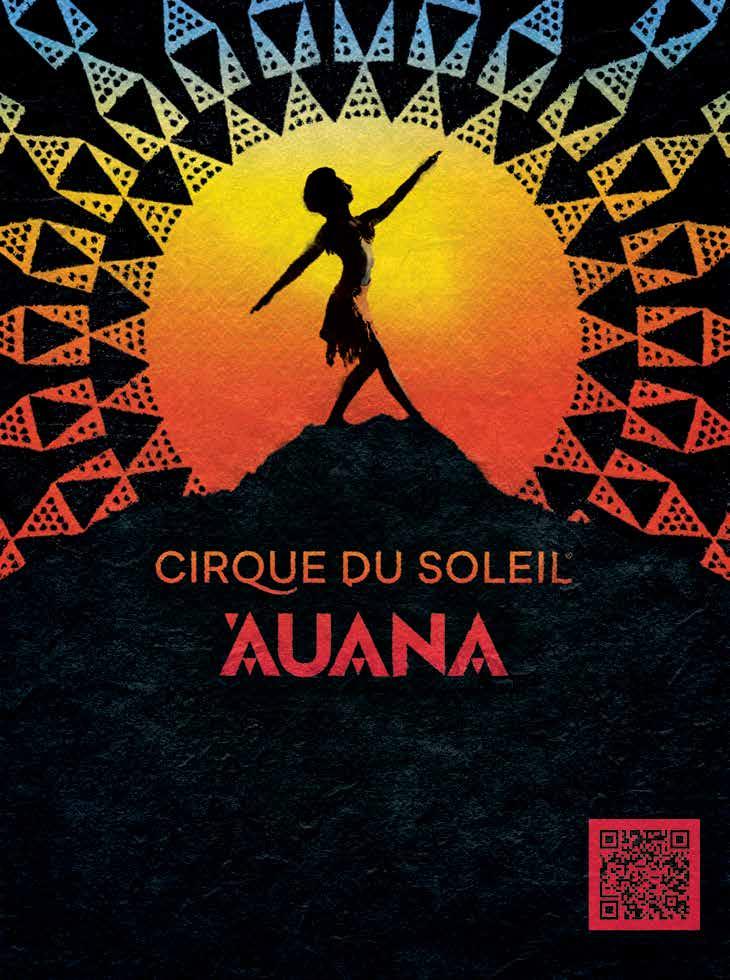
PERFORMANCES BEGIN LATE 2024 CIRQUEDUSOLEIL.COM/HAWAII SCAN FOR TICKETS A NEW SUN RISES
STORY BY KATHLEEN WONG
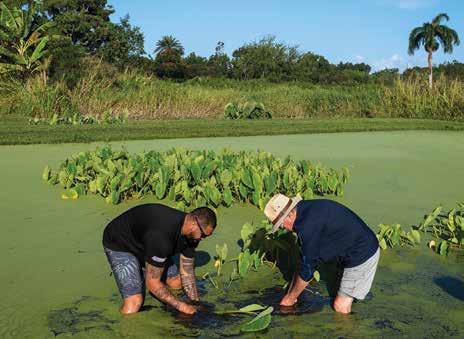

Evan Mokuahi Hayes looks up at the tree, a towering pine on ‘Iolani Palace’s front lawn. It’s the only pine on the property, but few might notice that unless someone pointed it out. “This was planted by Prince Kūhiō’s wife around 1900,” Hayes says. “This served as the Christmas tree of Hawai‘i until about 1942. If we were born in the 1920s, this is where we’d come and hang out.”
Hayes then points out a humble gate at the back of the palace grounds, installed so that John Dominis, Queen Lili‘uokalani’s husband, could enter the palace without fanfare. Dominis died before the gate could be completed—it’s still there, still locked and never used.
Such details are just a taste of Hayes’s deep knowledge about Hawaiian history, knowledge he shares with guests on his Ho‘omau O‘ahu Tours. “I spend a lot of time in the State Archives,” he says, gesturing to the 1950s-era building behind ‘Iolani Palace, where Hawai‘i’s historical records
are preserved. “I love our culture. I’m so passionate about it.”
Descended both from members of the palace’s royal guard and from Waikīkī beach boys, Hayes launched Ho‘omau in December, one of the only Native Hawaiian-owned tour companies in the state. This afternoon he’s leading guests through ‘Iolani Palace, part of his Mo‘olelo Historic Downtown Tour, a two-hour-long immersion in the cultural heritage of Honolulu’s city center, including Kawaiaha‘o Church and the Hawai‘i State Judiciary.
Hayes never saw himself in the tourism industry, he says. After finishing college in Michigan, he moved back to O‘ahu and took a job with a Germanowned tour company as a way to avoid working in an office. But the script he was handed felt disingenuous; he wanted to educate guests beyond conventional guidebook narratives of Hawaiian history. “I was like, I’m not saying any of this,” he recalls, and instead opted to share his
own knowledge of Hawaiian culture and history—which has had its upheavals. “I’m not going to sugarcoat the history because it might make people feel uncomfortable,” he says. “It’s our job to educate, because we can’t go back and change it.”
Ho‘omau currently offers two other tours: a circle-island cultural tour that travels east from Kap‘iolani Park to the North Shore, and a newly revealed “Mālama Experience,” where guests work in a lo‘i kalo (taro patch) or loko i‘a (fishpond) at various locations, including Nā Mea Kupono, a learning center in Waialua. A portion of proceeds from Ho‘omau’s tours go back to the cultural sites, farms and practitioners they visit.
“People are curious about Hawai‘i; while everyone knows about this place, not many really do,” he says. “There’s so much deep history here, and people are craving authenticity. We’re trying to flip the industry, and that’s exciting.”
32
HOOMAUOAHU.COM
Ho‘omau O‘ahu Tours founder Evan Mokuahi Hayes (seen above left, at left) shows a guest how to harvest taro at Nā Mea Kūpono Learning Center, one of the stops on Hayes’ Mālama Experience Tour. Above right, the Hawaiian royal coat of arms at ‘Iolani Palace, part of Hayes’ Mo‘olelo Historic Downtown Tour. Hayes started Ho‘omau to give visitors a more culturally authentic experience of Hawai‘i and its history.
PHOTOGRAPHY BY CABLE HOOVER O‘AHU INTELLIGENCE
A Walk through Time

For six decades, we’ve had the honor of welcoming guests to our timeless and luxurious oasis. Please join us for exciting events and festivities throughout 2024 as we celebrate our 60th Diamond Anniversary. Mahalo for making us your home, away from home and helping to shape our enduring legacy.


Visit KahalaResort.com for Events & Specials
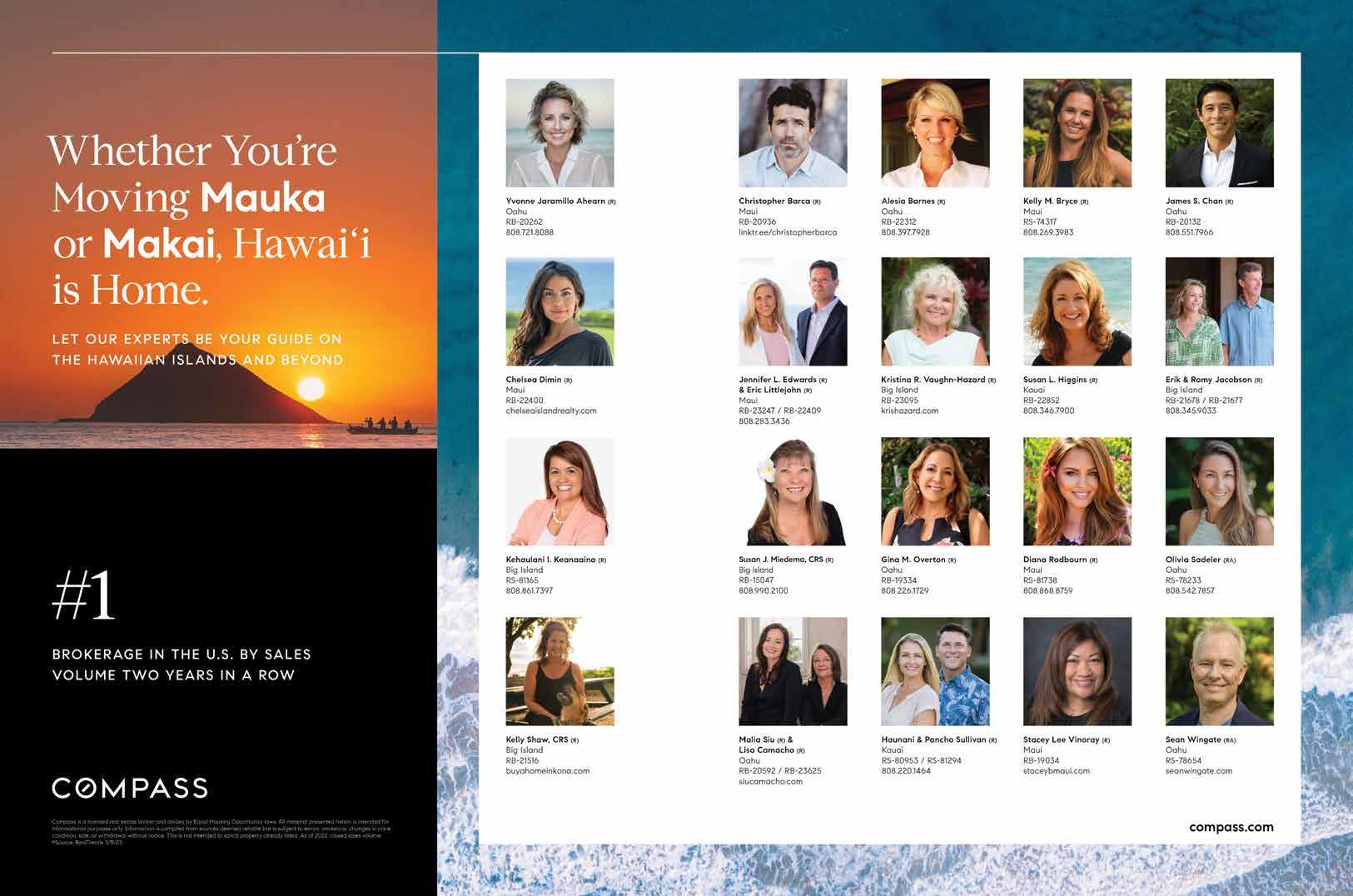


departments & features
 STORY BY CONNER GORRY
STORY BY CONNER GORRY
The Other Side of Volcanoes
Exploring the Kahuku Unit of Hawai‘i Volcanoes National Park
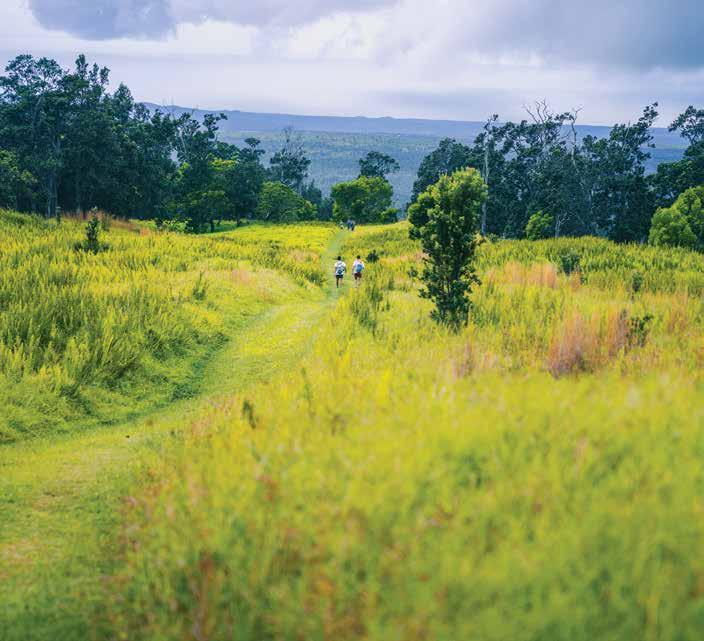
PHOTOGRAPHY BY ANDREW RICHARD HARA 38 DEPARTMENT





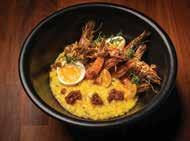





VISIT ROYYAMAGUCHI.COM FOR MENUS FOR LOCATION RESERVATION INFORMATION PLEASE VISIT ROYYAMAGUCHI.COM PAST IS PRESENT Whether you're drawn by the allure of plantation era flavors or the excitement of contemporary culinary innovations, Eating House 1849 by Chef Roy Yamaguchi promises an unforgettable dining experience where Hawaii's past and present culinary worlds collide, creating a taste of the islands that is both timeless & bold. WAIKIKI, OAHU | POIPU, KAUAI scan f menus and reservations ROY YAMAGUCHI JAMES BEARD AWARD-WINNING CHEF
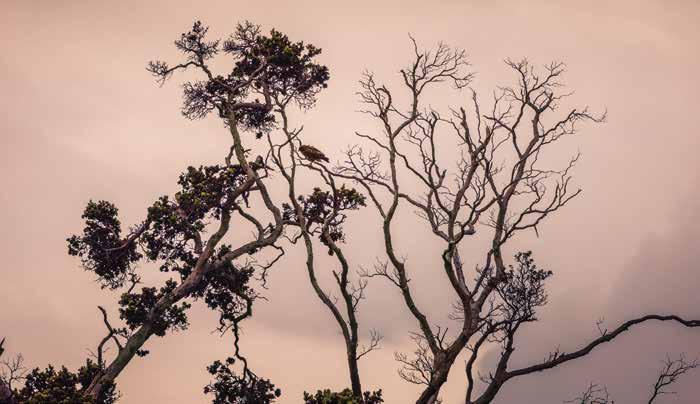
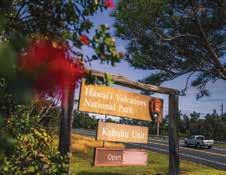
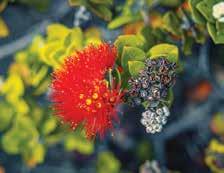
Hawai‘i Volcanoes National Park, with its two active volcanoes where lava often flows, happy-face spiders grinning from the rainforest and sulfuric vents lending a surreal, postapocalyptic feel, is a bucket-list destination drawing 1.6 million visitors a year. Most come to explore the lava tubes and take in the glow at Halema‘uma‘u. Little do most of these visitors know that just an hour down the road lies the park’s Kahuku Unit, a secret held in plain sight. Over decades and in collaboration with many partners, HVNP has worked doggedly to acquire this parcel and preserve its natural and cultural resources. Visitors are going to need a bigger bucket.
The acquisition of three parcels over the past twenty-one years—the Kahuku Unit (2003), the Great Crack (2018) and recently Ala Wai‘i (2022)— has added more than 120,000 acres to Hawai‘i Volcanoes National Park. These acquisitions lie entirely within the ahupua‘a (traditional land division) of Kahuku, the biggest ahupua‘a in the state, located in the jealously guarded Ka‘ū district. The people’s connection to the land runs deep on Hawai‘i Island’s remote southern wedge: Bumper stickers and T-shirts sold here read, “If you’re not from Ka‘ū, sucks to be you” and “Keep Ka‘ū Country.” The slogans lay bare
ABOVE / An endemic ‘io (Hawaiian hawk) perches in an ‘ōhi‘a tree in the Kahuku Unit.
LEFT / After the Kahuku Unit closes at 4 p.m., visitors often head to the Great Crack (seen on pages 36–37 for a sunset hike.
RIGHT / The flower of the endemic ‘ōhi‘a lehua.
residents’ pride in their ‘āina (land) but also their fears for its future. Those fears are not misplaced. Developers tried for decades to capitalize on Ka‘ū’s eighty miles of mostly untouched coastline. Indeed, each Ka‘ū acre added to the park was once privately held, making these acquisitions costly and slow. The 1,951 acres within the Great Crack parcel, first identified in 1975, took nearly half a century for the park to acquire. The Kahuku Unit, meanwhile, cost a whopping $22 million, purchased with the help of The Nature Conservancy. It took multiagency action by HVNP, the Three Mountain Alliance watershed partnership, the Trust for
40 DEPARTMENT: THE OTHER SIDE OF VOLCANOES
OPENING PAGE / Miles of trails beckon hikers in the less frequented Kahuku Unit of Hawai‘i Volcanoes National Park.


out for
Public Land and others to secure these three parcels.
How to manage them was another matter. Park administrators knew they had to tap into Ka‘ū’s generational knowledge to design a sustainable plan, one that honors the park’s purpose to “perpetuate endemic Hawaiian ecosystems and the traditional Hawaiian culture connected to these landscapes.” From ancient petroglyphs and endangered endemic plants to sacred shrines and Pahu Manamana o ‘Umi—a stone structure believed to have served as a compass for ancient navigators— these parcels tick all requisite boxes.
“These acquisitions required a lengthy planning process, including many thoughtful conversations with the Ka‘ū community,” says HVNP superintendent Rhonda Loh. “What came through loud and clear is that people love these areas, want to be actively involved in stewardship and worry about overcrowding. Their priority is to maintain a rural environment that provides intimate, immersive experiences.”
Judging from a recent Saturday at the Kahuku Unit, the furthest along of the three parcels in its development process, the plan is working. The collaboration between the community and the park is palpable
here, where monthly coffee talks are often standing-room-only. At one recent event, park volunteers poured coffee and scrambled for additional chairs while locals like Clyde Boysen shared personal stories and photos of the day’s topic, ‘io, the endangered Hawaiian hawk. “‘Io forage near our home, so we came specifically for this talk, but we love this part of the park,” Boysen says. “There’s a serenity and beauty to nature on the edge, in recovery, like you see here at Kahuku.”
It’s no easy task restoring this land after 150 years of cattle ranching decimated critical habitat for endangered birds like ‘io and ‘ua‘u (Hawaiian petrel), and plants including ‘āhinahina (Ka‘ū silversword) and hō‘awa (royal cheesewood). Some species, like ‘io, are found only on Hawai‘i Island, while others, like the Ka‘ū silversword, are even more specific; it’s found only in Kahuku. It’s already too late for ‘alalā, the Hawaiian crow, officially extinct in the wild after the last populations disappeared from Kahuku in the 1970s as more pastureland was created. (Several attempts to reintroduce captivebred ‘alalā on Hawai‘i Island failed—‘io preyed on the crows.) Once the law of diminishing returns beset ranching, desperate ranchers introduced mouflon sheep and bison for private hunting safaris. Shrinking habitat, vanishing species and ungulates: The Kahuku Unit

was a pending ecological disaster when the park assumed stewardship in 2003.
“Our kūpuna tell us it’s part of a cycle. It’s not a disaster, it’s a hulihia event,” says Sierra McDaniel, natural resources program manager at HVNP. “In that cycle, hulihia is always followed by kūlia—the recovery and restoration stage.” Implicit in this model of upheaval followed by rejuvenation is the impossibility to restore landscapes— natural and ethnographic—to precisely as they were before. “Given that we have all these invasive species, that we’ve had extinctions over the past two hundred years, the challenge is understanding the potential for this landscape now. Our strategy is to facilitate restoration of the forest, provide habitat and support high biodiversity.”
The first step in the strategy: Get rid of the cows. It took seven years to relocate the cattle to Kahua Ranch in Kohala. The second step was fencing out ungulates (and the occasional human), which damage the fragile ecosystem. By the time the park acquired the Kahuku Unit, the original eleven mouflon sheep brought in for trophy hunting had multiplied to three thousand. To give native species their best shot for survival, the entire unit was fenced in, and the remaining ungulates were culled by park staff and volunteer hunters from the community.
42 DEPARTMENT: THE OTHER SIDE OF VOLCANOES
“I took photos of the Pu‘u o Lokuana Cinder Cone, inviting passing hikers to vote on which one I should paint,” says HVNP artist in residence Dianna Miller, seen above left showing one of her works in progress at the Kahuku Unit’s monthly Coffee Talk event. Above right, Miller heads
a morning hike on the Pu‘u o Lokuana Trail.

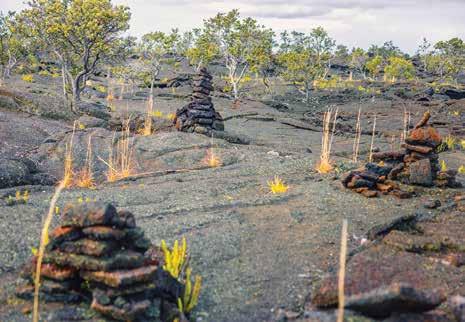
In 2014, fence maintenance became an urgent priority when a fungal disease infected trees in the Kahuku Unit and elsewhere, causing rapid ‘ōhi‘a death (ROD). Known as a “keystone species” in Hawaiian culture and ecology, the endemic ‘ōhi‘a tree is essential for maintaining a balanced ecosystem and a healthy watershed. The nectar from its flowers are an important food source for endangered native birds, honeycreepers like ‘i‘iwi and ‘amakihi. Research from 2021 found that fenced areas were two to sixty-nine times less likely to have suspected ROD than unfenced. “Habitat prediction models for the end of the century indicate that Kahuku will be among the last, best spots for forest bird survival on the planet, so it’s important to protect this area from ROD. This needs to remain a viable place for those species when the time comes,” says McDaniel. She confirms that fencing is the park’s biggest, most expensive challenge.
The final piece of the forest restoration strategy entails beating back the aggressively invasive kikuyu grass on which the cows grazed to study how this land was used traditionally and what species thrived here. Scientists, like developers before them, were anxious to dig into the Kahuku ahupua‘a, suspecting major discoveries lie beneath
all that grass. “For decades, researchers knew there was an agricultural field system in Ka‘ū similar to the ones in Kohala and Kona but didn’t know where until the park acquired this parcel,” says Summer Roper Todd, HVNP cultural resources manager.
Bringing modern technology, paleobotany and geographic information system prediction models to bear, researchers from the University of Hawai‘i at Mānoa, in partnership with the park, hit the archaeological jackpot. They discovered a thirty-seven-thousandacre agricultural field system, believed to be the largest in the Pacific. “This system is huge,” says Roper Todd, “with several structures and miles of rock walls mauka to makai [mountain to sea] dating from the 1400s, indicating systematized farming of sweet potato that supported an expanding population in this area.”
Valuable pre-contact botanical and cultural information gathered through soil and fossil plant analysis is being applied to the park’s restoration plan. Atop the kuaiwi (rock walls) below which the ‘uala (sweet potato) grew, ancient Hawaiians planted kō (sugarcane)—when rain combined with Ka‘ū’s notorious winds, it shimmied through the cane to create a natural sprinkler system. The ‘ōhi‘a forests complemented this human-
engineered microclimate by gathering scarce moisture, making it available for agriculture. “The evidence is right here for a forest restoration roadmap,” says McDaniel. “‘Ōhi‘a and koa grew here as well as other native trees, including lama [ebony], halapepe, alahe‘e and ‘iliahi [Hawaiian sandalwood].”
Other efforts are focused on preserving critically endangered species. By the late 1990s, habitat damage had pushed the Ka‘ū silversword to the brink of extinction. Not the average plant, this species grows only on the slopes of Mauna Loa and takes between ten and thirty years to flower, after which it dies. Knowing this, Junior Molcilio, a paniolo (cowboy) at Kahuku in its ranching heyday, lugged fencing up to five thousand feet, where silversword thrives, and erected a three-acre enclosure to protect the world’s last five hundred specimens.
“We have Molcilio to thank for the survival of the species at Kahuku,” says McDaniel. “When the park began stewarding Kahuku, we rebuilt his fence and collected wild ‘āhinahina to save the remnant populations.” These specimens were moved to the Volcano Rare Plant Facility and cross-pollinated to maximize genetic diversity; the seeds were planted at Kahuku. Recently, a helicopter carried two hundred silverswords to establish a new population site at seven thousand feet. “Our goal is to restore Ka‘ū silversword to this entire area,” says McDaniel. “Spreading them out among several sites is key for protecting them from future lava flows.”
Protecting
sensitive species and restoring habitat are only part of a national park’s mission. There’s also the need for responsible public access. A well-maintained trail system of varying difficulty and terrain is part of the Kahuku Unit’s charm: Some trails allow cyclists and dogs, and several routes can be combined to provide a robust day hike. Not a hiker? Not a problem. A good portion of the Kahuku Unit is four-wheeldrive accessible, giving visitors of all ages and abilities the chance to behold kūlia in action among some of the planet’s rarest life forms. While bucket-list traffic clogs the Kīlauea summit, at Kahuku it’s rare to see another soul. Even on busy days this area is peaceful, with ‘io soaring
44 DEPARTMENT: THE OTHER SIDE OF VOLCANOES
Stone ahu (cairns) built by the National Park Service guide the way across the 1868 lava flow on the Kahuku Unit’s Pu‘u o Lokuana Trail. (Visitors are strongly discouraged from building ahu of their own, in part because they could lead hikers astray on otherwise umarked trails.)


An incomparable collection of Hawaiian and Island lifestyle jewelry O‘AHU • MAUI • K AUA‘I • BIG ISLAND OF HAWAI‘I • NCL PRIDE OF AMERICA BELLEVUE • BOSTON • CH ICAGO • DALLAS • DENVER • L AS VEGAS • NEW YORK ORLANDO • PHILADELPHIA • PLEASANTON • PORTLAND • ROSEVILLE • SAN DIEGO SAN FRANCISCO • SAN JOSE • WASHINGTON, D.C. NaHoku.com • 1- 800 -260 -3912 HAWAII’S BEST People’s Choice Awards The Star-Advertiser 2014 – 2023 NAHO-39147_Kabana_MantaRay_Pink_HanaHou__JuneJuly2024_7.3x9.8.indd 1 3/14/24 5:34 PM

At the end of the steep trail to the Kahuku Unit’s pit crater, native habitat thrives on sheer, 250-foot walls and a forest rises from the inaccessible depths. Protected from hoofed ungulates and humans, endangered and rare species offer a glimpse into an ancient Hawaiian landscape.
overhead, endangered birdsong bouncing from the walls of a forested pit crater and uninterrupted views of the Ka‘ū coast. Visitors are urged to kōkua (help) prevent ROD by brushing off and spraying boots at trailhead quarantine stations.
An interim access plan is unfolding for the sixteen-thousand-acre makai side of the Kahuku ahupua‘a, purchased by the Trust for Public Lands and transferred to the park in 2022. Known as the Kahuku-Pōhue parcel, it is a natural and cultural lodestone, peppered with petroglyphs, fishing shrines, burial sites and anchialine ponds—vital habitat for ‘ōpae ‘ula, Hawaiian red shrimp. A section of the Ala Kahakai National Historic Trail shares the coastline here with the largest recorded ancient abrader stone quarry in the state, and endangered monk seals and hawksbill turtles haul out on Kahuku Beach to rest and nest.
A well-kept secret for generations of Ka‘ū families and cultural practitioners— particularly the pristine beach and coastal fishing grounds—access to this parcel is currently restricted, as it requires crossing private property among sensitive sacred sites. To help guide stewardship and access decisions, the park, together with the Hawai‘i Alliance for Community Based Economic
Development, sought local input. “We heard many concerns about overuse at these heavily attended meetings. We want to proceed cautiously while at the same time protecting the area’s resources,” says Loh.
Community input led to actions now underway to provide managed access to the Kahuku-Pōhue parcel. First, pedestrian-only, day access will be permitted via a short connector trail being built by experts in traditional Hawaiian trail building and masonry from Pu‘ukoholā Heiau National Historic Site; this trail will be entirely within park boundaries. Also necessary for public access is the installation of composting toilets, made possible by a donation from the Friends of Hawai‘i Volcanoes National Park. “For years there was talk about public access to Kahuku Beach. It’s exciting that the park is finally making it happen,” says resident Marri Werly.
Other well-kept Ka‘ū secrets acquired by HVNP are the Great Crack and Ala Wai‘i, two contiguous parcels totaling 4,700 acres. These areas are cherished by residents for their rugged hiking opportunities through the Ka‘ū Desert Wilderness to the coastline. As hard to fathom as it is to photograph, the Great Crack is an eight-mile-long fissure
measuring fifty feet wide and sixty-six feet deep in places. Odd formations including lava tubes and cinder cones dot the surreal landscape. “The geology and nature out here are awesome—they speak to you,” says Ocean View resident and avid hiker Simone van Harten. Site planning for these two parcels is in its infancy—little is known about their cultural and natural heritage—and will be guided by future community input. “We’re working to control invasive fountain grass at the Great Crack, and preliminary archaeological surveys show there were seasonal villages and sacred sites throughout the area,” says McDaniel. One big question is how ancient Hawaiians used these parcels; another is what they were called. Ala Wai‘i, for instance, is the name of the last developer and is being used simply as a placeholder. To better understand this slice of the Kahuku ahupua‘a and reconnect people to the land, park managers are proposing a multidisciplinary archaeologicalanthropological study, hoping lineal descendants can fill in the blanks.
“There’s not a lot to do in Ka‘ū,” says park ranger Wendy Scott-Vance. “It makes me happy to see so many people enjoying this extraordinary area.” hh
46 DEPARTMENT: THE OTHER SIDE OF VOLCANOES
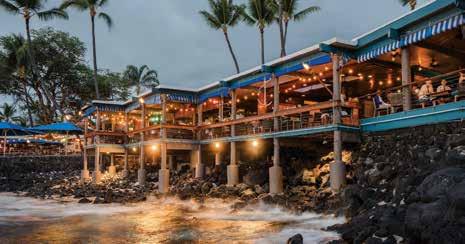
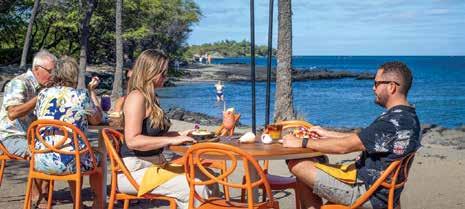
Savor Island style culinary creations from our collection of signature dishes, including fresh fish from our local waters. Every day our chefs go crazy with menu favorite Hook, Line and Sinker specials, delivering an ocean of flavors to your plate. Or try our signature sliced teriyaki steak, and don’t forget to sip and savor hand crafted cocktails to the sounds of live music.


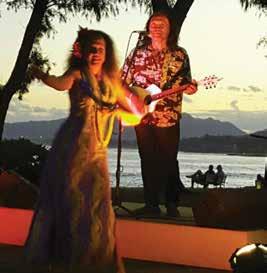









Always on the water’s edge, come celebrate life with us. KAMAAINA OWNED | OHANA OPERATED SINCE 1969 SIPSAVORSTAY.COM
ON THE ROCKS & HUGGO’S | KONA
LAVA LAVA BEACH CLUB | BIG ISLAND
LAVA LAVA BEACH CLUB | KAUAI
KAI EATS + DRINKS | KONA
Recorded History
STORY BY LARRY LIEBERMAN
BY JOHN HOOK
The Hawai‘i State Archives is digitizing the largest collection of Hawaiian music in the world
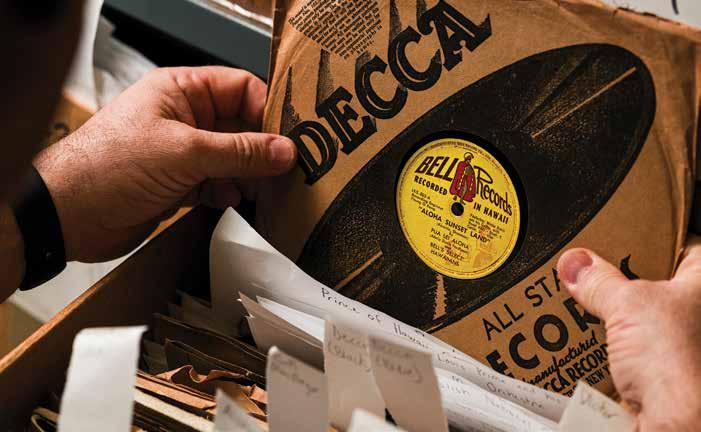
The 1915 Panama-Pacific International Exposition in San Francisco was a watershed moment for Hawaiian music. The expo stretched out for more than two miles along the city’s waterfront and attracted nearly nineteen million visitors over ten months.
People from all around the country and the world gathered to experience the latest in technology, art and entertainment. John Philip Sousa’s marching band paraded
through the streets; French composer Camille Saint-Saëns conducted his orchestra in the festival hall. But by many accounts the surprise hit of the expo was found inside the comparatively humble Hawaiian Pavilion, where the Kailimai Hawaiian Quintet and other Hawaiian performers strummed ‘ukulele and guitars, singing soon-to-become-classic tunes like Queen Lili‘uokalani’s “Aloha ‘Oe” and Henry Kailimai’s “On the Beach
at Waikiki” to crowds that sometimes exceeded thirty thousand people per day. Kailimai and other musicians and dancers throughout the expo—including Joseph Kekuku, who invented Hawaiian lap steel guitar—helped spark an explosion in the popularity of Hawaiian music. By the end of 1916, just one year after the expo closed, Hawaiian music had become the best-selling genre in North America. Hawaiian singers,
48 DEPARTMENT
PHOTOGRAPHY
Experience our Hawaii
Whether you want to fly high above the clouds, hike to a waterfall or snorkel with our sea life, adventure awaits.

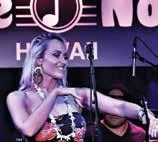










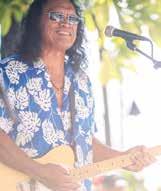
Hawaii’s premier live music venue Year-round entertainment
Daily live island music paired with handcrafted beers and cuisine
Home of Duke’s on Sunday with the incomparable Henry Kapono 4–6pm
Come be here.
Discover our experiences and find the places where Hawai‘i’s most renowned artists come out to play. Scan

to
view Activities & Experiences
OUTRIGGER Waikiki Beach Resort
OUTRIGGER Waikiki Beach Resort
OUTRIGGER Waikiki Beachcomber Hotel
OUTRIGGER Kā‘anapali Beach Hotel

dancers, songwriters and musicians were thriving. Recordings of their heartfelt musical performances were “cut” onto cylinders or discs made of wax and cellulose, which were used as masters for printing commercial products on plastic or shellac. Fans nationwide snapped up discs and cylinders to play on hand-cranked Edison phonographs and 78-rpm gramophones (the predecessor to modern turntables) with bulbous horns. A massive amount of Hawaiian music was produced and distributed to Islandobsessed listeners across the country.
Over the next hundred years, Hawaiian music and instruments like
‘ukulele and steel guitar made a huge contribution to many other musical styles; in fact, the electric guitar was invented in 1931 to amplify the sound of a Hawaiian lap steel guitar. But most of those physical recordings, bits of plastic and shellac from a golden era of Hawaiian music that lasted from around 1915 to the mid-1900s, were lost to the ages as new trends, formats and styles emerged to take their place. The Hawaiian artists of the early twentieth century faded from the limelight, but what happened to all those recordings?
“We believe we now have the largest collection of recorded Hawaiian music in
LEFT / An authentic 1912 Edison phonograph at the Hawai‘i State Archives.
OPENING PAGE / “Aloha Sunset Land,” a 1949 recording from the Michael Scott collection, now at the archives.
the world,” says Hawai‘i State Archivist Adam Jansen. Colorful and energetic, Jansen beams with near-childlike delight as he welcomes me in to see what’s cooking inside the boxy white building hidden in the shade behind ‘Iolani Palace. In 2021, after a few years of behind-the-scenes effort, Jansen and his team received two gigantic donations of Hawaiian music within a week of each other, each comprising around ten thousand records. The Hawai‘i State Archives now hold more than twenty-five thousand recordings of Hawaiian music on discs and cylinders dating back to some of the earliest known samples. But “please don’t call them ‘records,’” Jansen jokingly admonishes. For archivists the term “records” can mean nearly anything: books, letters, photos, sheet music. “Everything is a record. The discs that play music are what we like to refer to as ‘phonographic records.’”
Phonographic or otherwise, the archives are home to a huge assortment of all types of records, including historical documents, musical instruments, handwritten letters and manuscripts. It’s like a memento drawer on steroids. They’re even safeguarding moon rocks returned by the Apollo 11 and Apollo 17 missions, along with a Hawaiian flag that went with the astronauts to the lunar surface (and, remarkably, the US Customs forms that the crews had to fill out when coming back into the country from their out-ofthis-world trips). But the phonographic recordings are currently in the spotlight, and they’re likely to remain so as the archives proceed with an ambitious, multiyear effort to digitize all of them and make them available online for free.
Past the reception area is the archives’ main space, a large room full of tables, shelves and equipment where various staff and volunteers go about their work. What seems initially like a drab government office is revealed to be more like a secret magical workshop, part library, part museum and part research lab filled with wondrous gizmos.
50 DEPARTMENT: RECORDED HISTORY


O‘AHU • MAUI • K AUA‘I • BIG ISLAND OF HAWAI‘I • NCL PRIDE OF AMERICA BELLEVUE • BOSTON • CH ICAGO • DALLAS • DENVER • L AS VEGAS • NEW YORK ORLANDO • PHILADELPHIA • PLEASANTON • PORTLAND • ROSEVILLE • SAN DIEGO SAN FRANCISCO • SAN JOSE • WASHINGTON, D.C. NaHoku.com • 1- 800 -260 -3912 An incomparable collection of Hawaiian and Island lifestyle jewelry HAWAII’S BEST People’s Choice Awards The Star-Advertiser 2014 – 2023 NAHO-39147_EffyCompassStarPdt_HanaHou__JuneJuly2024_7.3x9.8.indd 1 3/14/24 5:34 PM
Musical antiquities share the space with ultramodern audio equipment, computers, oscilloscopes and speakers. And boxes and boxes and even more boxes of phonographic records. Front and center is a majestic original 1912 Edison Concert cylinder player, with its grandiose horn. “Excuse me, everyone,” Jansen declares to the staff, volunteers and visitors present as he carefully guides an antique cylinder onto the phonograph’s horizontal spindle. “I’m going to make a little bit of noise, but hopefully you’ll enjoy it.” He winds the hand crank and sets the cylinder spinning. The warbling tones of ‘ukulele and steel guitar from more than a century ago fill the room. “It’s a 1915 recording of ‘Aloha ‘Oe,’” Jansen says, full of admiration. “So it’s Queen Lili‘uokalani’s music, recorded during the queen’s lifetime. And this is how she would have heard it played back to her, through this type of equipment.” Jansen is devoted to ensuring that future generations will hear it as well, albeit through an entirely different audio experience.
On the other side of the room, stateof-the-art devices digitize these antique analog recordings at the highest possible quality. Jansen’s been on research trips to the Smithsonian Institution, the Library of Congress and the National Archives in Washington, DC, comparing notes with other archivists and audio restoration experts to implement the most effective processes and obtain the best equipment for Hawai‘i’s music digitization project. First, the cylinders are carefully handcleaned, while the discs are run through a gauntlet of hand- and machine-based cleaning processes. There’s the Keith Monks Record Cleaning Machine, which does exactly what its name suggests, using brushes and vacuums to remove surface grime and dust. Then the discs go into a specialized “degritter” to rid them of, well, grit by submerging the sound grooves in fluid and creating air cavitations with ultrasonic vibration to lift away microscopic bits of dirt.
When the phonographic records are clean and ready for their moment under the needle, it’s onto the Rek-O-Kut Trovatore turntable, an impressive industrial beast with an eight-pound platter that ensures smooth and consistent spinning. “This is an archivalquality turntable, not something you’d
find in somebody’s house,” Jansen says. “It’s a unique, specialized piece of equipment.” The recordings go through a litany of processors, equalizers, noise filters and more to capture the cleanest possible reproductions for digitization. If the exuberant Jansen is a bit like Willy Wonka, the digitization station and its various contraptions are the heart of his sonic chocolate factory.
“We always make two versions,” says Jesse Shiroma, an archivist specializing in audio digitization. “One is the raw track. That is exactly what’s on the disc with no equalization, going straight from the grooves to the needle to the digits.” He flips a switch and the speakers play back the digital copy of a lively musical performance from nearly ninety years ago. The hissing background noise is what most old phonograph records have in common, no matter the song. “It’s kind of crackly and tinny, but that’s what you get on the original recording from 1936,” Shiroma explains as he tweaks the knobs on his high-tech digital audio workstation. He flips the switch back and suddenly the track sounds clear. “This other track is our balanced track that’s run through the equalization to dampen the highs, bring up the lows, get rid of a lot of those clicks and pops and create a more realistic representation of the original performance.”
Drawing on his own background as a musician and songwriter (he’s a lifelong accordionist and percussionist whose former band, Streetlight Cadence, won two Nā Hōkū Hanohano Awards, a.k.a. the Hawaiian Grammys), Shiroma relishes the task of cleaning up old tracks while keeping the raw tracks in their pure form for researchers and historians. “I started off here as a volunteer because it seemed like such an incredible opportunity to work with some of the earliest professional recordings of Hawaiian music. The fact that all of this is available to the public is just kind of mindboggling. These recordings are things I thought would be locked away in a vault or in some private collection, never to be heard by the public. But it’s all here, it’s all available and it’s almost overwhelming.”
The generosity of a multitude of donors and volunteers has made the digitization project possible.
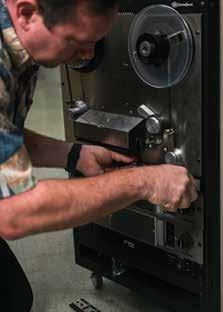
It all started with the late Harry B. Soria Jr., a well-known local radio host from a family of broadcasters. Soria’s Territorial Airwaves program aired vintage Hawaiian music weekly in Honolulu for forty years. Several years before Soria passed away in 2021, he had begun searching for an institution to inherit his enormous collection of more than ten thousand Hawaiian music recordings and memorabilia. “His only condition was that we had to make it all available to the public for free,” Jansen says. “He really wanted to share his love of Hawaiian music with everybody.”
While talks with Soria and his family were ongoing, Jansen got a call from the estate of Michael Alan Scott, another major collector. Scott was a musician in Canada who had developed a love for Hawaiian steel guitar years earlier. He had formed a Hawaiian music group of his own in Toronto and released several recordings. Throughout his lifetime Scott also collected more than ten thousand recordings of Hawaiian steel guitar-inspired music, and when he passed away in 2020, his will directed that the collection be donated to an institution that would maintain it in perpetuity and make it publicly accessible. In September 2021, Jansen had just finalized the arrangements with Scott’s
52 DEPARTMENT: RECORDED HISTORY
ABOVE / The archives’ now massive music collection includes recordings in multiple formats. Here, state archivist Adam Jansen loads a reel-to-reel tape.










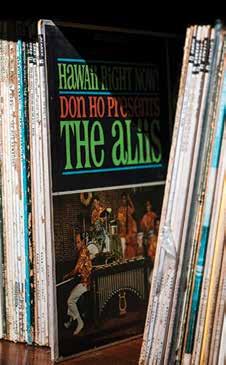
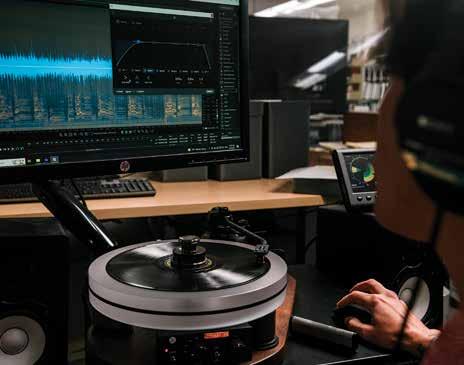
ABOVE LEFT / A small portion of the Harry B. Soria collection. ABOVE RIGHT / Archivist Jesse Shiroma turns analog recordings into clean, digital files for upload. “We want to get the finest copy that we can so that when the public listens to it, it’s something they enjoy, that they’re proud of,” says Jansen. “Because it belongs to them. We’re the public archives—everything we hold, we hold on behalf of the people of Hawai‘i.” estate and had another conversation with Soria. “Uncle Harry decided he wanted us to have it,” Jansen recalls. “So he signed off on the Soria donation just before I flew out to Toronto to pack up and bring back all of the Scott collection.” In the span of a few days, the Hawai‘i State Archives had inherited two of the largest collections of Hawaiian music recordings in the world.
The Scott and Soria acquisitions left little doubt for other collectors that the archives were the right place for Hawaiian music and related memorabilia. “I’ve had a lot of people come up and say, ‘If it’s good enough for Uncle Harry, it’s good enough for me. Please take all my records and add them to your collection,’” Jansen says. In 2023 the archives acquired thousands more recordings from T. Malcolm Rockwell, a Maui collector and author of Hawaiian & Hawaiian Guitar Records 1891–1960, an exhaustive discography of Hawaiian musicians. In 2024 the archives licensed Rockwell’s 1,500-page discography, providing the digitization team with cross-references for most of the digitized recordings so that metadata can be incorporated with the digital files, enabling future researchers to find specific songwriters, performers, recording sessions and instruments.
“We’re taking time and being careful to do it right,” says Jansen of organizing and preserving the music and related data, which will be released incrementally over time at digitalarchives.hawaii.gov, as each item must clear any copyright or other restrictions prior to digital release. “But eventually, all of this—the recordings, songbooks, sheet music, lyrics, photos of performers—we’ll get it all online and cross-indexed so anybody anywhere can search for, learn about and enjoy these amazing collections.”
Although they haven’t yet completed even a full inventory of all of the items, Jansen’s team has already uncovered a number of special pieces. “The oldest recording we’ve found so far is from 1903, which is incredibly early. And there are rarities from international artists who were so enamored with Hawaiian music and instruments that they wrote and recorded their own Hawai‘i-inspired songs.” With all of that material to go through, the project is expected to take quite a while. “Decades!” Jansen exclaims. “Because that’s the nature of phonographic records. You have to listen to them in real time,
you know. We can’t expedite the process. So it really depends on how many volunteers we have.” Other than archive staff, the operation relies on the public to help out. “Unfortunately for them, they have to sit here and actually listen to the finest collection of Hawaiian music in the world,” Jansen jokes.
As I listen to more melodies wafting from the ancient Edison phonograph’s ornate, electricity-free loudspeaker, I wonder what it might have been like to wander past that Hawaiian Pavilion more than a century ago in San Francisco. To be drawn in and witness the performance, seduced by the sound of ‘ukulele and leo ki‘eki‘e (falsetto singing). “We want to make all of these recordings globally accessible,” Jansen tells me in parting, with a hint of solicitation. He is, after all, constantly seeking more volunteers. “One can argue that the recordings are meant to be heard, not just preserved. Just because they’re no longer in circulation doesn’t mean that the music should ever stop.” hh
If you wish to volunteer or have material to donate, contact the Hawai‘i State Archives at musicarchives@hawaii.gov.
54 DEPARTMENT: RECORDED HISTORY

ALA MOANA CENTER • WAIKIKI BEACHWALK • SHERATON WAIKIKI HALE‘IWA STORE LOTS • SALT AT OUR KAKA‘AKO • PRINCEVILLE CENTER kahala.com @kahala
“Duke’s Pareo” Limited Edition
100%
Cotton Broadcloth Shirt in Hibiscus.
STORY BY PETER VON BUOL
Gliding to Glory
ELYSE BUTLER
Hawai‘i’s only synchronized skating team is in it to win it—and they just might

It’s just before 5:30 on a Sunday morning in mid-February at Ice Palace Hawaii. Sunrise is still two hours away, and the twelve skaters of the Tropical Blades Synchronized Ice Skating Team have the place to themselves—a rarity, in addition to the rarity of being the state’s only synchronized skating team at the state’s only ice rink. Ice Palace is usually
crowded with skaters of various skill levels, from twirlers and speedsters to board-hangers, and the ice is etched from thousands of revolutions around the oval. But now, on a quiet morning before dawn, the air is crisp and still, the ice smooth. Outside it’s a balmy winter morning, with temperatures hovering in the 70s. Inside, it feels like winter on the continent, with an ice
surface kept in the 20s and an air temp near 50.
One by one the skaters, ten females and two males ages 9 to 24, glide onto the ice to begin their warm-up wearing their neon-green-and-black Tropical Blades jackets. They’ve made their way here to Salt Lake from all over O‘ahu, some as close as Mililani and ‘Ewa Beach, others farther away, including
56 DEPARTMENT
PHOTOGRAPHY BY


“I’m so excited to represent Hawai‘i’s only synchronized skating team and to win all the medals we can,” says Tropical Blades co-captain Cynthia Louchez, 17, seen above at right with her sisters Elizabeth (left) and Sharon at Ice Palace in Honolulu. On the opening page, the team practices a forward single spiral line in preparation for the ISI World Recreational Team championships in San Jose.
Kāne‘ohe, Hawai‘i Kai and Kailua. Coach Robyn Ripley has come all the way from Waimānalo, practically on the other side of the island. And all have come to skate together as one in a sport that’s pretty unusual in the world of ice skating and about as alien to the Islands as bobsledding is to Jamaica.
Once on the ice, the team skates in counterclockwise circles around the rink, coordinating their movements so that they stroke in unison, their skates making a collective swooshing sound distinctive to synchronized skating in the otherwise quiet arena. “For most skaters, counterclockwise is their natural direction of rotation [for spins], so it’s easier for them,” says Ripley. “Sometimes during our warm-ups, we’ll go clockwise twice as many times because they need to practice it more.”
After their fifteen-minute warm-up, the team breaks into smaller units to work on specific elements. Groups of four skate to the center of the rink to practice lifts. Two skaters drift forward,
one hangs back. “One, two, three, down, up!” Ripley counts, and the teams raise up their fourth skater.
No one falls, but the team still has work to do before the lifts are competition-worthy.
“They all work so hard,” Ripley says compassionately. “They help each other, and they really want to do well. They are improving as a team, but this early in the morning they do start out a bit blearyeyed and cold.”
All this practice—two hours every Sunday morning and another half-hour on Monday evenings—is preparation for the upcoming Ice Sports Industry’s (ISI) World Recreational Team Championships in San Jose, California, July 25–28. Tropical Blades isn’t just competing as a novelty—Ripley believes they have a good shot at a medal.
It might be surprising, but skating has a long history in Hawai‘i. Synchronized skating (a.k.a. “synchro”) is the latest ice sport to be introduced
to the Islands, and Tropical Blades was its entrée. In 1956 a University of Michigan professor and figure skating judge, Richard Porter, developed what he called precision skating—intricate moves performed by a group—as a way for skaters to sharpen their skills and showcase their talent in front of a large audience. His team, still known as the Hockettes, first performed during intermission at Michigan Wolverines hockey games. The sport grew, and US Figure Skating held the first Synchronized Skating Championships in 1984 and the first World Synchronized Skating Championships in 2000. Today there are about six hundred registered synchronized teams in the United States. Scoring is like that of ice dance; teams are judged on their technical skill, seamlessness of transitions and overall performance. Like other skating disciplines, teams are also rewarded more points for greater difficulty. While there’s been a push to include synchro in the Winter Olympics, the sport has not
58 DEPARTMENT: GLIDING TO GLORY

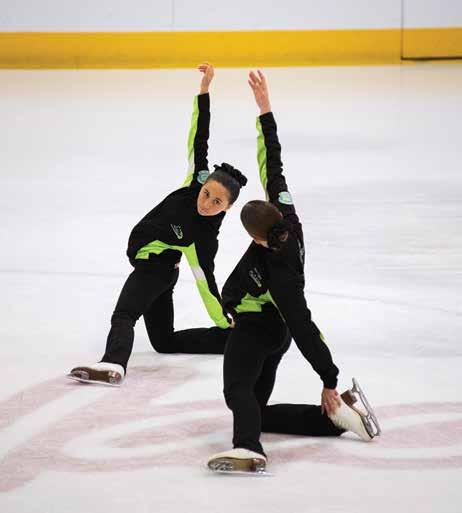
yet been approved by the International Olympic Committee—given its growth and appeal as a spectator sport, many believe it’s only a matter of time.
When executed flawlessly, synchronized skating is a pièce de résistance of precision skating, footwork and artistry. “The entire team should move as if they’re a single skater,” Ripley says. “When they break out to perform certain elements, the skaters should still appear to move together—it should almost look like a kaleidoscope. Turn, and then suddenly a single line breaks into four straight lines. Then, it effortlessly shifts into a spiral.” But it isn’t all just about technical ability. “The top synchronized teams”—like Alaska’s Forget-Me-Not, Ohio’s Arctic Snowflakes, California’s Dublin Dazzlers—“have a real sense of musicality.”
Ripley, 68, grew up on the Pacific Northwest coast and has been coaching
at the Ice Palace for the past three decades. In her own career she skated solo and went on to coach both singles and pairs. Her interest in synchronized skating began when she accompanied her students to an ISI Worlds competition in Canada, where synchro was one of the events. “I hadn’t seen it until then,” Ripley says. “My students would just go and sit down to watch the synchro teams perform.” While they admired the skaters’ artistry, it was the teamwork that really inspired Ripley—solo skaters are focused only on themselves. “We saw it a couple of times, and my students in Seattle thought it would be fun to just try it.” So they did, “for fun,” Ripley says. “Just to play with it.”
When Ripley began teaching at the Ice Palace in 1986, she started a synchro team “pretty much right away” and entered a competition on the continent, thinking it would be a

so
“They help each other and they really want to do well.”
AT LEFT / Cynthia Louchez (foreground) and Kealohi Hamilton practice a sliding lunge.
“fun thing” to compete, she says, but it wouldn’t be easy. During their practices, her nine skaters never gave up. “They had to help each other out and pick each other up during a routine. They had to move around and fix problems together. I saw how the teenage team members learned how to process each other’s thoughts and work together to solve problems,” Ripley says. “I saw so many skaters grow in ways they wouldn’t have if they’d just remained solo skaters.” They kept practicing, and when the nine-member Tropical Blades debuted at a competition in La Jolla, California, in 1987, they won first place in a field of thirteen.
Alyssa Noelani Owen Lewis, who is now a figure-skating coach in San Jose, was eleven years old when she competed with Tropical Blades at La Jolla. “We were a pretty small team. We just went out and thought, ‘This will be fun.
60 DEPARTMENT: GLIDING TO GLORY
ABOVE / Coach Robyn Ripley, who’s coached at Ice Palace since 1986, debriefs the team after practice. “They all work
hard,” Ripley says.





Collection available exclusively at Na Hoku An incomparable collection of Hawaiian and Island lifestyle jewelry O‘AHU • MAUI • K AUA‘I • BIG ISLAND OF HAWAI‘I • NCL PRIDE OF AMERICA BELLEVUE • BOSTON • CH ICAGO • DALLAS • DENVER • L AS VEGAS • NEW YORK ORLANDO • PHILADELPHIA • PLEASANTON • PORTLAND • ROSEVILLE • SAN DIEGO SAN FRANCISCO • SAN JOSE • WASHINGTON, D.C. NaHoku.com • 1- 800 -260 -3912 HAWAII’S BEST People’s Choice Awards The Star-Advertiser 2014 – 2023 NAHO-39147_LeVianAlohaTurtle_HanaHou_JuneJuly2024_7.3x9.8.indd 1 3/14/24 5:33 PM
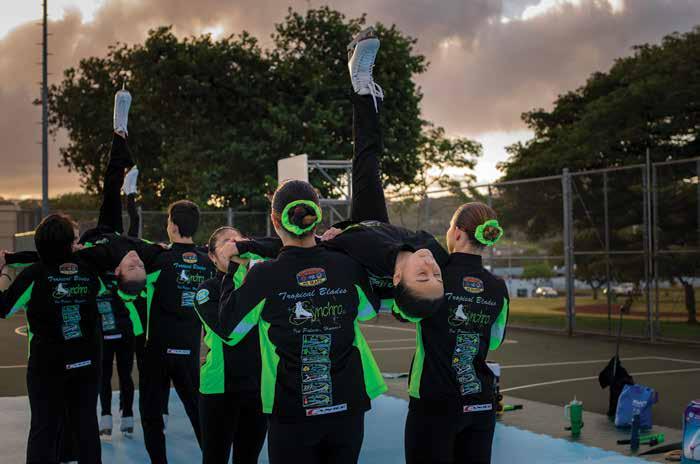
While Ice Palace was closed during the pandemic, Tropical Blades continued practicing at public
on
of plastic “ice.” While it had its limitations, it allowed the team to persevere despite the challenges of
chickens and errant pickleballs. Here, the team practices four-person lifts.
We’ll give it a try and see what happens.’ And we won, which was amazing,” she recalls. “And so, obviously, we were like, ‘This is great! Let’s do it again.’” They did do it again in 1988, winning at the World Championships in Dallas. They continued to compete, with success, into the mid-1990s, when the team went dormant. The original skaters had gotten older, and some had gone off to college. At the same time, Ripley switched to teaching an adult team. About six years ago, when parents approached Ripley to revive the team, she returned as the coach of Tropical Blades.
Ice Palace closed down during COVID-19 and did not reopen until nearly three years later, but the team’s spirit of perseverance kept it going. Deprived of ice, they practiced outdoors at a park in ‘Ewa Beach, on synthetic “ice”—squares of interlocking plastic tiles, like the floor of a Gymboree, that allow a skater to glide. Icelike, but not
quite ice. “You can’t skate as fast on it. You can’t go flying through the air and do a double jump. The plastic also means skate blades need to be sharpened more often,” Ripley says. “On the plus side, you don’t need to use expensive skates outdoors.”
And they can be expensive: The team uses blades made of tempered steel. The boots are usually purchased separately, and the blades are mounted by a skate technician. Combined, competition-quality boots and blades can cost upward of a thousand dollars. When Ice Palace was closed, the team couldn’t have their blades maintained by the rink’s professional sharpener, so they improvised. Tiffany Louchez, whose three daughters are on the team, bought a skate sharpening machine and did it herself.
“I can’t say enough about what an amazing group of kids and parents this is,” Ripley says. “During COVID-19 they worked together to get us the plastic ice
and to set it up outside at sunrise so the kids could skate.” Practicing outdoors on fake ice had its challenges—monsoon rains, errant pickleballs, wandering chickens—but nothing like the sun.
“By nine o’clock in the morning, it was already too hot,” says Ripley. A Hawai‘i resident for more than thirty-five years, she never got roasted as badly as she did on the first day of outdoor skate practice. “I went out there and sat on a stool in a tank top and got the worst sunburn I have ever had,” she says. “I even took a picture of it and sent it to my friends and fellow coaches in Seattle.”
Tropical Blades returned to the cold comfort of Ice Palace when it reopened in 2022. While team co-captain Emily Robinson, 15, says she’s grateful to be back on real ice, “Performing on the artificial ice was really exciting, and it was nice to see all the people who were amazed with what we were doing. It was also kind of humbling, because it was a lot of hard work and the ice did not
62
DEPARTMENT: GLIDING TO GLORY
parks
a movable surface
blazing sun, wandering

always cooperate with us. Falls were kind of common out there.”
Robinson first became interested in ice skating after seeing it on television as a six-year-old. Invited to a tryout by a former team member, she was quickly hooked. “I found it to be really fun, and I have been doing it ever since,” she says. “I’m looking forward mostly to being able to compete out of state for the first time and, hopefully, winning.” Robinson knows sometimes progress can sometimes seem slow. “Be patient with yourself and your progress and work hard,” she tells her teammates, “not only on the ice but also off the ice.”
The team’s steadfastness during the shutdown continues to inspire team co-captain Cynthia Louchez, 17, whose parents had purchased the synthetic ice. “Learning to persevere was the hardest yet most rewarding lesson I have learned from the pandemic,” she says. “Once the ice rink closed, my family invested in the synthetic ice and rebuilt the team from there. Even through the rain, wind and very hot sun, my team and I persevered in preparation for the Ice Palace’s reopening. I am forever grateful for the setback because it made my team and I much stronger on the ice than before the pandemic.”
Will the team be ready for San Jose? Louchez is confident. “I am looking forward to competing with the Tropical Blades for the first time. Due to the pandemic, I was unable to compete with the team in the Minnesota ISI Worlds and had to wait almost three years to compete again,” she says. “I’m so excited to represent Hawai‘i’s only synchronized skating team and to win all the medals we can.” hh
 Tropical Blades practices a forward lunge line with a shoulder hold at Ice Palace, one of the maneuvers they’ll perform at the championships in San Jose in July.
Tropical Blades practices a forward lunge line with a shoulder hold at Ice Palace, one of the maneuvers they’ll perform at the championships in San Jose in July.

The Artisans of Incandescence
Building beautiful explosions in Nagaoka, the fireworks capital of Japan
STORY BY MARTHA CHENG
FEATURES
PHOTOGRAPHY BY BEN WELLER
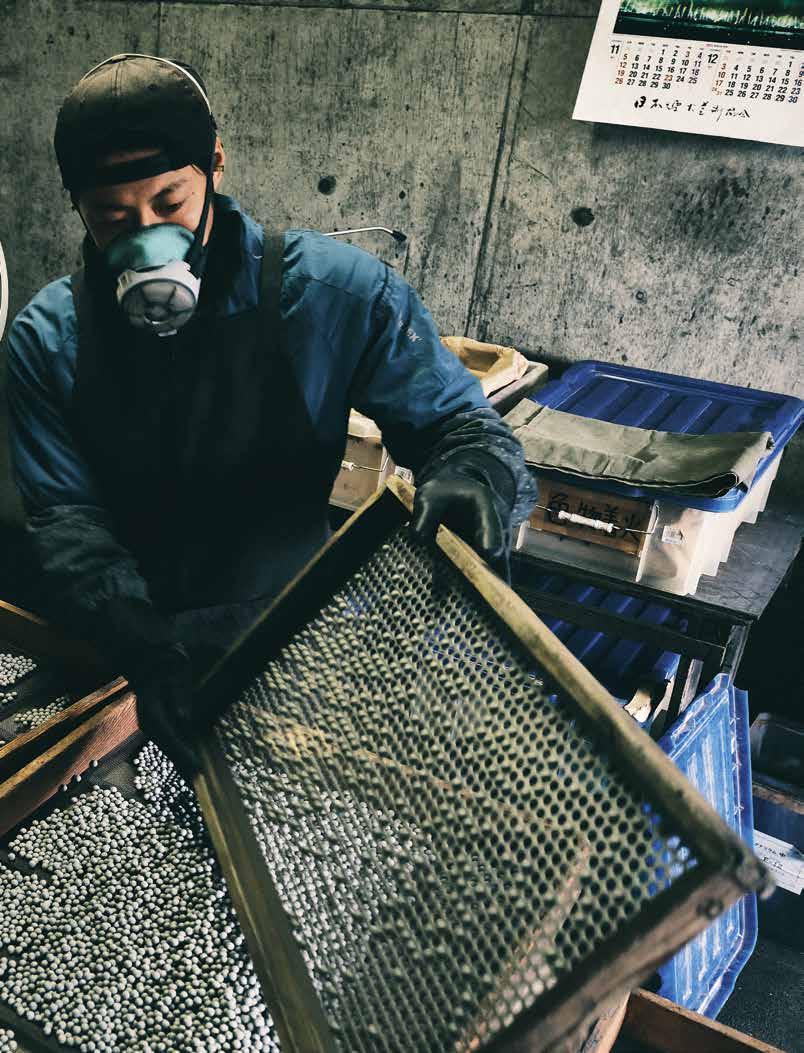
You need a lot of space to build some of the world’s largest fireworks. Which is why we’re driving into Japan’s countryside near Nagaoka, a city about 160 miles north of Tokyo. We pass two-story wooden houses, persimmon trees laden with bright orange fruit and rice fields, recently harvested. We know we’re at Abe Industrial Fireworks when we spot the rows of mortars, some up to thirteen feet tall. They’re used to fire three-footdiameter round shells, so large and heavy that they have to be loaded into the cannons by crane. “In Japan every fireworks company knows Abe big shell,” says Tomoki Abe, president of Abe Fireworks and the fourth generation running his family’s more than centuryold company.
But, as they say, size isn’t everything. (Though in case you’re comparing, the biggest shells launched in American shows are less than half the size of Abe’s.) Fireworks makers in Japan pride themselves on symmetry and shells that explode into a perfect sphere of light. It’s really this dazzling precision that has led me here.
In Hawai‘i we know fireworks, whether it’s the weekly Friday night show at the Hilton Hawaiian Village or New Year’s Eve, when neighborhoods around O‘ahu erupt with (illegal) aerials that make the streets resemble war zones. But one March five years ago, I glanced up at an unexpected show and saw delicate, glimmering bursts that scattered flashes in their wake like hundreds of fireflies; orbs that burned bright white and left long streaks like weeping willow branches; blooms of intense colors that changed hues in midair. They were the brightest and most beautiful fireworks I had ever seen. Where did they come from?
They were, I later discovered, part of the annual Honolulu Festival, a three-day span of cultural events in March that began in 1995 to foster relationships between Japan and the United States and has since expanded to include other
Pacific Rim countries. Since 2012 the Nagaoka Fireworks Foundation has coordinated the fireworks show, the finale of the festival, sending fireworks from a few companies in the Niigata prefecture, including Abe. And so, a series of emails and a pandemic later, I am in Japan in late November, following the fireworks to their source.
When I arrived in Nagaoka by bullet train from Tokyo, I immediately spotted photos of fireworks in the train station and, upon exiting, saw a launching tube and replica shell suspended above it. “People in Nagaoka are deeply proud of the fireworks,’” says Ariko Tsuchida, my guide in Nagaoka, later that weekend. We have just visited the Nagaoka Fireworks Museum, which is next to a restaurant called High Ambition that projects fireworks across the walls, and a souvenir shop where bursts emblazon cookie boxes and sake bottles. And it being the holidays, in the city’s Echigo Park, a Santa hat and angels adorn a model shell so large it looks like it could roll over and crush the meager Christmas tree next to it.
To learn about the city’s fireworks, or hanabi in Japanese (literally “flower fire”), is to learn about a place three times destroyed. The first time in 1868, during the Japanese Civil War. Nagaoka was on the losing side and burnt to ash. Then, on August 1, 1945, an American air raid lasting two hours killed 1,486 people and annihilated most of the city. In 2004 an earthquake devastated the region. A timeline at the museum marks these tragedies, along with the hanabi created to commemorate them.
While the city’s first fireworks display dates back to 1879 for a Shinto shrine festival, it has since evolved with the city. The precursor to the modernday show began in 1946, held exactly one year after Nagaoka’s destruction. Since then, every August 1 at 10:30 p.m., the time of the air raid, three pure white fireworks are launched into the sky to remember the victims. Over the

OPENING SPREAD / “Stars” are at the heart of fireworks. They are created by applying layers of a black powder slurry—a combination of explosives and metals for color—in a rotating drum. Here, the stars are sifted at Abe Fireworks in Nagaoka, Japan, to ensure they are of uniform size.
ABOVE / A shell is filled with stars of varying sizes at Abe Fireworks.
FACING PAGE / While Japan is known for its summer fireworks shows held across the country, there are also a few small festivals throughout the year, including the Winter Fantasy show in Nagaoka in November. Fireworks produced in Nagaoka are the stars of the show each March at Honolulu Festival.
66
FEATURES: THE ARTISANS OF INCANDESCENCE

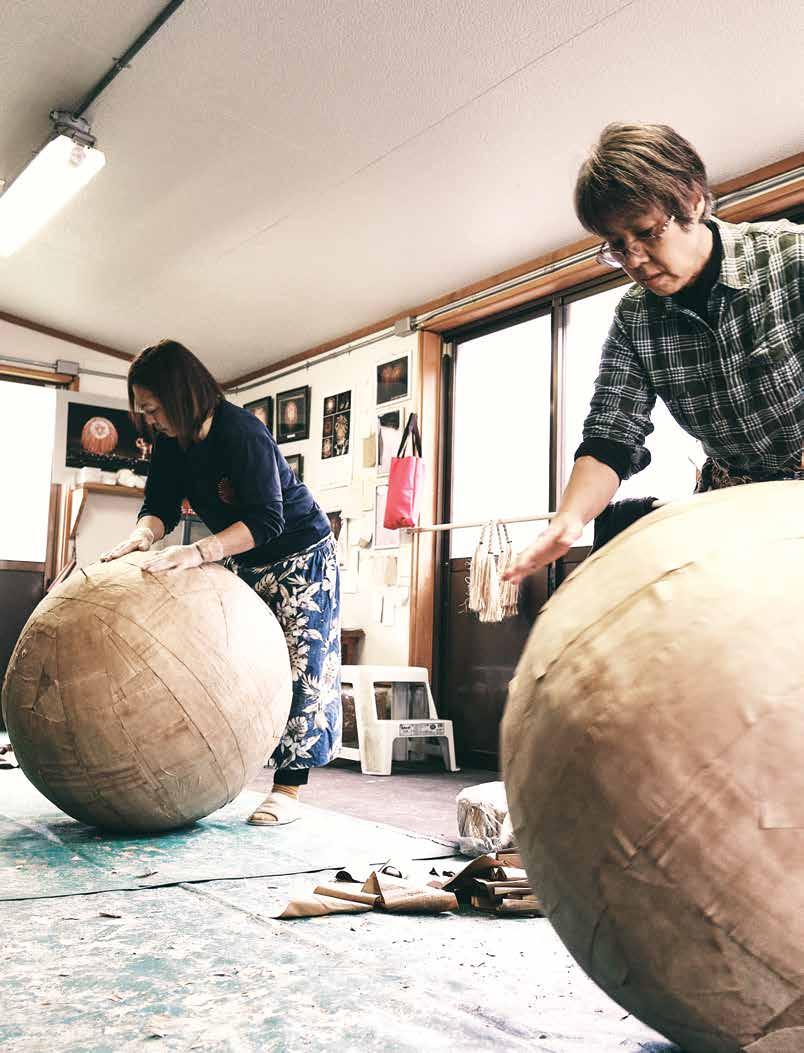

FACING PAGE / Japan is known for its spherical fireworks—fireworks made in Western countries tend to be cylindrical. Here, thirty-six-inch fireworks casings are made by applying fifty layers of paper.
ABOVE / Tomoki Abe, president of Abe Fireworks, at age 3 next to the forty-eightinch shell that debuted in 1986. It is still the largest commercially produced shell in the world.
FOLLOWING SPREAD / Left, a shell with stars and a bursting charge made of cork and rice husks. Right, a beautiful fusillade at Winter Fantasy.
following two nights, during the Nagaoka Fireworks Festival—one of the largest shows in Japan—the display includes the Kome Hyappyo: one hundred shells fired in sequence to recall the one hundred sacks of rice donated to Nagaoka after the civil war. A municipal leader insisted they not be eaten, which would grant only temporary relief, and instead to sell the rice and use the funds to establish a school, an investment in future generations. And then there are the Phoenix fireworks, golden-winged efflorescences bursting over a mile-long stretch along the Shinano River. It’s the longest span of fireworks in the world, a tradition that began one year after the catastrophic 2004 quake, as Nagaoka rose from the ashes.
“There’s a huge difference between the perception of fireworks in the United States and Japan,” says Katsuhiro Takano, a board member of the Nagaoka Fireworks Foundation. “Nagaoka’s fireworks, as we repeatedly say, are dedicated to the deceased by the war and also the wish for eternal world peace. Those emotions are conveyed in our fireworks, but in the United States the fireworks are more like festive events. So we make a lot of efforts to have the understanding by the American side.”
Honolulu is on the timeline, too: 2015, the seventieth anniversary of the end of World War II, when the fireworks from Nagaoka included three white chrysanthemum hanabi launched at Pearl Harbor as prayers of everlasting peace. Honolulu and Nagaoka were once enemies: Isoroku Yamamoto, who commanded the attack on Pearl Harbor, was born in Nagaoka; just before Japan’s surrender, Yamamoto and his hometown fell to the American military. To help reconcile the past, the two cities became sister cities in 2012, and ever since, the Nagaoka Fireworks Foundation has brought a show to the Honolulu Festival. Each year, it begins with the three shots of white fireworks to remember American and Japanese war victims, and the program always includes the signature Phoenix, symbolizing recovery and rebirth.
many,” Abe says in halting English, motioning with his hands to illustrate a multitude of bursts. “Here we shoot one by one. For me personally, I like to shoot one good shell. One big shell.” For the Nagaoka Fireworks Festival, which takes place for two hours a day over two days, about twenty thousand hanabi are launched, whereas New York’s July 4 fireworks, considered one of the biggest in the US, fires sixty thousand (much smaller) shells in just twenty-five minutes. And while during Nagaoka’s show there are moments of frenzy like the Kome Hyappyo, much of the festival moves at a more measured pace, the better to fully appreciate dramatic and thunderous bursts like the sanshakudama, a three-foot-diameter shell that blooms to a span of more than two thousand feet—the height of Tokyo Skytree, the tallest tower in the world (and twice the height of the Eiffel Tower)—before cascading into a waterfall of light.
In Abe’s office there’s a photo of him at around three years old, as tall as the forty-eight-inch shell that debuted in 1986—it is still the largest commercially produced shell in the world, created by Masanori Honda in nearby Katakai. At one time Katakai and Nagaoka were so bent on beating each other to build the largest fireworks that the Japanese government limited the amount of gunpowder allowed in each city to eighty kilograms. Abe has not bested the forty-eight-inch shell, of which only a few are launched each year, but it’s famous for making annually about twenty sanshakudama and eighty of the next size down, still impressive at two feet in diameter.
“Usually my image of American fireworks—short time and then shoot
While a long tradition of fireworks exists across Japan stretching back to the sixteenth century, near large, dense cities like Tokyo, hanabi are limited to five inches. So it’s in the countryside you’ll find the producers of massive fireworks. But even the largest are still made by hand. The word “industrial” in the Abe company name belies its craft, down to the thick layers of paper in which the explosives are encased. The art of making fireworks in Japan begins with paper—if applied unevenly, the fireworks will not explode symmetrically. “The first job was making paper in my
FEATURES: THE ARTISANS OF INCANDESCENCE 69
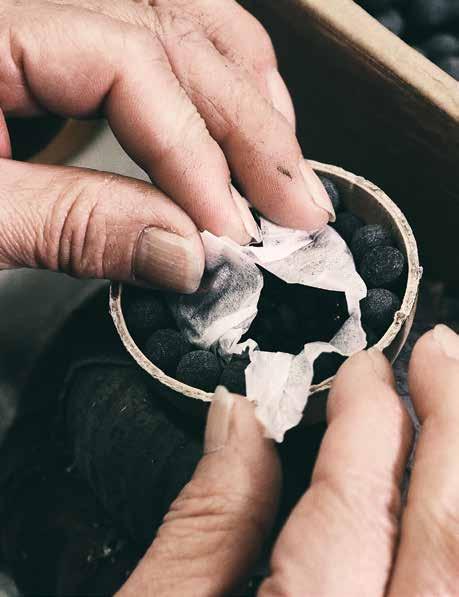

family,” Abe says. “My great-grandfather made a special Japanese paper,” one so durable that it could substitute for carpeting and, incidentally, was also sturdy enough for fireworks. “In Japan we have many shrines everywhere. So we would make paper and fireworks and share for shrine ceremonies. In the beginning it was just for hobby.”
Since then, though Japanese fireworks are rarely exported, Abe Fireworks has supplied and set off fireworks across the world, including in Afghanistan in 1958 to celebrate the country’s independence and for the Olympics’ closing ceremonies in Sydney and Salt Lake City. The day we visit, Abe is preparing to send fireworks to Hong Kong for a New Year’s Eve celebration at Victoria Harbor. (This even though China is a huge manufacturer of fireworks—nearly all of America’s fireworks are imported from China.) And of course, there are those he sends to the Honolulu Festival, though the largest shell is just eight inches due to regulations. But the fireworks mostly stay in Japan. Some make it into shows that Abe designs and shoots, and some are sold to other companies— though when it comes to launching the sanshakudama, “they feel scared,” he says, and usually ask him to help.
Abe has made and set off fireworks his whole life: His family’s house was next to the factory’s previous location. After school he would play next door with fireworks. He remembers that up until about twenty years ago, they still lit all the hanabi by hand—by throwing the fire in the mortar and running. These days, the fuses are linked to a computer; you just press a single button to launch an entire sequence from a safer distance. After high school Abe went to Canada to study English and intended to work at an American company to learn more about the industry, but then came the 9/11 attacks. As a result, “No foreigners could touch explosives,” he says. “So I returned to Japan.” When Nagaoka started launching fireworks in Honolulu in 2012, “basically, we cannot touch [the fireworks and equipment], just point.”
set of rooms that Abe takes us through, they make “stars,” applying layer upon layer of a black powder slurry in a rotating drum, like covering nuts with chocolate. Stars are at the heart of fireworks, and just like real ones, each is responsible for a point of light in the sky. The stars fill the spherical shells, and in a perfect firework they all illuminate at the same instant and all disappear together. They are a combination of explosives and metals, like barium for green or copper for blue, aluminum for flashes and magnesium for glittering white. “Japanese special skills is changing color,” Abe says. To achieve this, different compounds are layered like in a jawbreaker candy—he shows me the cross section of a star that changes color seven times, and tells me of “ghost stars,” which go dark before each color change. The current trend, Abe says, is blooms that change color directionally, which requires that a shell be filled with stars of six different types, each with six coats of color.

The technicians try not to inhale the stardust. In the first
In the next rooms, where yellowing pieces of paper with formulas and notes are taped to the wall, the shell builders have swapped their outdoor shoes for soft slippers and sit at low tables split from a single large tree. Surrounded by wooden boxes of stars, stacks of shells and rounds of paper like coffee filters, they arrange stars in two halves of a shell. The pride of Japanese fireworks is the chrysanthemum, which bursts into a sphere that changes color as it expands. For this the stars are organized in a single layer in nested paper bowls, and between each layer is a bursting charge of gunpowder, cork and rice husks, which scatters the stars outward. In a chrysanthemum there can be as many as five concentric spheres to create an evenly spaced bloom, viewable from every direction. But there are also many other hanabi possibilities: stars arranged in a smiley face (always a crowd-pleaser); shells within a shell, which create many small fireworks going off at once; tubes within shells that will spin when ignited; half shells facing outward within a larger whole shell, which creates the wings of the phoenix; even stars individually outfitted with parachutes, to create drifts of light. When each half is finished, the shell builders—with a pause, a breath
and steady hands—clap the two halves together to complete the ball. The finished ones line up by the doorway, their fuses and roundness making them look like cartoon bombs.
The final step is pasting together the shell. In one room the women—it’s usually women who paste—sit cross-legged, gluing strips of paper over the smaller, filled shells. In the next room, papiermâché balls reach the women’s waists as they make the thirty-six-inch casings, rolling and pasting, rolling and pasting. When the shells are finished, the paper will be fifty layers thick, almost as solid as wood. These large fireworks are filled with stars by cutting a hole in the top of the casing—two halves would be much too heavy to put together. (Though Teruaki Senuma, president of Ojiya Fireworks, whom Abe has invited over today, says he’s tried. The stars, as expected, spilled everywhere.) A finished 36-inch sphere will weigh 440 pounds, as heavy as a tiger.
“Always, I feel nervous,” says Abe. We are at the Winter Fantasy show, where his team and two other fireworks companies are running fuses to a control
72
ABOVE / Tomoki Abe, the fourth generation of his family to run the century-old Abe Fireworks company, explains the process of making shells.
FACING PAGE / A worker at Abe Fireworks inspects two halves of a shell before pasting them together.
FEATURES: THE ARTISANS OF INCANDESCENCE

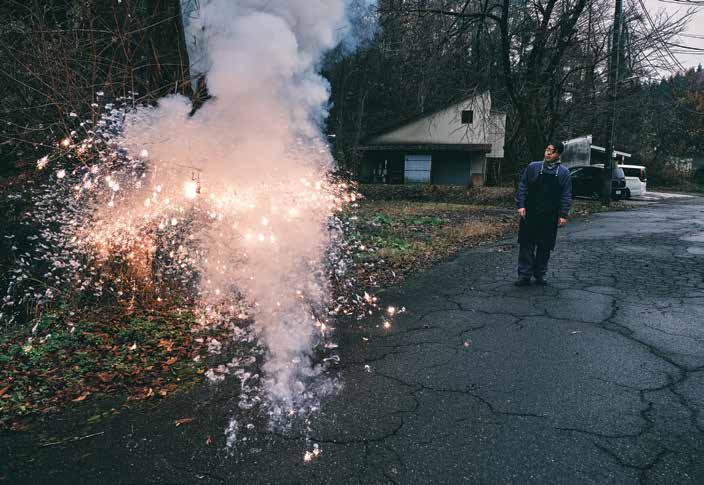
box in a van in the freezing rain. “A lot can go wrong with fireworks. We cannot test especially big one. It’s very fun, but always when we shoot I feel nervous. I have no confidence.” Sometimes the fireworks don’t ignite. Sometimes the grass below them catches fire. (There are always firefighters close by.) Recently, Abe shot a thirty-six-inch shell that didn’t reach its intended height of two thousand feet, exploding too early and just three hundred feet away from the mortar. Luckily, no one was hurt. Tonight, though, it’s a relatively lowstakes program. Just six sequences, including one set to Mariah Carey’s “All I Want for Christmas Is You,” and, of course, the Phoenix. The largest shell is only five inches (there’s a new structure in the park, and the city would prefer to keep it intact). And thanks to the rain, fires seem unlikely. Here, at Nagaoka’s largest park, the setup feels spacious compared with
the Honolulu show, which is crammed onto three seventy-five-foot barges off of Waikīkī, with the pyrotechnicians separated from the igniting charges by only thick wooden boards.
A number of pyrotechnicians around Japan have shown up for the show. You can tell the pyros because they’re always smoking. (It’s been said that they used to light the hanabi with their cigarettes.) One of them is George Tashiro, who used to be in finance. “Yeah, I wasn’t happy being in that industry,” he says, in between showing me photos of experimental shells he built and videos from his drones flying in the fireworks—he lost three last year when they flew too close to the explosions. About twenty years ago the bank he worked for had funded a company that went bankrupt, driving the company’s founders to suicide. “It was bad. So when you’re depressed, you want to look up, right?”
Tashiro turned to fireworks. So too did the hundred or so spectators who came out for the Winter Fantasy despite the cold wind and rain. As the first firework streaks across the sky and we all look up in anticipation of the illumination, I think about what someone from the Nagaoka Fireworks Foundation said when I asked what drew him to hanabi. “That little line that goes up, and then it explodes,” he said. “It looks like my life. A grand feeling.” hh
74
Above, a technician tests the “tail” of a firework—the streak you see as the firework shell ascends before it bursts. They are trying to create a four-second tail—four seconds between launch and explosion. Facing page: A display in Winter Fantasy in Nagaoka.
FEATURES: THE ARTISANS OF INCANDESCENCE
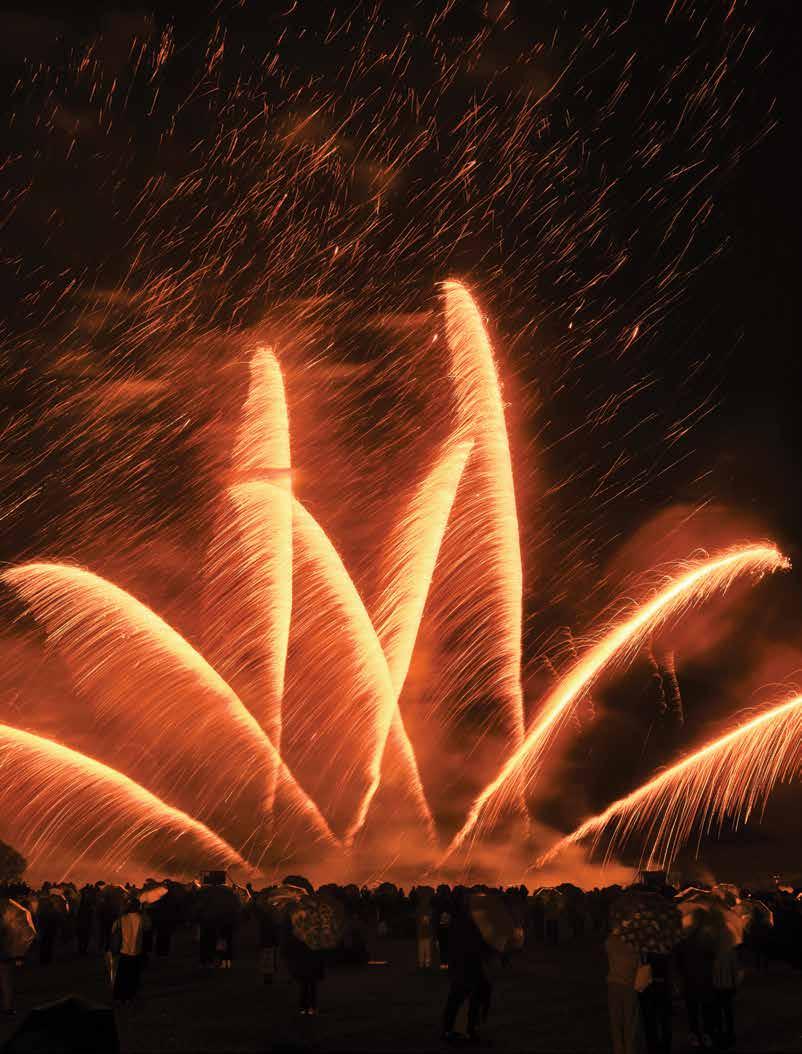
Realm of Stone and Sea
Walking Moloka‘i’s wild west end
Centuries ago, a fleet of war canoes attempted to land on Moloka‘i. The island’s priests began chanting, and as their voices grew in strength, so did the ocean’s currents, sweeping the invaders away. Moloka‘i became known as Pule ‘Ō‘ō, place of powerful prayer.
The island’s reputation for resisting intrusion has grown over time, though it hasn’t stopped outsiders from trying to tame Pule ‘Ō‘ō and its people. The island’s arid West End is scarred with signs of these struggles: flecks of black plastic in the red dirt of fallow pineapple fields, a boarded-up hotel,
an abandoned sand mine and military waste baking in the sun.
Molokai Ranch has dominated the West End since 1898. Over the past century, the ranch’s multiple foreign owners tried establishing a luxury resort, golf course and safari park complete with zebras and giraffes. The ranch finally closed in 2008, taking with it the West End’s only gas station and movie theater.
Meanwhile, the West End endures, wild and raw. Wind wipes footprints away from Pāpōhaku Beach as fast as they’re laid. Native pōhuehue vines reach across the sand dunes at Mo‘omomi, where fishermen harvest
according to the moon, as did their ancestors. Generations of paniolo— Hawaiian cowboys—continue to rope and ride on the slope of Maunaloa. Photographer PF Bentley moved to the West End in 2009 and documents life in the slow lane on daily walks with his dog, Ehu Girl. For twenty years Bentley captured history as it happened as special correspondent for TIME magazine. The same camera that followed US presidents on Air Force One and guerillas in the mountains of El Salvador now catches the sea mist rising like breath along Moloka‘i’s northwest coast, seen on the facing page.
FEATURES 76
WORDS BY SHANNON WIANECKI PHOTOGRAPHY BY PF BENTLEY



FACING PAGE
Strong currents roil the water at Pāpōhaku, especially during winter when large swells collide in the shorebreak.
BELOW
Paniolo (cowboy) Kainoa “Bulla” Kamakana puts his teeth into a recent competition at the Uncle Jimmy Duvauchelle Rodeo Arena.
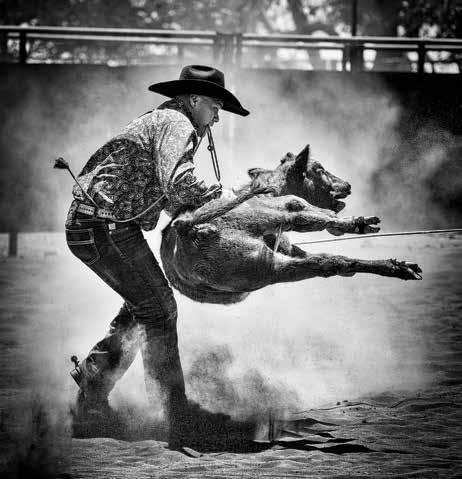
79


ABOVE
Which is mightier, water or stone? A wave eclipses the hundred-foottall Kaiaka Rock at the south end of Kepuhi Beach.
80
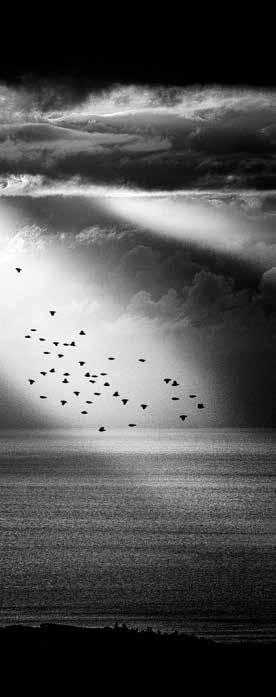
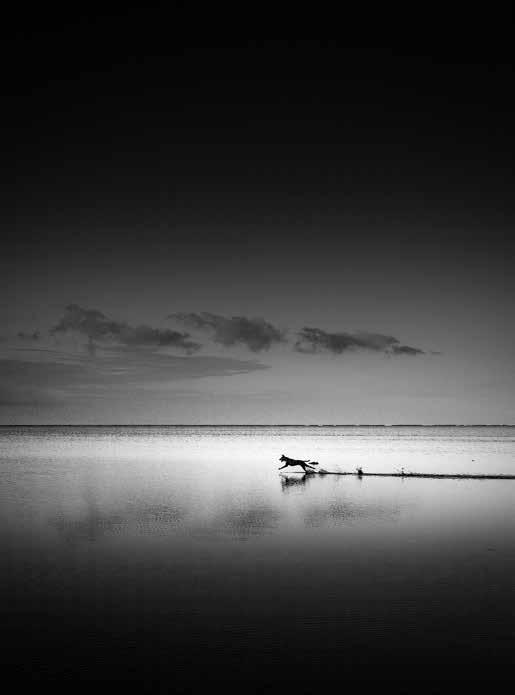
ABOVE LEFT
The view from Maunaloa, the gently sloping volcano that defines the West End, has a mythic quality. The summit is known as the birthplace of hula, where the goddess Kapo taught her sister Laka to dance.
ABOVE RIGHT
No leash necessary at Kapuāiwa, where the shallow flats extend nearly a mile out to sea.
81
HALE O LONO HARBOR
Paddlers await the start of the Moloka‘i Hoe, the world’s oldest and most prestigious long-distance outrigger canoe race. Each year, around a hundred crews converge here to begin a forty-onemile journey across the Kaiwi Channel to Waikīkī, battling big swells, chapping winds and each other.
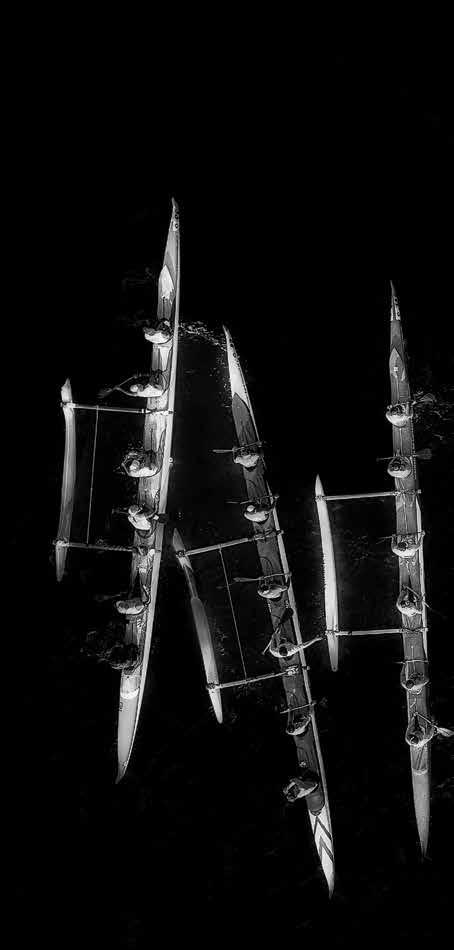
82

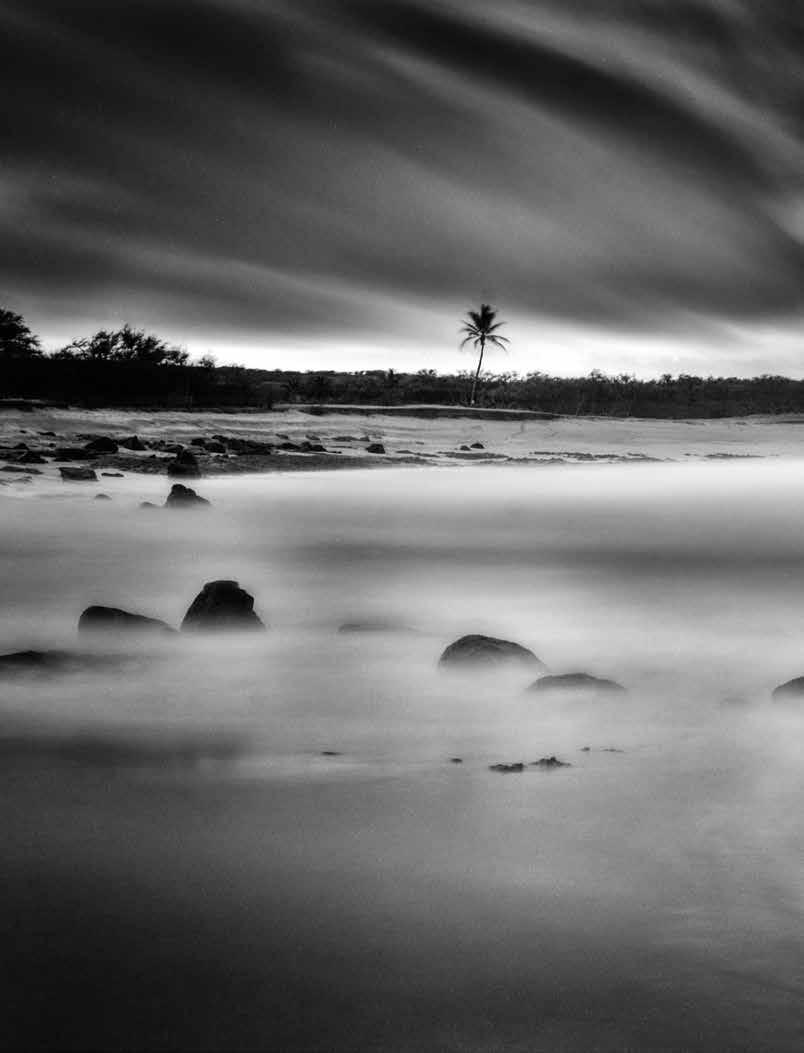
PĀPŌHAKU
This nine-minute exposure captures the ethereal beauty at the north end of Pāpōhaku, a wild, often deserted three -mile stretch of sand.
84
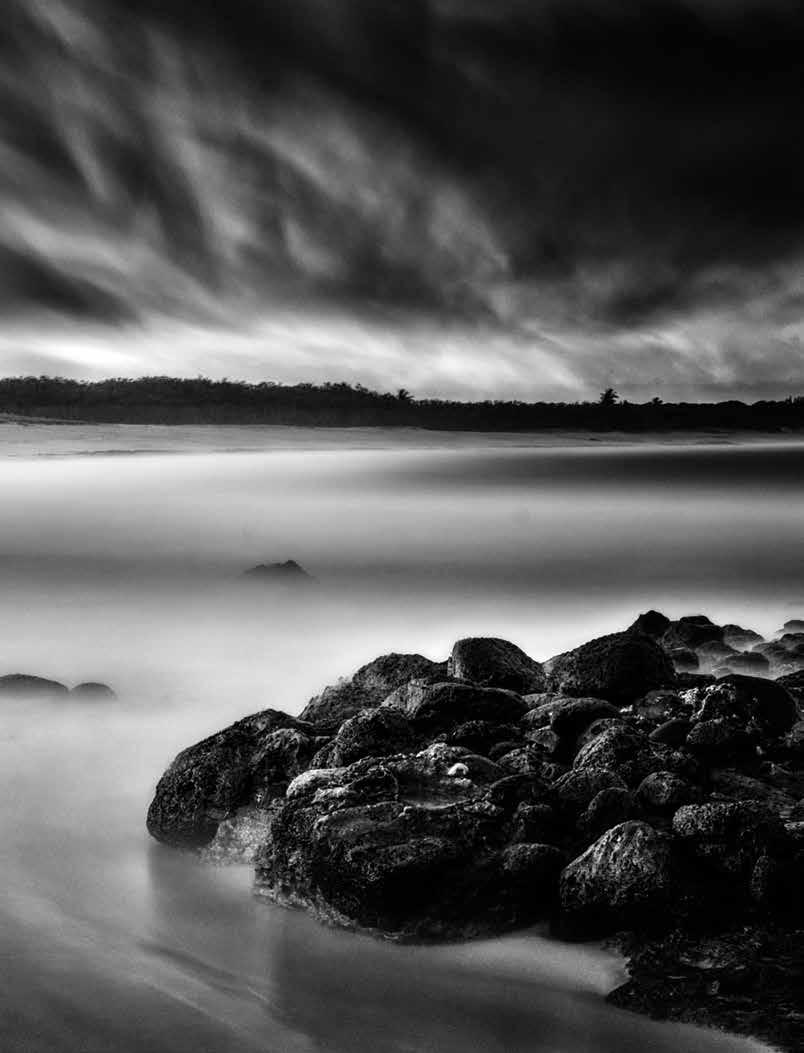

Rush hour on the West End, where motorists are as likely to encounter a herd of axis deer as another car.
FACING
The waters of West Moloka‘i alternate between tranquil and tumultuous.
ABOVE: MAUNALOA HIGHWAY
PAGE: KAIWI CHANNEL
86

87
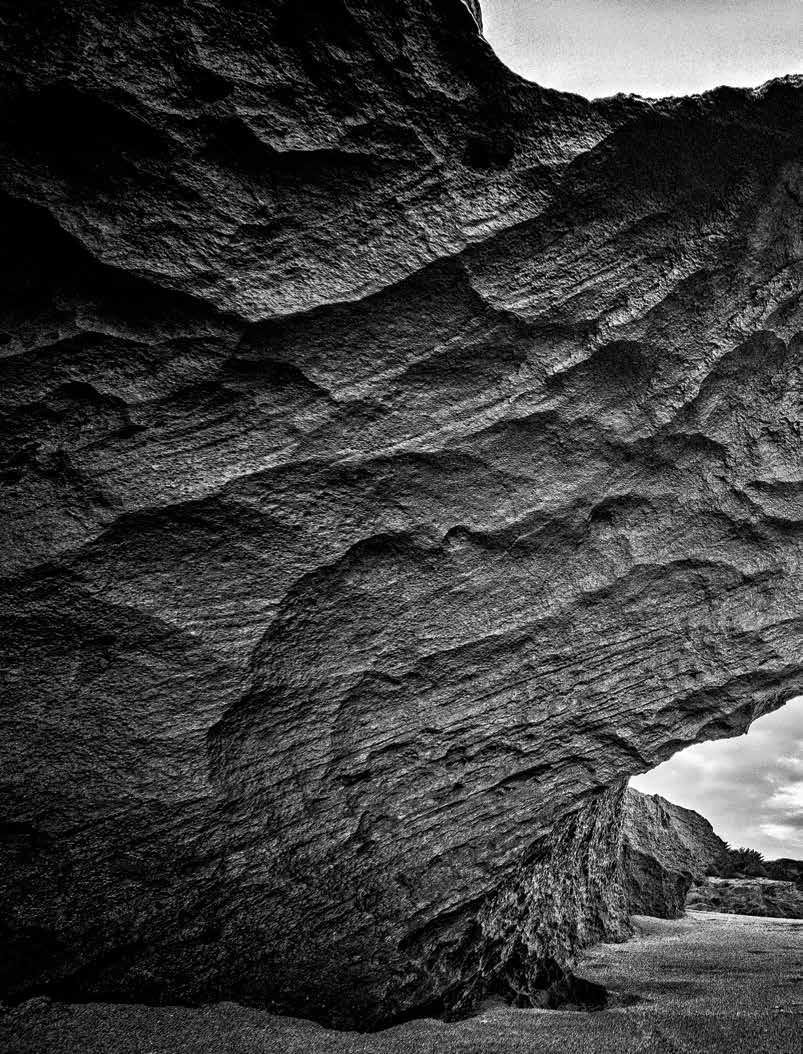
This stone arch usually lies buried beneath twenty to thirty feet of sand. Bentley discovered it after a season of unusually high surf laid it bare. “Maybe West Moloka‘i allows PF to capture its spiritual side,” says Lori Buchanan, whose family roots reach deep here, “so he can share it for the next generations.”
88
PĀPŌHAKU

The Trickster
Heimana Reynolds has carved a career—and an Olympic berth— from the deck of a skateboard
At Banzai Skatepark, just across the road from Pipeline on the North Shore of O‘ahu, a bronzed Hawaiian guy holds his skateboard with one foot, contemplating a vertical drop. Sweat beads on his brow and his arms hang limp. The park’s curling concrete sculptures—the scooped transitions, the hips and bowls, the arching radii—are a kind of wave that Heimana Reynolds knows how to surf. Heimana, whose Tahitian name means “power of the head lei,” lifts his other foot to the front of his board and quiets his mind. He bends slightly and drops over the precipice. Whooshka, he’s away.
Hawai‘i, being so small, means that you might bump into Heimana—he might run past you at Sandy Beach to rinse off at the showers after getting bodyslammed in the shorebreak. He could be cruising next to you down the H-2 in his late-’90s Toyota 4Runner, one he lifted and modified himself, music pumping. Or jumping off the rock in Waimea Bay, then in line with you at 7-Eleven, lean, square-shouldered, tanned and standing 5’10” in rubber slippahs, feet sandy, buying a Spam musubi while you analyze the tattoos decorating his body. Shoot, he could be sitting next to you on this very flight, headed between Honolulu and San Diego, where he lives part of the time. Point is, you’d be forgiven for not recognizing a famous skater. He might look like just another local surfer boy, but at just 25 years old, Heimana has made a mark on the world

90 DEPARTMENT
LIAM
PHOTOGRAPHY BY ARTO SAARI
STORY BY
WILMOTT

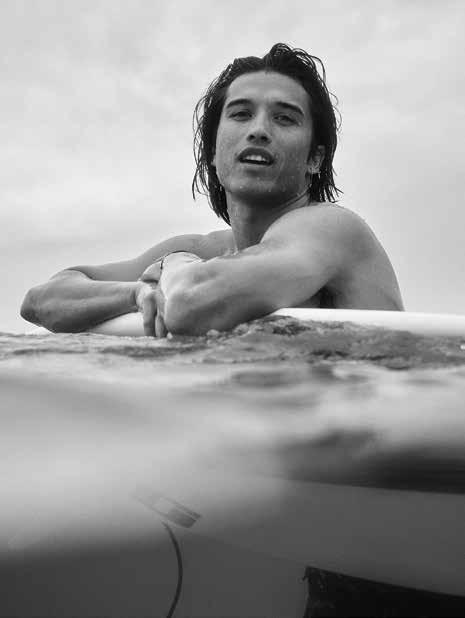
of skateboarding, having won world championships and competed for Team USA in skateboarding’s debut at the 2020 Tokyo Olympics.
“When I was in my later school years, my teachers would always be like, “When are you going to start thinking about your future? What about college? What about a career?” he says with what I call his resting happy face. “I’ve done so many things, been to so many places, and it’s all because I skate. I don’t think they realized what skating was really about. Maybe they do now.”
Although islands face all directions on the compass rose, O‘ahu is very much divided into North and South, or country and town, respectively, to locals. In the country, red dirt blankets abandoned cane fields, potholes freckle the roads and wild roosters crow endlessly above the low rumble of winter waves. The North Shore is known as an incubator for some of the world’s greatest surfing talent. Skateboarding? Not so much. Heimana lived an idyllic North Shore early childhood, growing up
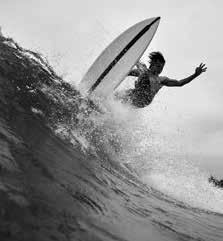

TOP / Like a lot of kids growing up on the North Shore, Reynolds started out as a grom (young surfer), later translating his fluid surfing style to a skateboard when his family moved to the South Shore.
BOTTOM / Reynolds in his element at Cholo’s Bowl.
AT LEFT / Reynolds in his other element at Sandbars on the North
in an old plantation home in Waialua, spending days at the beach with his younger sister, Raiatea. His dad, Matt, worked as a Honolulu City and County ocean safety lifeguard, and his mom, Samantha, handled customer service for her parents’ jewelry business. Like a lot of other kids from Hawai‘i, Heimana’s hapa (mixed) ancestry reads like a history of immigration to the Islands: Hawaiian, Tahitian and Chinese from his dad; Filipino and Caucasian from mom. Kids on the North Shore are often schooled in the ways of the ocean
DEPARTMENT: THE TRICKSTER
OPENING SPREAD / Pro skater and Olympian Heimana Reynolds performs a front side grind at Cholo’s Bowl, an empty pool on the North Shore of O‘ahu.
92
Shore.

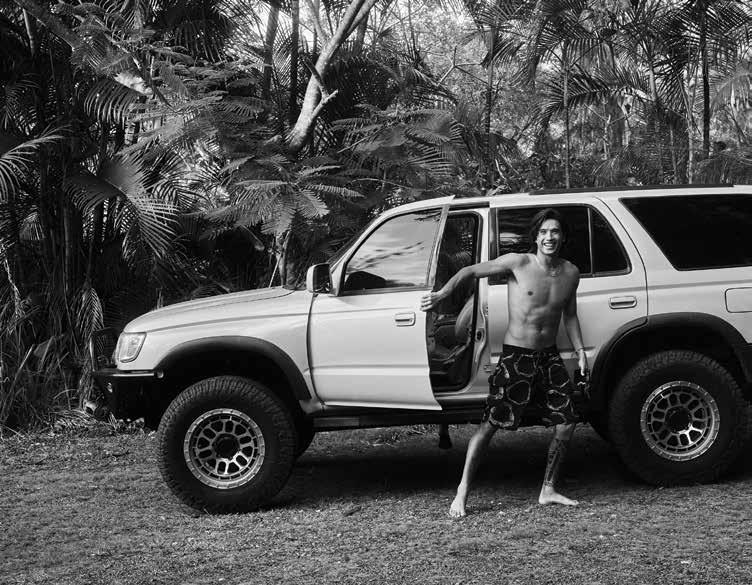
before they even learn the alphabet, and the Reynolds siblings were no different. While their young parents made ends meet, the kids were well and truly crawling down the North Shore surf grom (young surfer) path. But the tides of life abruptly changed in 2005: Heimana’s grandmother was diagnosed with cancer. She lived alone in ‘Āina Haina, on the South Shore. Matt and Samantha sold their place in Waialua and bought the house next door to grandma. Along with his new home, Matt found Heimana a new type of board to stand on, one that didn’t require surf wax.
“My mom was sick, we lived far from the best waves and I wasn’t lifeguarding
anymore,” Matt recalls of the early days when the skate bug first bit Heimana.
“I had all this energy and emotion in me, and I just poured it into my young son. Skateboarding has always been a passion of mine, so I started teaching him the basics and we went from there.”
“We tried him at other sports along the way,” Samantha adds, “baseball, tae kwon do, soccer, but he was adamant— he just wanted to skate!”
The bond Heimana found with his dad through skateboarding soon redirected the course of the entire family. By the time Heimana was in second grade, Matt, who minored in childhood education in college, was cramming Heimana’s friends into his
car and heading for the skate park; they wanted to skate, too. Matt found he had a knack for teaching and making the learning fun. Soon after, in 2007, Matt and Samantha opened O‘ahu’s first indoor skating facility, Proper Rideshop. Business boomed. Matt’s connections came out of the woodwork to mentor, and kids came from all over the island to attend. Samantha shifted from working with jewelry to working with kids, even converting a room at the warehouse into a study hall. Heimana was in heaven. At 8, Heimana started building his competitive resume. Dad was his coach, Raiatea was his little skate partner and Mom kept the wheels from falling off. Heimana collected 3rd Lair King of
DEPARTMENT: THE TRICKSTER 94
When he’s not lit up in skating’s limelight, Reynolds is often found working under the chassis of older model Toyotas like his 1998 4Runner, seen above at Cholo’s Bowl.
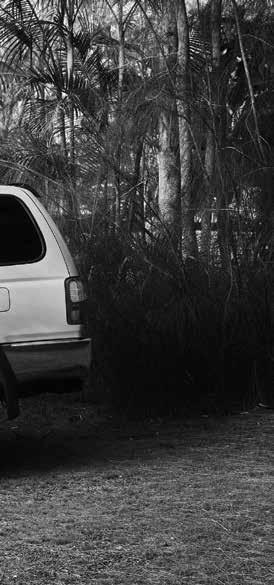
the Grom titles and racked up podium finishes at Dew Tour and VANS Park Series events. His insatiable drive and foundation in surfing only enhanced his stylish approach to skating. He placed top-tier in multiple X Games as well as won silver and gold at consecutive World Skateboard Championships. By the time he graduated high school, he was an established pro and a seasoned instructor at Proper. But, he says, the peak of his achievements came in 2021, when he ranked number one in park skateboarding.
“When skateboarding was announced as an Olympic sport, and then to make the park team—it was just incredible,” Heimana recalls of his


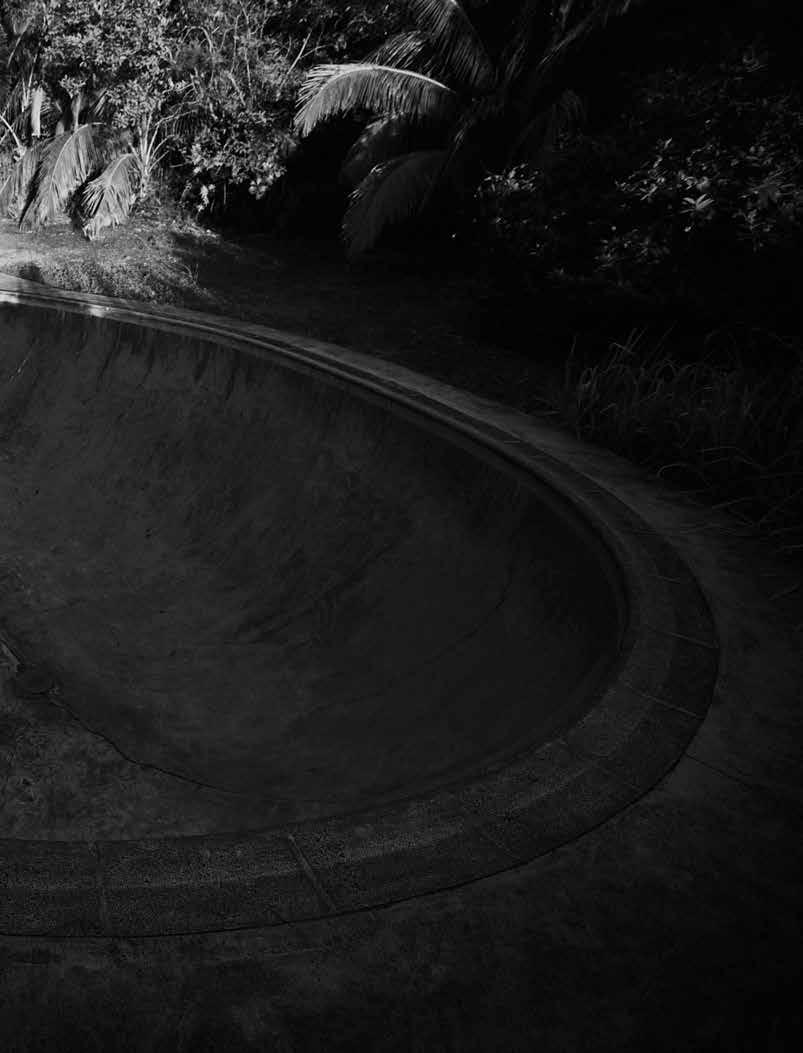

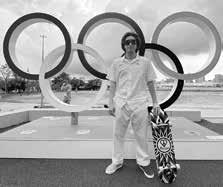
ABOVE / Skateboarding made its Olympic debut in 2020 at the summer games in Tokyo; Reynolds—then ranked number one in park skating—rode for Team USA.
FACING PAGE / “When I land a trick I’ve been working on, it’s a feeling I can’t even describe,” says Reynolds, seen here executing a perfect barefoot handplant at Banzai Skatepark on O‘ahu’s North Shore.
experience in the 2020 Tokyo Olympics, the year skateboarding debuted. “To be able to say, ‘I am an Olympian’ was insane.” Heimana admits that his grom-crush on American snowboarder and skater Shaun White spurred his competitive dreams. Heimana was six years old in 2006, when he watched White win gold in the snowboard halfpipe on television. Two years later Heimana met his idol in real life, literally looking up to him on the skateboard halfpipe at the X Games in Los Angeles. “I got to watch Shaun practice, and it just struck me how many times he fell and got back up, and then when he went out in the competition and won, I was blown away.”
From the moment skateboarding began in the 1970s, it was looked down upon, a nuisance that rebels and outcasts brought to streets and in public places, rolling, sliding and skidding along footpaths, stairs and benches. Over the decades it evolved on the fringes and grew in the shadows. When it flowed into the mainstream, skateboarding was seen under a new light, as a sport that, like figure skating, is equal parts athleticism, artistry and personal expression. Skate parks started popping up in communities around the world; free of hazards like pedestrians, traffic and angry shop owners, parks offered skaters unlimited potential to develop their craft.
Skateboarding has grown into a $2 billion dollar industry today, with

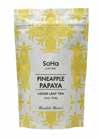







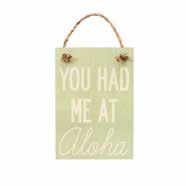

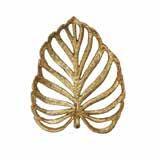

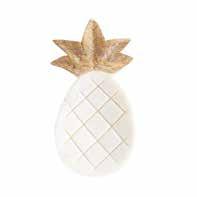


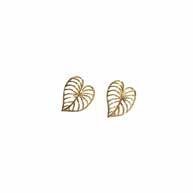



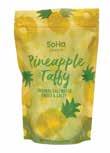
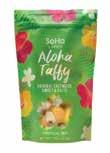

85 million participants worldwide. If anything, some core skaters believe the pendulum may have swung too far toward acceptance, and they worry that the dance and eloquence of a skater in motion can’t be properly celebrated within the confines of competition. Even being judged seems at odds with skating’s maverick spirit.
But not for Heimana. He thinks skateboarding in competition is all-in-all good for the sport. “Skating is such an individual thing, and there’s not really a wrong way to do it. In skating there are so many of us who can perform with excellence; we’re all good, and we’re all creative in our own ways. But competitions bring us all together, and I’ve seen the support grow because of it.”
Heimana rides natural stance, often shirtless and occasionally barefoot. He’s renowned for his fast, smooth and
flowing style. He skates concrete like he’s surfing a wave, hitting big sections with speed and filling his air time with perfectly executed aerobatic tricks. It’s difficult to express to a layperson just how good he is: The language is opaque. For example, his signature moves include his frontside Madonnato-tail and the 360 flip tail-grab he landed to win gold at the 2019 World Championships in Brazil.
But as anyone who’s ridden a shopping cart down a slope knows all too well, all it takes is one tiny pebble for things to go literally sideways. To skate you must be comfortable falling again and again, and in a world of concrete and steel, injuries are common. Heimana has had his share of ER visits, but he takes it in stride; he’ll tell you that the body heals, that dentists are a godsend and that the life lessons are worth every second of pain. But
the most precious rewards, for him, come in completely unexpected ways. Even though Heimana left the Tokyo Olympics without medaling (he finished thirteenth in the men’s park event), he did walk away with a keepsake he treasures like gold.
Norma Reynolds, his grandma, next-door neighbor and, yes, cancer survivor, lived to be 75, long enough to bake thousands of cookies and watch her grandson represent the United States in the first-ever Olympic park skateboarding event. It must have been a chicken-skin moment for her; when her grandson was eight, she’d watched him tell a local news station that his dream was to be an Olympic skateboarder. A bold prediction, considering the sport was still a decade away from being considered by the Olympic committee. She left him a voicemail soon after he competed in Tokyo. “She told me she
100 DEPARTMENT: THE TRICKSTER
“No matter where I travel in the world, I meet kids on skateboards who blow my mind,” says Reynolds. His family has mentored thousands of Islands kids, helping them plant their feet on skateboards through their camps at Proper Ride Shop. Above, Reynolds with a grom watching the action at the Super Skate Posse Giveback event at A‘ala Skatepark in Honolulu.
couldn’t believe she had just watched me on TV and that she loves me and she is so proud of me,” Heimana recalls, pausing for a moment. “She passed away a month after the games, and I can’t tell you how much it means to have her voice in my phone so that I can listen to her anytime I need.”
This year at the Paris Summer Olympics, the International Olympic Committee will again award medals to skateboarding’s top competitors. At the time of this writing, it’s not yet known who will qualify to wear the red, white and blue for Team USA, but the odds that one of them will be from Hawai‘i are better than ever. Two other Island skaters, Jordan Barrett and Lillian Erickson, are also in contention, both alumni of Proper’s training programs.
If Heimana doesn’t get a return ticket, that’s all right with him—he doesn’t need to compete again to carry the Olympic spirit, he says. “It sounds weird, but in skating we want others to succeed,” he says, “because if they do, when it’s our turn, our level elevates. It’s a really healthy cycle to be in.” And, in quintessential skater fashion, he acknowledges that competing is just another way to connect with others over their shared passion, whether they speak Portuguese or pidgin. “Take the last Olympics for example,” he says. “There were skaters from all over the world, we’re all up on the deck together and we can barely hold a regular conversation. But we know this beautiful dialect—we share the language of skateboarding.”
Back on the North Shore, Heimana comes to the end of his run. He pops over the coping and slides to a stop next to some local kids who have come to skate. They smile as he shakes their hands in the local slip ’n’ grip style.
“That was sick,” one of the skaters tells Heimana.
“Shoots,” he replies, the local slang for “roger that.” “Show me what you’ve been working on.”
The grom drops his board on the edge of the coping, holding it in place with his foot. Then he hesitates.
“You got this, brah, just do your thing,” Heimana encourages. “It’s like my mom always said, ‘All you gotta do is drop in.’” hh

Nourishing
the
Roots
Indigenous
cuisine is experiencing a rebirth in Hawai‘i and around the world
Kealoha Domingo did not want to be known as the Native Hawaiian chef who cooks laulau, a traditional Polynesian staple of pork and salted fish bundled in taro and ti leaves. Actually, he didn’t even want to be a chef. His aunt and uncle were in the restaurant business, and Domingo saw how it drained time away from family. So he spent almost thirty years avoiding a culinary career, becoming a mechanic instead (plus, the money was way better). And yet, because his grandfather “gave us that sickness of cooking—that’s what my uncle called it, a sickness—everywhere we go, we have to cook for people,” he couldn’t stay away from the stove. He’d moonlight from his day job as an elevator mechanic
STORY BY MARTHA CHENG
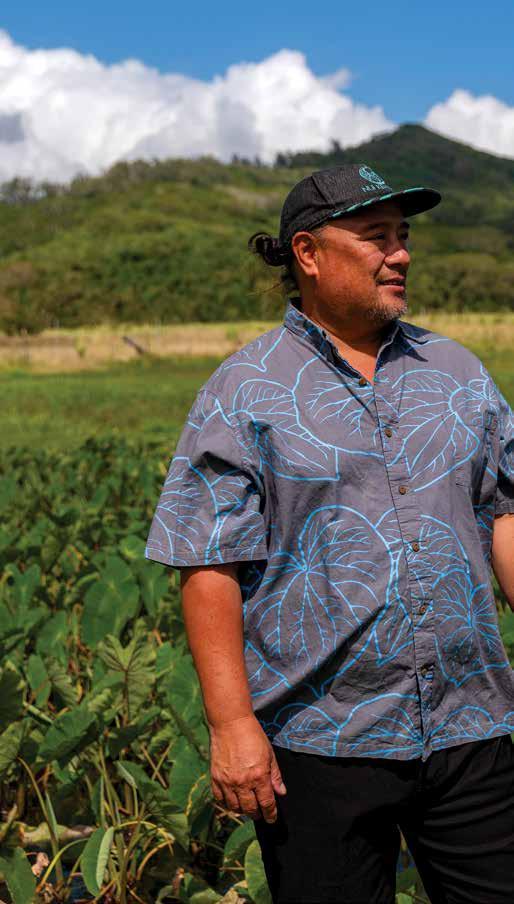
102
PHOTOGRAPHY BY LAURA LA MONACA DEPARTMENT

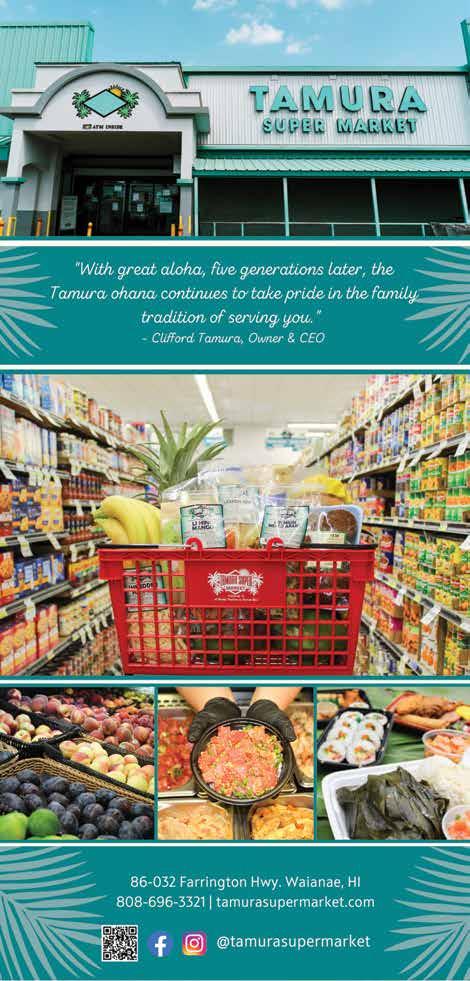

Hawai‘i’s Kealoha Domingo (seen on the opening page) has cooked with Indigenous chefs around the world and has become part of a revival of Indigenous culture through cuisine. “There’s a sanctity that we hold for the ingredients and a connection that we have with our food versus it being a commodity,” he says. “Highlighting your heritage through kai, through food,” says Māori chef Monique Fiso (seen above) of Hiakai restaurant in Aotearoa (New Zealand) “is an amazing way to show people your whakapapa [genealogy] and who you are.”
to cater for Native Hawaiian community groups and cook at special events like the Hawai‘i Food & Wine Festival—he likes to joke he was the only chef who both cooked at the Hawaii Convention Center and worked on its escalators.
And then, in 2019, he was laid off. He decided he would take his “expensive hobby,” as he also calls it, and turn it into a business. Part of his motivation was that there were very few Native Hawaiian chefs cooking Native Hawaiian food commercially. “Not that I have anything against people doing it who are not Hawaiian, but I feel like it’s important for us as Hawaiians to stand by our culture and identity,” Domingo says. “I’m no expert, but I just want to take some responsibility and build the narrative in a good way.”
In recent years, Indigenous chefs across the globe are reclaiming native food traditions. One of the most recognized in the United States is Sean Sherman, who opened Owamni in Minneapolis in 2021, shunning colonial ingredients like beef, wheat flour and cane sugar in favor of
dishes like venison spoon bread, smoked bison rib eye and pawpaw custard with fermented berry dust. The restaurant won a James Beard Award, and in his acceptance speech Sherman, who is Oglala Lakota, said he hoped there would be Indigenous restaurants in every city one day. Their numbers are certainly growing, with restaurants including Cafe Ohlone on the University of California, Berkeley campus; Wahpepah’s Kitchen in Oakland, California; and Sly Fox Den Too in rural Rhode Island. Meanwhile, on the other side of the world, chefs are serving modern Indigenous cuisine in refined settings, including Hiakai in Wellington, New Zealand, and Akame in Pingtung, Taiwan.
But long before more recent restaurants were leading with their indigeneity, some of Hawai‘i’s most beloved institutions, like Helena’s Hawaiian Food, dating back to 1946, and Highway Inn, started in 1947, were serving “traditional” Hawaiian food—poi and laulau and squid lū‘au, dishes that are part of Hawai‘i’s food vocabulary today.
Many of these restaurants, however, are not owned by Native Hawaiians, and neither are many of Hawai‘i’s newer restaurants bearing Hawaiian names. But does that even matter? What’s known as “local” food in Hawai‘i borrows freely from other cultures, largely a result of the plantation history that brought laborers from across the world. What’s called “traditional” Hawaiian food includes chicken long rice, with its unmistakably gingery Chinese flavorings, and lomi lomi salmon, for which hardly any of the ingredients in that condiment existed in pre-contact Hawai‘i.
Domingo doesn’t have the answers— his own wife, who is not Native Hawaiian, speaks ‘ōlelo Hawai‘i (Hawaiian language) better than he does, and he says he loves a Zippy’s saimin and fried chicken as much as any local—but he feels that representation matters. “I just think that it’s important for people to understand what traditional Hawaiian food is, and how the Hawaiian perspective on food is really, really such a complex thing. There’s
104 DEPARTMENT: NOURISHING THE ROOTS
photo courtesy of hiakai
a different level of sanctity and connection to the ingredients”—for example, the kalo plant is considered the elder brother of humankind who, when cultivated, in turn nourishes us—“that [once] you start getting into it, you’re forced to understand things like conservation, environment, resource management.”
Because of this, Domingo struggles to balance promotion with preservation, commercialization with conservation. To perpetuate Hawaiian culture, he wants to share it. But commercialization impacts the sources. “I agree with keeping the knowledge and the connection alive to the actual ingredients,” he says. “But we just have to be very mindful about how we use it and how much of it we use. And for me, I don’t want to draw attention to dishes that I don’t believe are going to be sustainable. I want to be sure that the resource will be here for my kids and their kids.”
And so, over the past few years, Domingo has walked this tightrope as a Hawaiian ambassador for Hawaiian food. At the James Beard House in New York City, he pounded pa‘i‘ai (mashed taro) and served it with cured ‘ahi. At a Terra Madre conference in Turin, Italy, he presented a tomato poke with hazelnut ‘inamona (traditionally crushed kukui, or candlenuts), and ‘awa served in ‘apu (coconut shell cups). He brought a papa ku‘i ‘ai and pōhaku ku‘i ‘ai (board and stone poi pounder) to a Slow Food Indigenous gathering in Hualien, Taiwan. And when Sean Sherman came to visit Hawai‘i, they collaborated on a dinner where Domingo served i‘a lāwalu—fish wrapped in ti leaves and flame-charred, finished with a coconut sauce tinged with ti ash—and, yes, laulau.
“Think of this as a Sunday roast reimagined through a MāoriSamoan lens,” writes Monique Fiso, a chef of Māori and Samoan descent, in her book Hiakai. The facing page features roasted tītī, a seabird, served alongside a pile of braised pūhā, a bitter green; and a taro gratin baked with coconut cream. Her book documents some of the native ingredients and foodways of Aotearoa (the Māori name for New Zealand) with modern recipes from her restaurant. Hiakai, the Māori word for hungry, began as a series of pop-ups in 2016 and then settled into a restaurant in 2018. Since its inception Fiso has created twenty-three menus without

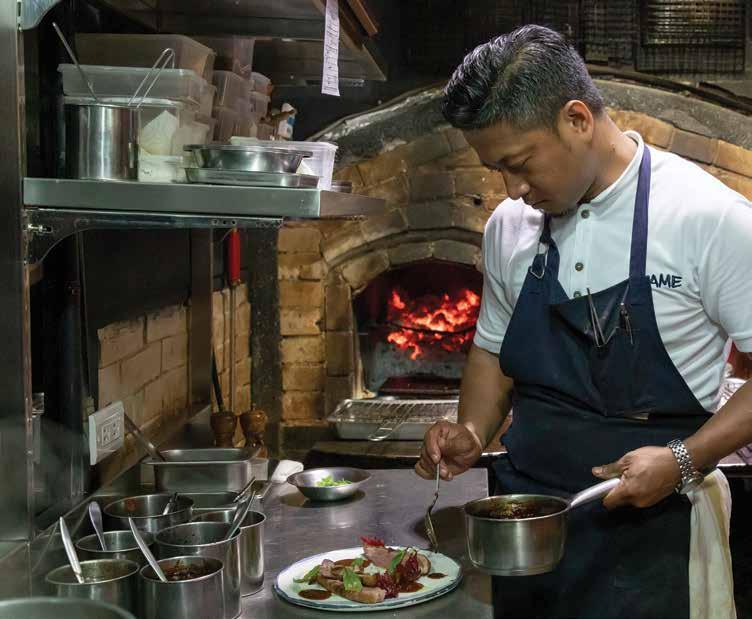
already looked different from others because we’re darker,” says Alex Peng of the
grew up. People would always ask about his heritage, he says, so
Indigenous cuisine, using ingredients foraged in the wild and sourced from nearby villages.
repeating a dish. Her most recent tasting menu, called Wai Tai (“ocean water”), “explores the importance of water on human existence,” she says. It concludes with a semifreddo infused with wild, sundried seaweed and garnished with fresh peaches and strawberry umeboshi.
As a child, Fiso knew she wanted to be a chef. She worked in kitchens in New York for seven years, and when she returned home, “I noticed that there was a lack of representation of Māori and Pasifika (people of the Pacific Islands) in the dining scene, and I thought that was odd, especially considering we’re in Aotearoa”—
where 17 percent of the population is Māori and 8 percent is Pasifika. “I thought, ‘Someone should really do something about that.’ And then I thought, ‘Well, hold on. You’re Māori and you’re a chef. Maybe you should do that.’ I had trained in and learned all these other cuisines. And now I want to learn more about the kai (food) of my people, my ancestors.”
Except, how? For generations of Māori, like many other Indigenous peoples, two and a half centuries of colonization had severed connections to their heritage. “I found that the usual ways that you would learn about a subject in this day and
age—go to the library or look online—there wasn’t this plethora of information that I naively assumed would be there,” Fiso says. She turned to her community, and through each hunter, horticulturist and cook, she found her way back to her roots. And in turn, her own work has inspired more Māori and Pasifika representation in Aotearoa’s dining scene, from food trucks to full-scale restaurants.
But, at least for now, the Wai Tai menu will be the last. Fiso announced in February that the restaurant would close in March. “At a time of unprecedented global food crises, we want to be part
106 DEPARTMENT: NOURISHING THE ROOTS
“We
Indigenous Rukai people of Taiwan, where he
in 2015 he opened Akame in southern Taiwan to showcase the island’s
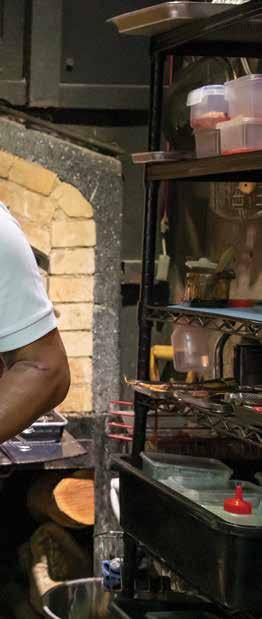
of the solutions,” read Hiakai’s social media post. “We care deeply about the systems, security and sovereignty of kai. The challenges we collectively face are monumental but not impossible. … Hiakai is evolving, not coming to an end.”
The way to Akame isn’t easy.
The restaurant is in Pingtung county, the southernmost tip of Taiwan, about 180 miles south of Taipei. From the nearest high-speed rail station, you’ll drive about an hour, part of it along a winding mountain road, before reaching Wutai Township, a village of Rukai people,

 photo courtesy akame
photo courtesy akame

and introduced ingredients. “You
everything in concepts and flavors from our past and from other cultures that
one of the sixteen officially recognized Indigenous peoples in Taiwan. Chef Alex Peng, who is of Rukai descent, chose the location to bring diners closer to where Rukai live, where nearby venues showcase cultural artifacts and vend freshly fried millet doughnuts. “I want to introduce my Indigenous culture and way of life to others,” Peng says. “And food is the key to understanding it. Because once you like my food, like my ingredients, maybe you’ll be more curious and more inspired to learn more about the culture.” He opened Akame, which means “grill” in the Rukai language, in 2015 and eschews the more theme-park feel of some Indigenous restaurants in Taiwan for a more subtle approach. He has served black Silkie chicken glazed with a mountain pepper miso and smoked with angelica leaf—and to slice into it, a scaled-down replica of a Rukai hunting knife. For dessert: churros dusted with Taiwan white pine needle
and native cinnamon, served with locally grown chocolate.
Like Peng, the chefs at Honolulu’s Mud Hen Water, Ed Kenney and Alika Chung, combine global influences with native ingredients in a way that can make their cuisines hard to define. Kenney likes to say they cook from a voyaging perspective: Polynesians were skilled voyagers, and they brought with them a set of canoe crops (the very ingredients that some mistake as native plants), a starter kit that included ‘ulu (breadfruit), kalo (taro) and kukui. “And then when they landed, they would source ingredients and cook,” says Kenney. And so, on a Hawai‘i Tourism Authority media trip to Portland, he brought a cooler of staples— pa‘i‘ai, limu, ‘ulu—and paired them with fava beans, green garlic and morels from a local farmers market. Similarly, even though Kenney’s first restaurant, Town (now closed), was nominally Italian, you
might find coppa di testa with pohole (fern) shoots, and grilled ‘ahi and escarole over pa‘i‘ai.
But in 2009, selling pa‘i‘ai became a flashpoint. The state Department of Health raided Town’s kitchens and threw out the hand-pounded taro on the grounds that using the board and porous stone were unhygienic. Within two years, however, a grassroots movement lobbied for an exemption to legalize pa‘i‘ai. Chung, who is part Native Hawaiian and part Chinese—ironically, his Chinese greatgrandfather was once called the Poi King on Maui for all his taro patches—says that he, like many others, was so disconnected from Native Hawaiian food traditions that until that point he didn’t even know what pa‘i‘ai was. “When pa‘i‘ai [came] back, that was an eye-opening thing for a community of people who had no idea of how to ku‘i [pound taro]. And now we ku‘i at the Capitol every year to
108 DEPARTMENT: NOURISHING THE ROOTS
At Mud Hen Water in Honolulu, chef and owner Ed Kenney (seen above at left) and chef Alika Chung create a modern Hawaiian cuisine with native
always want to move forward, but you can’t forget where you came from,” Chung says, “so we root
live here.”
open the legislative session. It’s just an amazing sight to see the rotunda full of all these people pounding pa‘i‘ai.” Being introduced to pa‘i‘ai “really started me down the journey of what we can do with Indigenous ingredients,” Chung says.
To that end the dishes at Mud Hen Water, which opened in 2015, have included venison laulau dressed with a sour poi vinaigrette; lū‘au stuffed porchetta sprinkled with ‘inamona dukkah, a cross between the Hawaiian relish made with ground kukui nut and the Egyptian spice mix; buttered ‘ulu tossed with Chinese black beans.
(Mud Hen Water is the translation of Wai‘alae, the street in Kaimukī, where the restaurant is located: “Wai” means fresh water, and “‘alae” is the mud hen, an endangered native waterfowl.)
“I 100 percent identify with being Native Hawaiian,” Kenney says, “but I would say I identify just as much with being Chinese or Filipino or Irish or Swedish or German. Maybe when I fill out a census or a questionnaire that says choose one, I will pick Hawaiian or Pacific Islander, just because this is my home and it’s very near and dear to my heart. But it is in no way my identity.” It might be why the food at Mud Hen Water, like its owner, Kenney, has never felt distinctly Native Hawaiian but simply of Hawai‘i, with its blend of ethnicities. The restaurant, however, is more than a combination of flavors on a plate, just as Hawai‘i is more than numbers in a census. It taps into something deeper: Chung says with each dish, he looks to “root it in a food memory or culture or sense of place—we’re looking for that connection.”
But forces in the modern world are not easily overturned. Hiakai as a restaurant is closing, due in part to the challenges of running a small business. The food truck Domingo bought a few years ago to serve “Hawaiian soul food” is still sitting in his yard, waiting to be launched. Pa‘i‘ai is gone from Mud Hen Water, along with other dishes like the i‘a lāwalu that was once grilled over the open hearth—casualties of Kenney’s need to streamline operations. In a world where there’s a Starbucks in Rome, poke shops from Barcelona to Taipei to Mexico City and where Chicago restaurateurs trademarked the phrase “Aloha Poke” to protect their chain, preserving traditions is the rarest of ingredients. hh


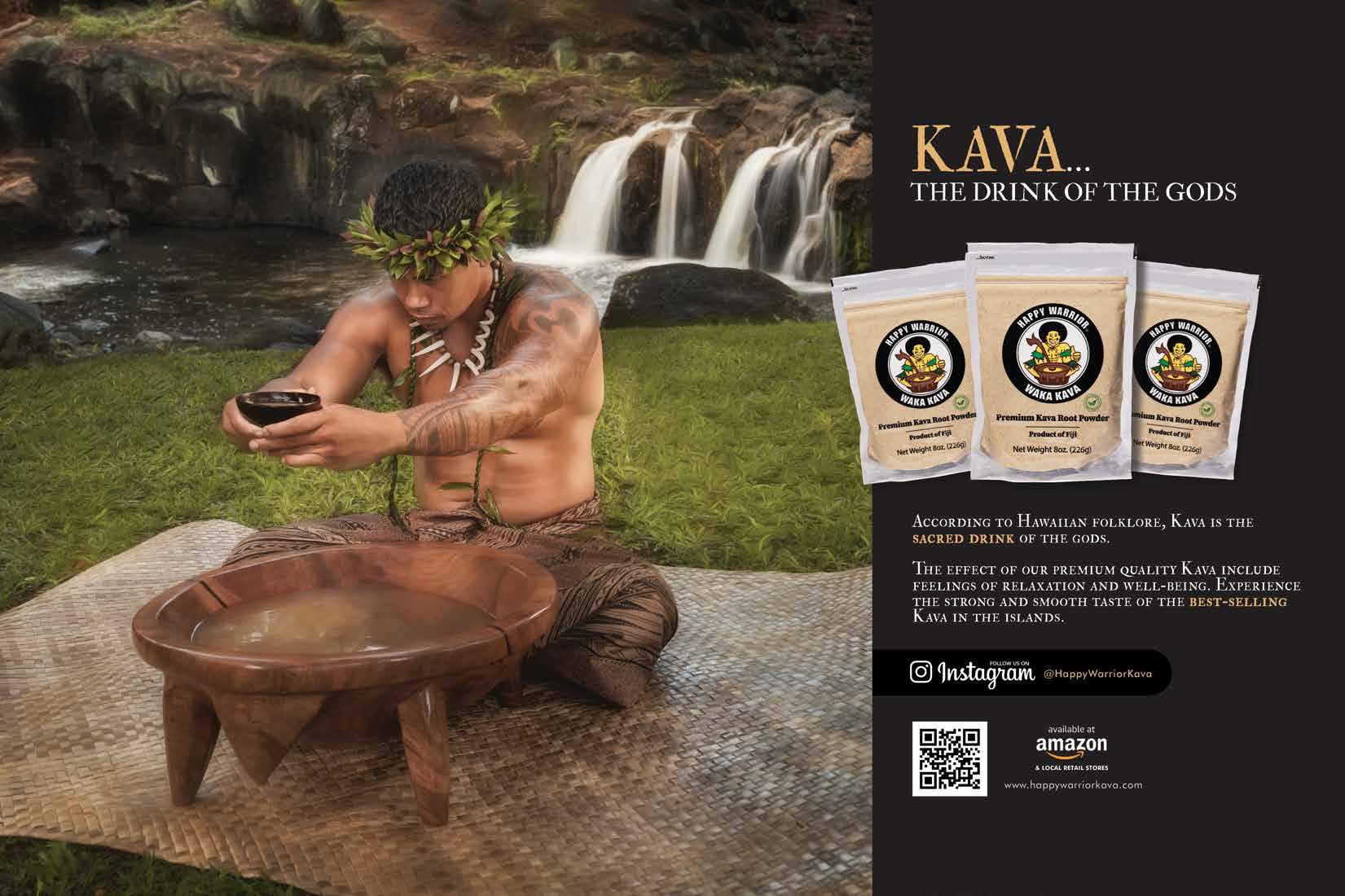

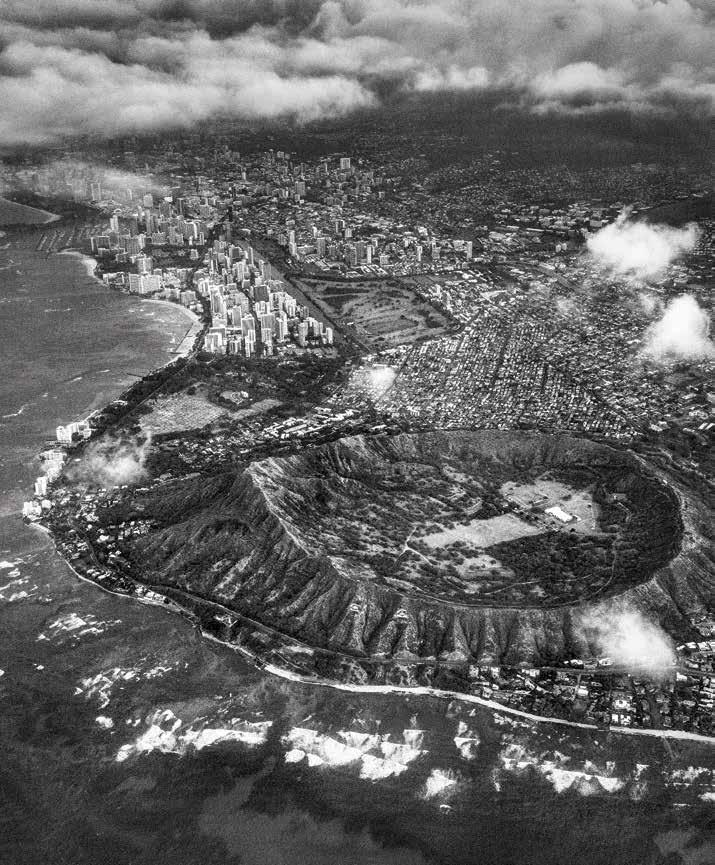
ISLAND BY ISLAND : O‘AHU
112 PHOTOGRAPHY BY PF BENTLEY
LĒ‘AHI (DIAMOND HEAD)—O‘AHU
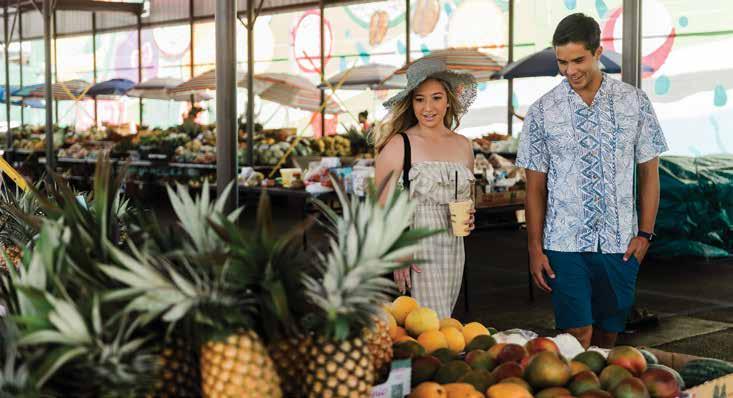
Be here. And there. Go everywhere.
You can pack a lot into an itinerary when you have a set of wheels for your adventure.
Right now, save up to 35% off base rates and earn 1,000 bonus miles* on rentals of two consecutive days or more when you book with Avis and Budget through HawaiianAirlines.com/Cars
*Car reservations must be booked through HawaiianAirlines.com/Cars. Offer valid until Jan. 31, 2025. For complete Terms and Conditions, please visit HawaiianAirlines.com/AvisBudget.


JUNE
KILOHANA HULA SHOW
Sunday through Thursday
A modern take on the historic Kodak Hula Show featuring mele (songs) that honor Waikīkī, and dancers from six awardwinning hālau across Hawai‘i. Presented by the Council for Native Hawaiian Advancement. Free. 9:30 a.m. Tom Moffatt Waikiki Shell, blaisdellcenter.com
BISHOP MUSEUM
AFTER HOURS
Second Fridays
Museum exhibits are open for viewing from 5:30 to 9 p.m., along with cultural demonstrations, keiki activities and a night market with food trucks and local vendors. Bishop Museum, (808) 847-3511
H o MA NIGHTS
Every Friday and Saturday
Honolulu Museum of Art remains open until 9 p.m. with opportunities to explore the galleries, stargaze in the courtyards and enjoy live art experiences and music. Honolulu Museum of Art, (808) 532-8700
MADE WITH ALOHA GIFT FAIR
Every third Saturday and Sunday
Support dozens of small local businesses, selling their handcrafted jewelry, baked goods, unique apparel, charms and more. 10 a.m. to 5 p.m. Free. Pearlridge Center, (808) 689-9091
KĀMAU TRILOGY
Through 6/30
Exploring the concepts of aloha and kuleana (responsibility), this trilogy of plays from Alani Apio follows three cousins raised in their family’s beachside home and their struggle to care for the land in their own ways over the course of many years. Kumu Kahua Theatre, (808) 536-4441
50TH STATE FAIR
Through 7/9
Hawai‘i’s largest carnival helps kick off summer with food, live entertainment, g ames and EK Fernandez rides on the midway. Aloha Stadium, (808) 682-5767
KE KUMU AUPUNI: THE FOUNDATION OF HAWAIIAN NATIONHOOD
Through 8/4
This exhibition celebrates the important publication of the same name by Samuel M ā naiakalani Kamakau. On view will be nineteenth-century drawings, prints and paintings that appear in the book and that tell layered, complex stories. Honolulu Museum of Art, (808) 532-8700
FASHIONING ALOHA
Through 8/18
Fashioning Aloha traces the evolution of aloha wear, from the 1930s to the present. Garments are paired with their textile motifs’ source materials from the museum’s collection, such as kapa (bark cloth), Japanese kimono and a Chinese dragon robe. Honolulu Museum of Art, (808) 532-8700
114 EVENTS: O‘AHU
Fashioning Aloha

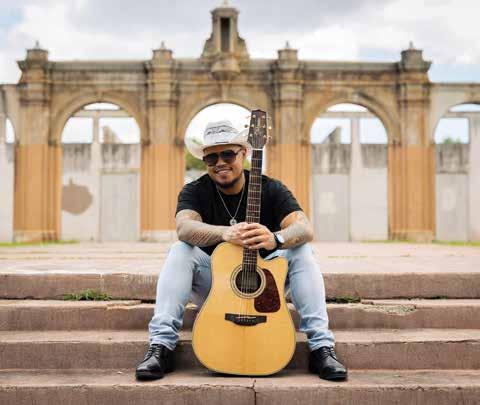
TAYLOR DAYNE
6/1
American pop musician Taylor Dayne’s career spans three decades, starting with her debut single “Tell It to My Heart” in 1987. Blue Note Hawaii, (808) 777-4890
HAWAII’S PLANTATION VILLAGE OBON CELEBRATION
6/1
A night of dancing under the stars featuring taiko drumming, local food favorites, a gift shop, country store and pop-up crafts tent. 6 to 10 p.m. Hawaii’s Plantation Village, (808) 677-0110
FESTIVAL OF PACIFIC ARTS &
CULTURE
6/6–16
The world’s largest celebration of indigenous Pacific Island culture, traditions and artistry. Events include a wa‘a (canoe) arrival, opening and closing ceremony, along with a dynamic festival village and expo at Hawaii Convention Center. Various Locations, festpachawaii.org
ROSEBUD BAKER
6/7&8
New York-based comedian, actress and writer Rosebud Baker was selected as a New Face of Comedy at the Just For Laughs Comedy Festival in 2018. Blue Note Hawaii, (808) 777-4890
PAN-PACIFIC FESTIVAL
6/7–9
An annual three-day celebration of the cultures and people of Japan and the Pacific. Expect an eclectic assortment of cultural arts, crafts, food and stage performances. Waikīkī, panpacificfestival.org
HAWAIIAN STEEL GUITAR FESTIVAL
6/8
This annual festival includes guitar performances from both established masters and the next generation of artists. 11 a.m. Free. Windward Mall, hawaiiansteelguitarfestival.com
KING KAMEHAMEHA FLORAL PARADE
6/8
Floral floats, pā‘ū riders and marching bands traverse the streets of Honolulu beginning at King and Richards streets and ending at Kapi‘olani Park, where a ho‘olaule‘a follows. 9 a.m. to 5 p.m. Honolulu, (808) 586-0300
THUNDERSTORM ARTIS
6/8
Born and raised in a large musical family on the North Shore of O‘ahu, singer, songwriter and multi-instrumentalist Thunderstorm Artis performs original compositions and reinterpretations of classic hits. The Republik, (808) 941-7469
INTO THE SUBCONSCIOUS MIND
6/9–8/4
A magic and mentalism show by Matthew Singer that weaves together neuroscience, psychology and metaphysics with awe-inspiring illusions. Ala Moana Hotel, (808) 944-4333
RYAN HAMILTON
6/13–15
American stand-up comedian Ryan Hamilton has been named one of Rolling Stone ’s Five Comics to Watch. Blue Note Hawaii, (808) 777-4890
RAISE HAWAIKI
6/16
Hawai‘i Symphony Orchestra Presents a musical tribute to Polynesian voyaging depicted in Michael-Thomas Foumai’s masterful oratorio, Hōkūle‘a , weaving together the narratives of voyagers Nainoa Thompson, Eddie Aikau and Mau Piailug. Moanalua Performing Arts Center, (808) 286-3060
H o MA FAMILY SUNDAY
6/16
HoMA offers creative activities for keiki of all ages, community-focused programming and entertainment. Free museum admission for local residents. 10 a.m. to 6 p.m. Honolulu Museum of Art, (808) 532-8700
116
EVENTS: O‘AHU
Maoli
ANDY
BUMATAI & AUGIE T
6/16
Local favorites Andy Bumatai and Augie T co-headline for one night only this Father’s Day. Blue Note Hawaii, (808) 777-4890
KEIKO MATSUI
6/22&23
Contemporary jazz pianist and composer Keiko Matsui’s career spans more than thirty years. Blue Note Hawaii, (808) 777-4890
K-LOVE LIVE IN HONOLULU
6/22
A concert sponsored by American Christian radio network K-LOVE with performances by TobyMac, Crowder, Mac Powell, Cochren & Co. and Terrian. Tom Moffatt Waikiki Shell, blaisdellcenter.com
DAR WILLIAMS
6/27&28
American pop folk singer-songwriter and author Dar Williams’s career spans more than twenty-five years. Blue Note Hawaii, (808) 777-4890
MAOLI
6/28&29
One of Polynesia’s top recording artists, award-winning country reggae group Maoli performs as part of their Boots on the Ground tour. Blaisdell Arena, blaisdellcenter.com
HALE‘IWA ARTS FESTIVAL
6/29&30
This annual festival features artists, musicians, dancers, storytellers, demonstrations and children’s art activities. 10 a.m. to 5 p.m. Hale‘iwa Beach Park, haleiwaartfestival.org
ERIC ROBERSON
6/29&30
Grammy Award-nominee, singer, songwriter, producer, professor and Howard University Alum, Eric Roberson performs. Blue Note Hawaii, (808) 777-4890


JULY
SCREEN ON THE GREEN
Thursdays in July
A free outdoor movie night after the Hale‘iwa Farmers Market. Chairs and blankets are welcome. Films begin at sundown. Waimea Valley Main Lawn, waimeavalley.net
FOURTH OF JULY AT ALA MOANA CENTER
7/4
An annual celebration at Ala Moana Center with live entertainment, discounts, promotions and a fireworks finale show. Ala Moana Center, alamoanacenter.com
MŌ‘ILI‘ILI SUMMER FEST
7/6
Honolulu’s largest bon dance, with food trucks, pop-up shops, keiki games, cultural activities and more. Mō‘ili‘ili, moiliilisummerfesthi.com
ST. PAUL & THE BROKEN BONES
7/6&7
Founded in Birmingham, Alabama, this eight-piece ensemble is known for their unique sound blending soul, funk and disco. Blue Note Hawaii, (808) 777-4890
WAIKIKI STEEL GUITAR WEEK
7/8–13
A week-long event celebrating Hawaiian music and the steel guitar with evening concerts. The event culminates with a festival on Friday and Saturday evenings featuring popular Hawai‘i and Japan steel guitar masters. Royal Hawaiian Center, waikikisteelguitarweek.com
HAWAI‘I ‘UKULELE FESTIVAL
7/14
Live entertainment featuring well-known and emerging artists, an arts and crafters village, and multi-ethnic food court. From 10 a.m. to 5 p.m. Free. Kapi‘olani Park Bandstand, hawaiiukulelefestival.com
HALEY REINHART
7/17
American singer, songwriter and actress Haley Reinhart first rose to prominence on American Idol and is known for her soulful renditions of classic hits. Blue Note Hawaii, (808) 777-4890
CARRIE UNDERWOOD
7/19&20
Eight-time Grammy Award-winning singer Carrie Underwood performs her career hits live in Hawai‘i for the first time. Blaisdell Arena, blaisdellcenter.com

EVENTS: O‘AHU
EVENTS:
CHELSEA HANDLER
7/20
Comedian, television host, best-selling author and advocate Chelsea Handler’s humor and candor have established her as one of the most celebrated voices in entertainment and pop culture. Hawaii Theatre Center, (808) 528-0506
PRINCE LOT HULA FESTIVAL
7/20
Fourteen hālau (hula troupes) from around the state perform in Hawai‘i’s largest noncompetitive hula celebration with activities for people of all ages. Local food and refreshments will be available. Free. 9 a.m. to 4 p.m. Frank F. Fasi Civic Center Park, (808) 839-5334
H o MA FAMILY SUNDAY
7/21
HoMA offers creative activities for keiki of all ages, community-focused programming and entertainment. Free museum admission for local residents. 10 a.m. to 6 p.m. Honolulu Museum of Art, (808) 532-8700
AIR SUPPLY
7/23–28
Soft-rock duo Air Supply are known for their succession of worldwide hits throughout the 70s and 80s. Blue Note Hawaii, (808) 777-4890
RONNY CHIENG
7/26&27
Stand-up comedian, actor and correspondent on The Daily Show Ronny Chieng performs his latest material on The Love To Hate It Tour. Hawaii Theatre Center, (808) 528-0506
INTERNATIONAL ‘UKULELE FESTIVAL OF HAWAI‘I
7/27
Founded by Kazuyuki Sekiguchi, member of Japan’s Southern All Stars, this festival features performances by leading artists from Hawai‘i, Korea and Japan, along with food and craft vendors. 9:30 a.m. to sunset. Free. Kapi‘olani Park Bandstand, ukulelepicnicinhawaii.org
MOLOKA‘I 2 O‘AHU PADDLEBOARD WORLD CHAMPIONSHIPS
7/28
The world’s premier open-ocean paddleboarding race features a 32mile course across some of the state’s roughest seas. Starts at Kaluako‘i Beach on Moloka‘i and finishes at O‘ahu’s Maunalua Bay, molokai2oahu.com
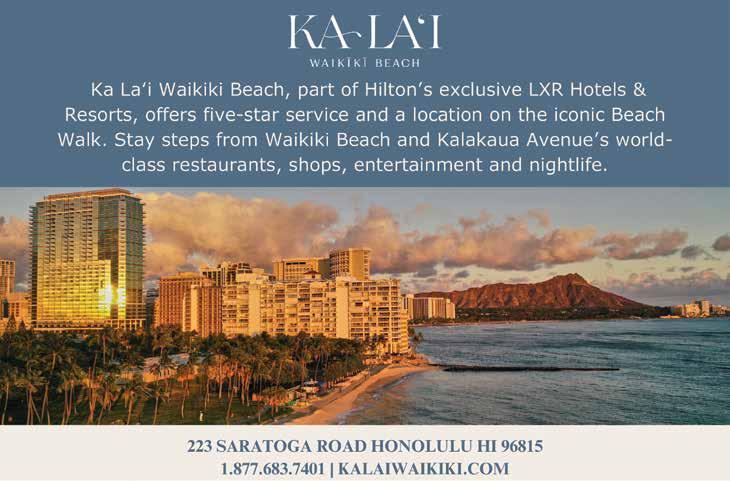
O‘AHU

BATTLESHIP MISSOURI MEMORIAL
Complete your Pearl Harbor experience. The USS Missouri is no ordinary ship—it is America’s most historic battleship. Home to 2,700 sailors, nine 66-foot-long guns, 1,220 projectiles and a deck big enough to host a surrender ceremony presided over by General Douglas MacArthur. Ask about the new Captain’s Tour and Chief Engineer’s Tour. Shuttle service from the Pearl Harbor National Memorial visitors center included with admission.

(808) 455-1600
ussmissouri.org
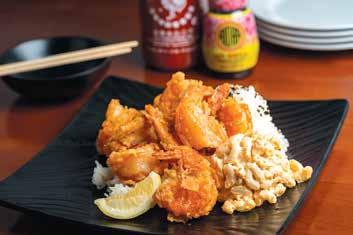
BEASTSIDE KITCHEN
Native Hawaiian owned and operated, the popular bEASTside Kitchen is conveniently located on Oahu. Minutes between Waikiki and the best beaches. Famously known from the tent roadside for its TruckStyle Garlic Umami Shrimp, Guava BBQ Fried Chicken and local home style recipes to our full service restaurant located in East Oahu. Hawaiian musicians Wednesday - Saturday Evenings and Happy Hour food and drinks M-F from 3 to 6pm! bEASTside is a must stop!

(808) 888-0138
bEASTsideKitchen.com
 Arizona Memorial Place, Honolulu
Arizona Memorial Place, Honolulu
5724
Kalaniana‘ole Hwy, Honolulu
EVENTS: O‘AHU
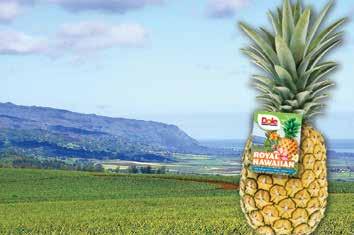

DOLE
O‘ahu
Bring home a bite of paradise! The exotic pineapple has been associated with Hawai‘i & the DOLE® brand for over 100 years. The fertile, volcanic soils of O ’ahu are kissed with Hawaiian sunshine, warm tropical rain and gentle tradewinds, creating the sweeter, juicier DOLE® Royal Hawaiian® Pineapple.

(808) 847-3234 dolefruithawaii.com

HAWAII OCEAN CHARTERS
Hawaii Ocean Charters offer private Waikiki catamaran cruises and shared tours to visitors and locals looking to have an ocean adventure with guides that truly care about your experience. Sunset cruises, guided snorkeling, whale and dolphin watching, coastal sightseeing, and firework shows are among the memorable tours our guests love the most. Use promo code HANAHOU for 10% off!

(808) 400-1506
hawaiioceancharters.com
FARMLOVERS FARMERS MARKETS
Immerse yourself in local food culture at any one of our Farmers Markets. Taste the true Hawai‘i. Experience our local farmers, culinary masters, and artisans. Fresh locally grown produce. Tropical Fruits and Vegetables. Come Hungry! Leave Happy. Our chefs cook healthy, island style grindz. Need a Gift? Our local artisans have you covered. Kaka‘ako (Sat), Pearlridge (Sat), Kailua Town (Sun), Hale‘iwa (Thur).

(808) 388-9696 farmloversmarkets.com
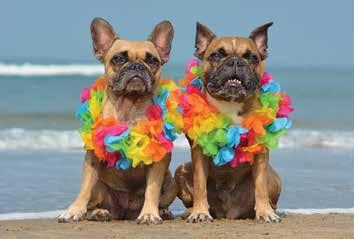
ISLAND PET MOVERS
Honolulu
At Island Pet Movers, we believe that pets are more than just companions; they’re cherished members of our families. We understand that relocating a pet can be a significant and sometimes overwhelming experience. That’s why we’re here to redefine pet relocation, providing a level of care, expertise, and dedication with the spirit of Hawai‘i and Aloha.

info@islandpetmovers.com
islandpetmovers.com
EAT / SHOP / PLAY : O‘AHU PROMOTIONAL
Kaka‘ako, Pearlridge Center, KailuaTown, Hale‘iwa
O‘ahu
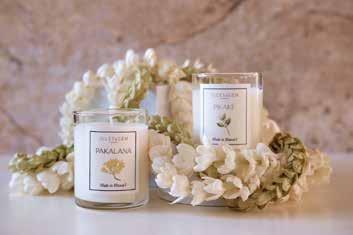

Turn any space into an escape. With Jules & Gem Hawai‘i products, our goal is to bring you back to happy memories of Hawai‘i and bring paradise to wherever you are. We pride ourselves on being locally handmade, right on O‘ahu. Shop our products at multiple resorts and retailers on O‘ahu, Kaua‘i, Maui and Hawai‘i Island—or get them shipped straight to your door by shopping online!
(808) 772-4060 julesandgemhawaii.com
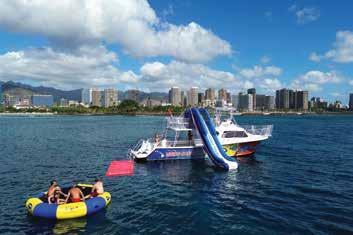
LIVING OCEAN TOURS
1125 Ala Moana Blvd Slip B-01, Honolulu
Get ready for a day of sun, sea, and unforgettable memories with Living Ocean Tours on one of our custom built luxury snorkel boats in Waikiki! Snorkel the crystal waters of Oahu with our Hawaiian Green Sea Turtles, take a thrilling slide down our two-story waterslide, bounce on a water trampoline or cruise into the sunset while looking for whales.

(808) 436-3483 www.livingoceantours.com

LAHA’OLE DESIGNS
Native Hawaiian lifestyle company creating jewelry, clothing and home decor that perpetuates Native Hawaiian culture through modern fashion. Laha’ole shares stories and original designs inspired by Native Hawaiian flora and oral history. Our pieces reflect the island’s beauty and culture. Stand out with meaningful jewelry that shares the spirit of Hawai’i, handcrafted with love.

(808) 349-7794
lahaolehawaii.com
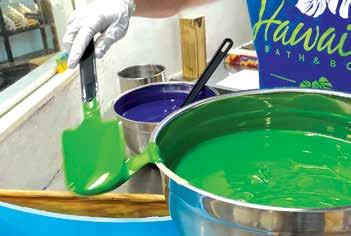
NORTH SHORE SOAP FACTORY
67-106 Kealohanui Street, Waialua
Watch our master soap maker when you visit North Shore Soap Factory! Come for the soap, stay for the stamping. Customize your bar at our stamping station. Book a Behind-the-Scenes Tour* to see how we handcraft Hawaiian Bath & Body® soaps and skin care products. Local art, gifts and more. Find us in the big, coneshaped building!
(808) 637-8400
ISLAND BY ISLAND : O‘AHU North Shore Soap Factory
northshoresoapfactory.com
1121 Bethel St Honolulu


OCEANS END
146 Hekili St #201, Kailua
Elevate your style with Oceans End, pioneers of luxury bags inspired by Hawaii’s captivating beauty. Owned by a native wahine artist and mom, our purses redefine elegance through custom embossing and designs, blending affordability with luxurious style. Embrace class and versatility by exploring our various styles, from totes and backpacks to cross bodies and wallets. We carry a little something for any lifestyle.

www.theoceansend.com @oceansendco

VEIN AT KAKA’AKO
685 Auahi St Building 2 Suite 121, Honolulu
Laidback yet refined, vein at KAKA‘AKO features a modern Mediterranean with Japanese influence created by Executive Chef Dell Valadez. The dishes, such as the Lamb “Scottadito” with Pickled Plum Tapenade and Pistachio pasta topped with Prosciutto di Parma, are intriguing in descriptions and enticing in flavor, making vein the ideal locale for a unique and exceptional dining experience.

(808) 376-4800
veinatkakaako.com
RAINBOW DRIVE-IN
Kapahulu, Kalihi, Pearlridge
Family owned since 1961, Rainbow Drive-In is known for their generous portions of simple, hearty Hawai‘i comfort food. Stop by one of three locations for the best Loco Moco or a delicious plate lunch. After enjoying a famtous Slush Float for dessert, leave with one of our exclusive logo-emblazoned merch items from the Rainbow Tiki shop.

(808) 737-0177
rainbowdrivein.com
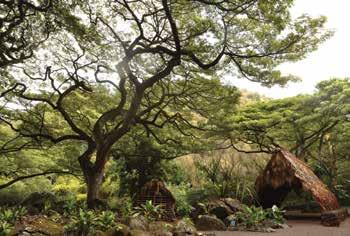
WAIMEA VALLEY
59-864 Kamehameha Highway, Hale‘iwa
Waimea Valley is a wahi pana (storied place) deeply rooted in Hawaiian culture. Today Waimea is home to six cultural sites and 5,000 unique plants from all over the world. Allow the wonders of Waimea to speak to you as you walk through this place of healing. Experience the tranquility and the sites that hark back to a bygone era in Hawai‘i’s history.

(808) 638-7766
waimeavalley.net
EAT / SHOP / PLAY : O‘AHU PROMOTIONAL
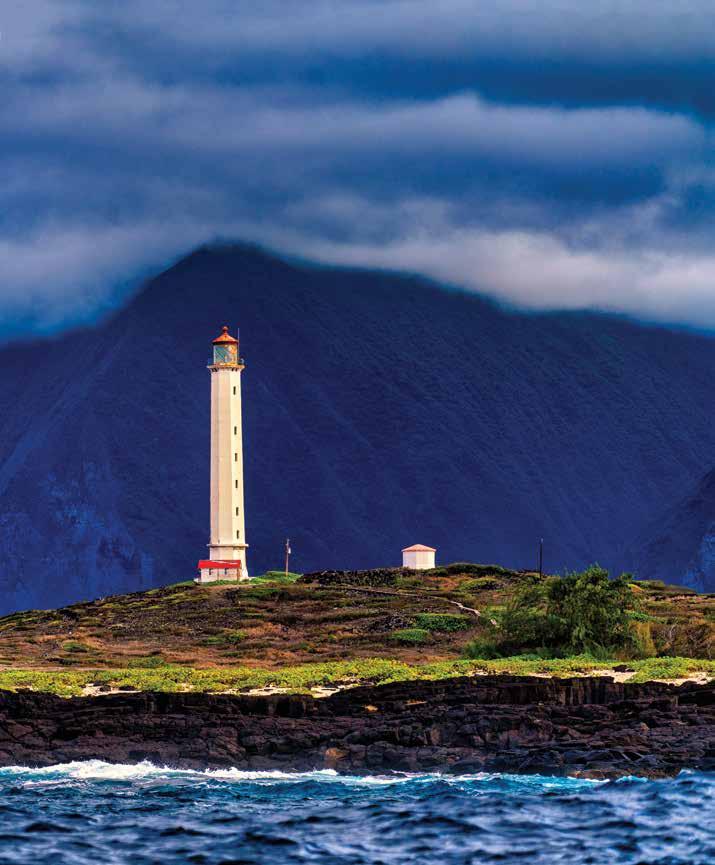
124 ISLAND BY ISLAND : MAUI / MOLOKA‘I / LĀNA‘I PHOTOGRAPHY BY PF BENTLEY
THE MOLOKA‘I LIGHT–KALAUPAPA, MOLOKA‘I
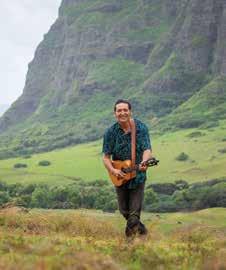
WILDLIFE WEDNESDAYS
Wednesdays
Join naturalists from the Hawai‘i Wildlife Discovery Center every Wednesday and learn about humpback whales, monk seals and more Maui wildlife. 10 a.m. to noon. Whalers Village, (808) 661-4567
JOHN CRUZ
“ISLAND STYLE” SERIES
First and Third Wednesdays
Nā Hōkū Hanohano Award-winning singer-songwriter John Cruz has built his career telling stories through songs about everyday people and experiences. His ongoing Island Style series celebrates the ties that bind. 7 p.m. ProArts Playhouse, proartsmaui.org
KANIKAPILA THURSDAYS
Second and Fourth Thursdays
Maui artists perform live music and families can participate in giant yard games. 5:30 to 7:30 p.m. Queen Ka‘ahumanu Center, (808) 877-3369
HĀNA FARMERS MARKET
Fridays
Locally grown produce and products from East Maui. Free. 65-and-over shopping starts at 2:30, general admission from 3 to 5 p.m . Hāna Town Center, (808) 378-0084

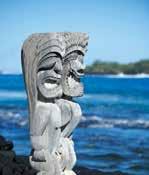
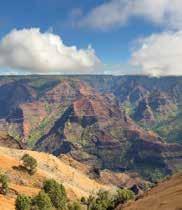

www.PolyAd.com | 1-877-930-1740 Sightseeing Experiences | Custom Groups | Charter Services Your Adventure, Our Aloha JUNE
John Cruz “Island Style” Series

KĪHEI FOURTH FRIDAY
Fourth Fridays
A monthly community street party with food trucks, entertainment, crafters and kids’ games. 6 to 9 p.m. Free. Azeka Shopping Center, kiheifridays.com
UPCOUNTRY FARMERS
MARKET
Saturdays
Locally grown produce, fish, prepared food and products. Free. 7 to 11 a.m. Kulamalu Town Center, (808) 572-8122
QKC
KEIKI CLUB
Third Saturdays
Monthly keiki activities presented by Maui Family Support Services. 10 to 11 a.m. Queen Ka‘ahumanu Center, (808) 877-3369
MAUI SUNDAY MARKET
Sundays
An evening marketplace with local food and product vendors and live entertainment. Free. 4 to 8 p.m. Kahului Shopping Center, (888) 948-6382
MAUI IMPROV MONTHLY SHOWCASE
Last Sundays
Beginner and experienced performers improvise live theater on stage. 6:30 p.m. ProArts Playhouse, proartsmaui.org
LOVEY LEE
Though 6/16
In this coming-of-age story, Lovey finds themself journeying from their safe island home to the invigorating streets of San Francisco to the dark alleys of Hotel Street and back again in their search for place. ProArts Playhouse, proartsmaui.org
MAUI COUNTY AGRICULTURAL FESTIVAL & 4-H LIVESTOCK FAIR
6/1
Highlights include a livestock auction, educational booths, keiki zone, a farmers market and giveaways throughout the day. 9 a.m. to 4:30 p.m. War Memorial Complex, mauicountyfarmbureau.org

EVENTS : MAUI / MOLOKA‘I / LĀNA‘I
Maui County Agricultural Festival & 4-H Livestock Fair
WORLD WHALE FILM FESTIVAL
6/6
An annual festival showcasing films from around the world raising awareness about the ocean, marine wildlife conservation, Indigenous ecological knowledge, environmental stewardship and solutions for the ocean and humankind. Additional online screenings 6/8 through 7/31. Ocean Vodka Organic Farm and Distillery, (808) 877-0009
KAPALUA WINE & FOOD FESTIVAL
6/6–9
World-famous winemakers, master sommeliers, celebrated chefs and industry insiders come together for a series of tastings, festivities and gourmet meals at this nationally acclaimed food and wine extravaganza. Kapalua Resort, kapaluawineandfoodfestival.com
KING KAMEHAMEHA CELEBRATION FLORAL PARADE
6/8
A floral parade through the heart of Kaunakakai starts at 5:30 p.m. and ends with a ho‘olaule‘a at Moloka‘i Community Health Center. Kaunakakai, (808) 658-1888
NĀ KAMEHAMEHA COMMEMORATIVE PĀ‘Ū PARADE
& HO‘OLAULE‘A
6/15
Maui honors the Kamehameha lineage with a parade and ho‘olaule‘a. Pā‘ū parade begins at 9:45 a.m. and runs along Ka‘ahumanu Ave. Ho‘olaule‘a features hula, Hawaiian music, food, keiki activities, exhibits and local crafters and artisans.
9 a.m. to 5 p.m. Queen Ka‘ahumanu Center, (808) 877-3369
MAOLI
6/22
One of Polynesia’s top recording artists, award-winning country reggae group Maoli performs as part of their Boots on the Ground tour. Maui Arts and Cultural Center (MACC), mauiarts.org
KĪ HŌ‘ALU GUITAR FESTIVAL
6/23
Hawai‘i’s top slack key guitar musicians perform in a laid-back setting with local food favorites. Festivalgoers are encouraged to bring their own blankets, mats or beach chairs. Event begins at 3 p.m. MACC, mauiarts.org
JULY
MAKAWAO
RODEO
7/5–7
This annual rodeo includes a parade with pā‘ū riders, classic cars and rodeo royalty, plus a bull bash and other rodeo events. Oskie Rice Arena, (808) 757-3347

PROMOTIONAL EAT / SHOP / PLAY : MAUI / MOLOKA‘I / LĀNA‘I


HE‘E NALU: THE ART & LEGACY OF HAWAIIAN SURFING
7/7–7/21
A small-scale exhibit spanning 2,000 years of surfing history from the earliest stories of surf deities to contemporary works of art and surfing innovations through the lens of thirteen modern Kānaka ‘Ōiwi creatives and cultural practitioners. Pā‘ia Bay Coffee, (808) 280-3554
SEUSSICAL
7/12–8/4
One of the most performed shows in America, Seussical is a musical celebration of the many characters of Dr. Seuss. Historic Iao Theater, mauionstage.com
PADDLE IMUA
7/14
Paddle Imua is an annual multi-discipline paddle race in support of Camp Imua, a week-long recreational camp experience for children with special needs. Maliko Gulch to Kanahā Beach Park, paddleimua.com
CHELSEA HANDLER
7/19
Comedian, television host, best-selling author and advocate Chelsea Handler’s humor and candor have established her as one of the most celebrated voices in entertainment and pop culture. MACC Castle Theater, mauiarts.org
MOLOKA‘I HOLOKAI
7/19&20
A celebration of ocean sports and community featuring a race from Maui to Moloka‘i with festivities to welcome the paddlers on day one, and family friendly events, cultural demonstrations, live entertainment and more on day two. Various locations, molokaiholokai.com
MOLOKA‘I 2 O‘AHU PADDLEBOARD WORLD CHAMPIONSHIPS
7/28
The world’s premier open-ocean paddleboarding race features a 32-mile course across some of the state’s roughest seas. Starts at Kaluako‘i Beach on Moloka‘i and finishes at O‘ahu’s Maunalua Bay, molokai2oahu.com
Makawao Rodeo
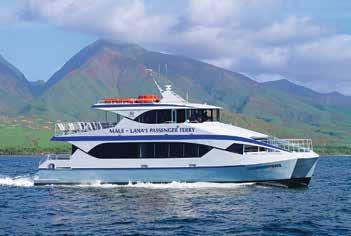

HUI NO’EAU VISUAL ARTS CENTER
Explore the enticing beauty of Lāna‘i with one of EXPEDITIONS ecofriendly, USCG certified, daily cruises. Snorkel, hike, drive, tour or just Lounge on Lāna‘i! Aboard Expeditions, you’ll enjoy spectacular views of Maui County, including the islands of Maui, Lāna‘i, Moloka‘i and Kaho‘olawe. For three decades Expeditions has been providing the most reliable, affordable inter-island travel between Maui and Lāna‘i.
(808) 661-3756 go-lanai.com
Located in Upcountry Maui at the historic Kaluanui Estate, Hui No‘eau Visual Arts Center is a nonprofit, community arts center offering art classes, cultural workshops, exhibitions, and events. Explore the 100-year-old Kaluanui home, enjoy artwork by local artists, or take a self-guided tour of the scenic 25-acre grounds. Supported in part by the County of Maui.

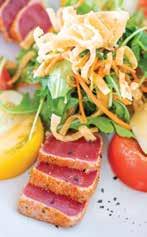

(808) 572-6560
huinoeau.com

SEA-TO-TABLE CUISINE On Napili Bay VOTED BEST OCEANFRONT DINING Hours and More Information at SeaHouseMaui.com Celebrating Over 55 Years of Aloha at Napili Kai Beach Resort 5900 Lower Honoapiilani Rd • Napili • Maui • Hawaii 96761 • 808.669.1500 Breakfast • Lunch • Dinner • Happy Hour EAT / SHOP / PLAY : MAUI / MOLOKA‘I / LĀNA‘I PROMOTIONAL EXPEDITIONS
2841 Baldwin Avenue, Makawao, Maui
Mā‘alaea Harbor (Maui), Mānele Harbor (Lāna‘i)

130 ISLAND BY ISLAND : HAWAI‘I ISLAND PHOTOGRAPHY BY DOUGLAS PEEBLES
MAUNA KEA–HAWAI‘I ISLAND

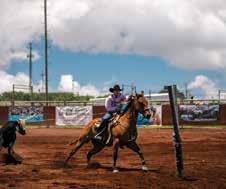
JUNE
NIAULANI NATURE WALK
Mondays
A one-hour nature walk through an oldgrowth Hawai‘i rainforest on an easy loop trail. Walkers are introduced to the native plants and birds of Kīlauea volcano. Free. 9:30 a.m. Volcano Art Center’s Niaulani Campus, (808) 967-8222
PORTUGUESE BREAD BAKING
Thursdays
Observe the traditional art of baking Portuguese bread in a large wood-fired stone oven, or forno. Bread sales begin at 1 p.m. Program begins at 10 a.m. Kona Historical Society, (808) 323-3222
A WALK INTO THE PAST
Fridays
Take a walk back in time to 1912 and meet the founder of the Hawaiian Volcano Observatory, Thomas A. Jaggar, at the edge of Kīlauea volcano. Free. 10 a.m. to noon. Hawai‘i Volcanoes National Park, (808) 985-6000
NIGHT MARKET
Second and Fourth Fridays
Live music, food trucks and dozens of local vendors with Hawai‘i Island products, artwork and other artisanal goods. 4 to 8 p.m. Kings’ Shops in Waikoloa, (808) 886-8811
HALEKI‘I FARMERS MARKET & CRAFT FAIR
First Saturdays
Local crafts and art vendors, keiki entrepreneurs, fresh food, ‘ohanacentered outreach, sustainable-living resources and live music. Free. 9 a.m. to 2 p.m . Kona Grill House, (808) 960-7728
ARTISAN MARKET
Second Saturdays
Local crafters and makers selling gifts, art, crafts and food. 9:30 a.m. to 3:30 p.m . Kona Commons Shopping Center, (808) 854-1439
KAULELE MAHINA
Through 6/9
Uncover the intricate connection between Kaulana Mahina, the Hawaiian lunar calendar and daily life through hands-on experiences in this pop-up exhibit. 9 a.m to 4:30 p.m. ‘Imiloa Astronomy Center, (808) 932-8901
IRONMAN 70.3 HAWAI‘I
6/1
The 70.3 triathlon covers half the distance of the IRONMAN World Championship, which is held in Kona later in the year. Kohala Coast, (808) 329-0063
KA‘Ū COFFEE FESTIVAL
6/1–8
An annual celebration of Ka‘ū coffee with live music, hula, farm tours, guided coffee tastings, keiki activities and educational displays. Pāhala Community Center and other locations, kaucoffeefestival.com
S. TOKUNAGA ULUA CHALLENGE
6/6–9
The largest shoreline fishing tournament in the state includes both barbed and barbless hook categories. Afook-Chinen Civic Auditorium, (808) 935-6965
HAWAI‘I KUAULI PACIFIC & ASIA CULTURAL FESTIVAL
6/7–9
This 3-day event will be packed with food, fashion, cultural expressions, keiki hula, cultural workshops and Fireknife competition. King Kamehameha Kona Beach Resort, hikuauli.com
KĪLAUEA HULA KAHIKO
6/8&7/13
Hula and chant on a sacred site near the Volcano Art Center with Hālau Malanai. Call ahead to confirm the monthly event. 10:30 to 11:30 a.m. Volcano Art Center Gallery, (808) 967-7565
KING KAMEHAMEHA DAY PARADE
6/8
A floral parade through the heart of Kailua-Kona, with pā‘ū riders representing each of the Hawaiian Islands. The parade starts at 9 a.m. and ends with a Ho‘olaule‘a at Hulihe‘e Palace. Kailua Village, konaparade.org
KŌKUA KAILUA VILLAGE STROLL
6/9&7/21
Ali‘i Drive transforms into a festive, pedestrian-only marketplace filled with music and art. At 4 p.m. there is a free Hawaiian music concert at Hulihe‘e Palace. 1 to 6 p.m. Kailua-Kona, (808) 936-9202
NORTH
KOHALA KAMEHAMEHA DAY CELEBRATION
6/11
A day-long cultural festival with floral parade and ho‘olaule‘a (celebration) to honor King Kamehameha in his North Kohala birthplace. North Kohala, kamehamehadaycelebration.org
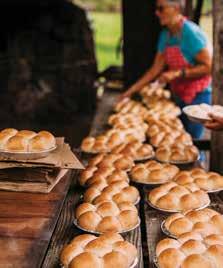
LAUHALA CONFERENCE
6/18–22
Members of Ka Ulu Lauhala o Kona and master weavers from all over the state gather to share knowledge of the ancient art of lauhala weaving through workshops, a craft fair and closing celebration. OUTRIGGER Kona Resort & Spa, kaululauhalaokona.org
EVENTS : HAWAI‘I ISLAND
Parker Ranch Annual Rodeo
132
Portuguese Bread Baking
HILO ORCHID SOCIETY ANNUAL SHOW
6/26–28
The largest and most comprehensive orchid show and sale in Hawai‘i features thousands of orchids, food, Hawaiian music, seminars, a silent auction and a fashion show. Edith Kanaka‘ole Stadium, hiloorchidsociety.org
JULY
HILO BAY BLAST
7/4
An annual all-day celebration with music by the Hawai‘i County Band at 7 p.m. and a fireworks display at 8 p.m. Hilo Bayfront, (808) 961-8706
PARKER RANCH ANNUAL RODEO
7/4
Hawai‘i Island ranchers participate in horse races and rodeo events with Parker Ranch cow- boys. There will be food and mementos for sale. 9 a.m. to noon. Parker Ranch, parkerranch.com
GREAT WAIKOLOA RUBBER DUCKIE RACE
7/4
An all-day fundraiser for United Cerebral Palsy of Hawaii, with a rubber duckie race, live entertainment and a fireworks display over Kings’ Lake. 11 a.m. to 5 p.m. Kings’ Shops at Waikoloa, (808) 886-8811
JAZZ IN THE FOREST
7/13
This bimonthly series highlights local musicians at the Dietrich Varez Hall surrounded by native Hawaiian rainforest. July’s concert is a tribute to George Gershwin. Volcano Art Center’s Niaulani Campus, (808) 967-8222
HAWAIIAN INTERNATIONAL BILLFISH TOURNAMENT
7/26–8/4
This year marks the 62nd anniversary of this storied fishing tournament, in which teams from around the world compete to catch the largest prized Pacific blue marlin. Kailua-Kona, (808) 326-7820



LEGENDARY SHOPPING, DINING & EXPERIENCES Home to Hawai‘i Island’s only Tiffany & Co., Tori Richard and TravisMathew. KINGSSHOPS.COM Redeem for a complimentary beach towel at the Management Office through 7/31/24. While supplies last.

Ā HUALOA FAMILY FARMS
45-3279 Mamane Street, Honoka‘a
Stop by “The Nuthouse” and see what’s crackin’! Ā hualoa Family Farms grows, processes, and produces delicious 100% Hawaiian macadamia nuts and 100% H ā m ā kua coffee in Historic Honoka‘a town, the gateway to Waipi‘o Valley. Come in for free samples, relax on the l ā nai, enjoy a cup of coffee and take home your favorite macadamia nut flavor. See you at The Nuthouse!


‘IMILOA
University of Hawai‘i at Hilo 600 ‘Imiloa Place, Hilo
Embark on a uniquely Hawaiian voyage at ‘Imiloa in Hilo! Immerse yourself in our cutting-edge Planetarium, traverse our interactive Exhibit Hall, and wander through our lush outdoor native garden. Savor farm-to-table dining at Lehua Restaurant, where every bite reflects our diverse land and culture. ‘Imiloa is ideal for family visits, educational experiences, and unforgettable events. Inquire about our membership benefits to make the most of your journey!
ahualoafamilyfarms.com
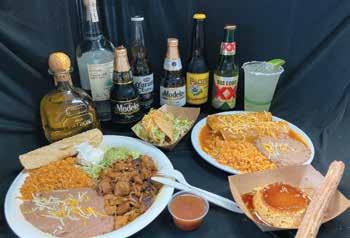
LOS HABANEROS, MEXICAN TAQUERIA
78-6831 Alii Drive #405, Kailua Kona
A family owned and operated Taqueria style Mexican restaurant providing, fast, fresh, authentic Mexican food in Kona since 2004. In addition to the regular menu, specialty items include Chile Rellenos, Tacos al Pastor, Fajitas and Shrimp Vallarta. We also offer many vegetarian and vegan options. Dine in, take it to go, or call in your order for pick up today.

(808) 775-1821 habaneroskona.com

(808) 324-HOTT (4688)
(808) 932-8901
imiloahawaii.org
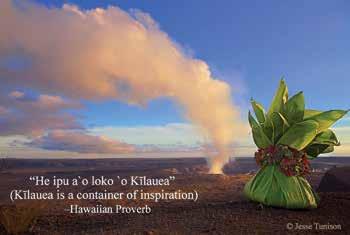
VOLCANO ART CENTER
Volcano, Hawai‘i
Volcano Art Center promotes, develops and perpetuates the artistic, cultural and environmental heritage of Hawai’i through art and education. Celebrate the Past, Present and Future of the Arts as VAC turns 50 in 2024! Become a member to experience exhibits, classes, concerts and ongoing signature programs including Hula Arts At Kīlauea, the Cultural Connections Initiative and Free Guided Forest Tours.

(808) 967-8222
volcanoartcenter.org
EAT / SHOP / PLAY : HAWAI‘I ISLAND PROMOTIONAL

136
ISLAND BY ISLAND : KAUA ‘ I
HANALEI PIER–KAUA‘I
 PHOTOGRAPHY
PHOTOGRAPHY
BY DOUGLAS PEEBLES

JUNE
WAIMEA PLANTATION
LIFESTYLE TOUR
Tuesdays, Thursdays and Saturdays
Walking tours through the Waimea Plantation Cottages and the Waimea Sugar Company “camp” houses, which date from the turn of the twentieth century. Waimea Town, (808) 337-1005
KAUA‘I CULINARY MARKET
Wednesdays
A weekly farmers market featuring fruits, vegetables, flowers and a cooking demonstration. 3:30 to 6 p.m. The Shops at Kukui‘ula, (808) 742-9545
MAKAI MUSIC & ART FESTIVAL
Wednesdays
A weekly gathering with performances by local musicians and an assortment of handmade jewelry, crafts, art and more from local vendors. Free. 1 p.m. to 5 p.m. Makai Lawn, Princeville (808) 318-7338
ALOHA MARKET
Thursdays
Everything from fresh fruits and vegetables to noodles, spices and treats, along with jewelry, clothing, art and more. Hula performance at 12:30 p.m. every week. Free. 10 a.m. to 2 p.m. NTBG South Shore Visitor Center, (808) 742-2623
ALOHA FRIDAY ART NIGHTS
Fridays
Each Friday night Kress Street fills with live art demonstrations. From music to murals, artists share their craft with the community. Kress Street, Līhu‘e, (808) 652-1442
HANAPĒPĒ ART NIGHT
Fridays
Hanapēpē town comes to life with food trucks, street performers, live music and opportunities to talk story with local artists and gallery owners. Free. 5 to 8 p.m. Hanapēpē, hanapepe.org
OLD KAPA‘A TOWN ART WALK
First Saturdays
Food vendors, crafts and treasures from local artisans, and services from local nonprofit organizations along with live multicultural performances. Old Kapa‘a Town, kbakauai.org
HANALEI FARMERS MARKET
Saturdays
Locally grown fruits and vegetables from Kaua‘i’s North Shore along with freshsqueezed juices, locally made honey, fresh-baked goods and arts and crafts. 9 a.m. for seniors, 9:30 a.m. to noon for general admission. Hale Halawai ‘Ohana O Hanalei, (808) 826-1011
ANAHOLA NIGHT MARKET
Last Saturdays
Live music, delicious food and handmade products from over twenty local vendors. 4 to 9 p.m. Anahola Marketplace, (808) 320-7846
PRINCEVILLE FARMERS
& ARTS MARKET
Saturdays
Farm-fresh fruits and veggies, along with local artisans, vintage treasures, live music and more. 9:30 a.m. to 12:30 p.m. Princeville Community Center, bloomandprosperhawaii.com
ALAKOKO PLANT SWAP
Sundays
This weekly market offers plant lovers the chance to buy, sell or trade a variety of greenery. Free. 10 a.m. to 1 p.m. Alakoko Shop, (808) 652-1442
LOCAL TREASURES MARKET
First Sundays
An outdoor market showcasing products from local artisans, crafters, food trucks, bakers and vintage vendors. 9 a.m. to 2 p.m. Kaua‘i Veterans Center, (808) 635-4314
WAILUA BAY CREATORS FAIR
Fourth Sundays
Artisan goods, clothing, accessories, handsewn items, jewelry, photography, wood carvings, home decor and more accompanied by live music and local food vendors. 8:30 a.m. to 1 p.m. Hilton Garden Inn, Kaua‘i, Wailua Bay, (808) 746-2162
DUO DIORAMA
6/1
Violinist Minghuan Xu and pianist Winston Choi perform works by Alfred Schnittke, Béla Bartók, Robert Pollock and others. A free concert presented by Ebb & Flow Arts. 7 p.m. Saint Michael and All Angels Episcopal Church, (808) 876-1854
DRAG RACING
6/1
NHRA drag racing featuring some of the state’s fastest cars. The Jr. Dragsters will highlight this event. 2 p.m. Kauai Raceway Park, dragracekauai.com
TASTE OF HAWAI‘I
6/2
This annual event offers unlimited food and drink plus twelve music ensembles. All proceeds support Rotary Club of Kapa‘a and its multiple projects. 11:30 a.m. to 3:30 p.m. Smith’s Tropical Paradise, tasteofhawaii.net
KAUA‘I SONGWRITERS MUSIC FESTIVAL
6/7&8
A festival convening professional and aspiring songwriters and musical guests for workshops and a concert. Hilton Garden Inn at Wailua Bay, artskauai.org
KAUAI POKE FEST
6/8
Featuring live entertainment, professional and amateur chefs creating unique and delicious dishes for everyone to try, and more than 600 pounds of ‘ahi poke. All proceeds will be donated to The Maui Strong Fund. Koloa Landing Resort, kauaipokefest.com
DOWNTOWN LĪHU‘E NIGHT MARKET
6/8
Locally made crafts, gifts, food trucks, baked goods, live entertainment and more. Featuring more than fifty vendors each month. Free. 4 to 8 p.m. Kress Street, Līhu‘e, (808) 652-1442
EVENTS : KAUA ‘ I
Waimea Plantation Lifestyle Tour
138

PRINCEVILLE NIGHT MARKET
6/9
This monthly festival features live music, pottery, paintings, apparel, jewelry and more than forty local artisans. Free. 4 to 8 p.m . Princeville Shopping Center, (808) 635-2572
KING KAMEHAMEHA DAY CELEBRATION AND PARADE
6/15
This parade and ho‘olaule‘a celebration honoring Hawai‘i’s first sovereign features flower-bedecked pā‘ū riders, hula hālau, live music and more. The event runs from 9 a.m. to 2 p.m. Historic County Building lawn, Līhu‘e, (808) 586-0300
SOTO ZEN BON FESTIVAL
6/21 & 22
The largest bon dance on Kaua‘i. The bon dance is a Japanese Buddhist tradition that honors the spirits of family members who have passed away through joyful music, dance, and community gathering. All are welcome. 5 to 10 p.m. Soto Zen Temple, Hanapēpē, (808) 346-4650
JULY
DRAG RACING
7/7&8
An exhilarating weekend of NHRA drag racing featuring Top Gun cars in the “Battle on the Beach.” 2 p.m. Kauai Raceway Park, dragracekauai.com
GARDEN ISLAND BOOGIE BOARD CLASSIC
7/12–14
This community-based contest joins kūpuna (seniors) and professional bodyboarders to mentor and coach the amateur divisions of the classic. 7 a.m. to 3 p.m. Prince Kūhiō Beach, Kaua‘i, (808) 635-2435
DOWNTOWN LĪHU‘E NIGHT MARKET
7/13
Locally made crafts, gifts, food trucks, baked goods, live entertainment and more. Featuring more than fifty vendors each month. Free. 4 to 8 p.m. Kress Street, Līhu‘e, (808) 652-1442
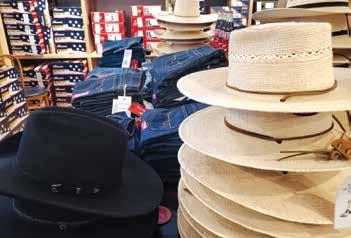
HORSES ARE GOOD COMPANY
4427 Papalina, Kalāheo
A curated boutique and paniolo concept store with an amazing selection of denim, tack, vintage boots, Hawaiian western wear, books, and more. Discover quality products and one-ofa-kind gifts, rare vinyl records, muumuu, palaka, and taste our seasonal selections of kava sodas! Find us in Kalaheo on your next visit to Kauai!
PRINCEVILLE NIGHT MARKET
7/14
This monthly festival features live music, pottery, paintings, apparel, jewelry and more than forty local artisans. Free. 4 to 8 p.m. Princeville Shopping Center, (808) 635-2572
KŌLOA PLANTATION DAYS
7/18–28
This annual celebration honors the plantation heritage and modern-day vitality of Kōloa and Po‘ipū over ten days with a rodeo, festival parade and more. Kōloa, koloaplantationdays.com
HANALEI BAY SWIM CHALLENGE
7/27
A competitive swim fundraiser for Namolokama o Hanalei Canoe Club,

(808) 378-2116 horsesaregood.com

EVENTS : KAUA ‘ I
Plantation in the heart of Lihue. KauaiSweetShoppe.com (808) 245-8458

KAUAI WRITERS CONFERENCE
November 11 to 17 at the Royal Sonesta Kauai Resort
Widely considered to be the premier writing and publishing event in the US, the Kauai Writers Conference includes intimate master classes with bestselling authors and one-on-one sessions with top literary agents and publishers. Hone your writing craft, discover the best paths to successful publication, and build personal relationships with renowned authors. All on beautiful Kauai.

Learn more and register at

KELA’S GLASS GALLERY
4-1400 Kuhio Highway, Kapa‘a
At Kela’s Glass Gallery, it’s all about the glass art. See for yourself the stunning Color Changing Jewelry by the owner Mimi. This impressive gallery features the works of over 150 fine glass artists. Apparently the specialization works. Kela’s Glass Gallery won the prestigious Top Retailer Award from NICHE Magazine voted on by over 10,000 American artists.


SALTY WAHINE GOURMET HAWAIIAN SEA SALTS
1-3529 Kaumuali‘i Highway Unit 2B, Hanapēpē
Salty Wahine Gourmet Hawaiian Sea Salts is a family-owned Kaua ‘ i Made Company that specializes in Kosher Hawaiian Sea salts, seasonings, and tropical sugars using fruit infusions like mango, coconut, guava, passionfruit, dragonfruit, and pineapple. All products are made by hand with Aloha in our Salty Wahine commercial kitchen/factory in Hanap ē p ē , Kaua ‘ i.

(808) 822-4527 kauaiwritersconference.com
(808) 378-4089
saltywahine.com
glass-art.com

TIKI TOES ALOHA STICKERS
Kaua‘i, O‘ahu, Maui, Hawai‘i Island
Keep spreading aloha wherever you are! Tiki Toes is the original aloha sticker company. Made in Hawai‘i. Gratefully celebrating 25 years of our ‘ohana-owned and operated business. Mahalo for sticking with us! Find our classic stickers and temporary tattoos on all islands. Pick any of our authentic designs and show your love for Hawai‘i nei. Available at ABC Stores and other fine establishments statewide. “Eh, sticks on whatevahs!”

info@tikitoes.com
tikitoes.com
PROMOTIONAL EAT / SHOP / PLAY : KAUA ‘ I

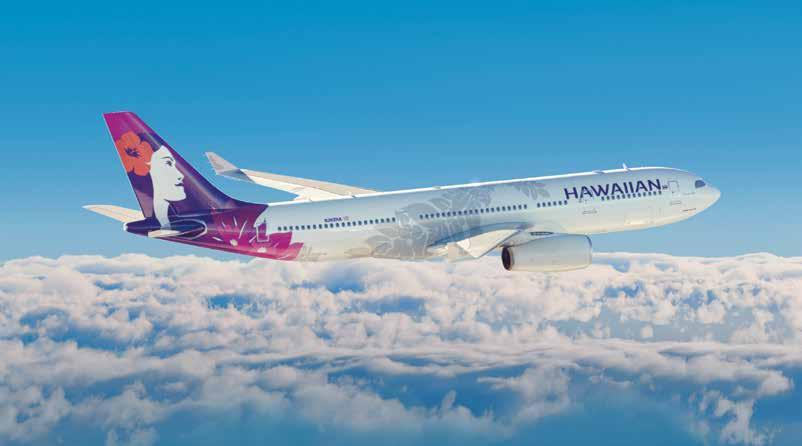
Aloha Welcome aboard
E nanea i kā mākou ho‘okipa, a e luana i ka lele ‘ana!
Please enjoy our hospitality, and have a relaxing flight!
In Hawaiian culture, mea ho‘okipa means "I am your host." This phrase expresses the spirit of hospitality you'll find on our flights, whether you're traveling to the Neighbor Islands, between Hawai‘i and North America or within the Asia-Pacific region. If there is anything that we can do to make your flight more enjoyable, please don't hesitate to let us know.
144 / In-Flight Meals
145 / Streaming Entertainment on A321neo Aircraft
146 / In-Flight Snacks, Souvenirs and Beverages
148 / Terminal Maps
150 / HawaiianMiles Partners
152 / Route Map
154 / The ‘Ohana Pages
ALOHA FROM HAWAIIAN AIRLINES 143
In-Flight Tastes of Hawai‘i
Delicious Complimentary Meals
It’s true. We’re one of the only airlines left in the country to serve you a complimentary meal at mealtime in the Main Cabin. You’ll find Hawai‘i-inspired meals on select flights to and from Hawai‘i, always served with our unique brand of Hawaiian hospitality.


Above top: Wade Ueoka and Michelle Karr-Ueoka
Bottom: Chuck Furuya
Left to right: Chef Eric Oto of Hoku’s at the Kahala Resort and Spa, Chef Robynne Maii of Fete Hawaii, Chef Dell Valdez of vein at Kaka‘ako, Executive Chefs Wade Ueoka and Michelle Karr-Ueoka of MW Restaurant, Chef Chris Kajioka of Miro Kaimuki and Chef Jason Yamaguchi of Mugen Waikiki.
Hawaiian Airlines Featured Chef Series showcases star chefs
Hawaiian Airlines’ in-flight service shares the sights, sounds and tastes of Hawai‘i, and when it comes to our First Class meal service, that means exciting, varied Pacific Rim cuisine with our Featured Chef Series. This esteemed collaboration showcases some of Hawai‘i’s most dynamic chefs creating menus for meals served in our forward cabin.
The Featured Chef Series is overseen by Hawaiian Airlines Executive Chefs Wade Ueoka and Michelle Karr-Ueoka.
Sit back and enjoy Hawai‘i’s vibrant food culture and our distinct onboard experience.
A taste of tradition
Executive Chefs Wade Ueoka and Michelle Karr-Ueoka opened MW Restaurant in Honolulu in 2013. Their cuisine combines inspirations from travels around the world with Hawai‘i’s culinary traditions and local bounty. To sample MW’s latest creations visit their new location at 888 Kapi‘olani Boulevard in Honolulu.
MWRestaurant.com
Wine pairings by our Master Sommelier
Chuck Furuya has a passion for the world’s oldest fermented beverage and holds the distinction of becoming only the tenth person in the United States to pass the rigorous Master Sommelier examination, in 1988. You can find Chuck at Chuck Furuya Uncorked on YouTube.

HO‘OKIPA
144
In-Flight WiFi and Entertainment on A321neo Aircraft
In-Flight WiFi
Our A321neo Aircraft are now equipped with Starlink Internet. It is fast, free internet available for everyone right when you step on board. Switch to Airplane Mode and
• Connect to “ Starlink WiFi on HawaiianAir ”
USAGE GUIDELINES
The following is not permitted with our in-flight internet service:
• No voice or video calls
• No Livestream broadcasting
• No viewing obscene/offensive content
Streaming Entertainment
Guests on our A321 aircraft are also able to stream complimentary entertainment on their personal electronic devices.
Viewing on a Personal Device
IN THE HAWAIIAN AIRLINES APP ˙
1. Once onboard:
• Switch to Airplane Mode
• Connect to “Movies on HawaiianAir” WiFi network
2. Open the Hawaiian Airlines app:
• Select “More” » Select “In-Flight Entertainment”
IN A BROWSER
1. Connect to “Movies on HawaiianAir” WiFi network
2. Open browser and type in URL: HawaiianAirWifi.com
3. Choose from the menu and enjoy!
˙ Supported on IOS 13+ and on Android 8.0+
˙˙ Internet Explorer and Edge browsers are not supported at this time
Mele
Collections to suit your musical tastes
Hawaiian Airlines offers DJ-hosted, curated audio programming devoted to musical styles from across the globe, ranging from award-winning Hawaiian music to jazz and K-Pop.*
FEATURED CHANNELS INCLUDE:
Island Favorites
From the latest award-winning songs to all-time classics, Island Favorites surveys the best in Hawaiian music. This edition includes Anuhea, Kainani Kahaunaele and more.
Wings of Jazz
Pauline Wilson, the Steve Jones Collective and Hot Club of Hulaville are among the featured artists in this exploration of Island jazz.
Classic Jawaiian Rhythms
The melding of Hawaiian melodies with Jamaican rhythms creates a uniquely Island groove, with music by Ka‘au Crater Boys, Ilona Irvine, Marty Dread and others.
Slack Key Serenity
Wayne Takamine, Kevin Hopkins and George Kahumoku Jr. are among the kī ho‘alu masters showcasing varied interpretations of the Hawai‘i-born slack-key guitar style.
*Available only on A330 and A321neo aircraft.


145 HO‘OKIPA
Anuhea (left) and Kainani Kahaunaele (right).
Noho Home x Hawaiian Airlines
We are proud to partner with Noho Home by Jalene Kanani on the limited edition Leihōkū Collection. Products are available while supplies last.
Products may also be available at NohoHomeHawaii.com. Prices may vary.

Travel Blanket ˙˙
Reusable Cleaning Cloths (3)
Chopsticks (5 pairs)
Travel Wrap
$18.00
$12.00
$12.00
$16.00
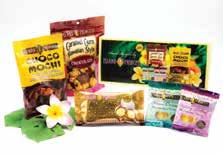
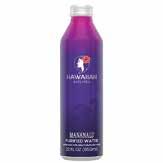
Mananalu Water in Keepsake Hawaiian Airlines Reusable Aluminum Bottle, 22 oz ˙˙
In-Flight Snacks and Souvenirs
Pau Hana Snack Cart
Keepsake blanket, popular local snacks, souvenirs and sundries are available from the Pau Hana Snack Cart. Cabin crew will advise when the cart is heading down the aisle on domestic flights or is open in the galley on Australia and New Zealand flights.
Selections and quantities are limited and may vary. To print receipts of in-flight purchases, visit HawaiianAirlines.com/receipts.
Popular Local Snacks
Mananalu Water in Keepsake Hawaiian Airlines Reusable Aluminum Bottle, 22 oz ˙˙
Hawaiian Chip Company Taro and Sweet Potato Chips
Island Princess Caramel Macadamia Nut Popcorn
Kona Chips Furikake Chips
Samurai Furikake Popcorn
Snack Packs ˙
Made in Hawai‘i Snack Sampler K
Choco Caramel Popcorn, Choco Mochi, Lightly Salted and Maui Onion Macadamia Nuts, Mele Mac
Classic Snack Box GF
Crackers, Chickpeas, Turkey Stick, Hummus, Gummies, Sweet Treat
Keiki (Child) Snack Box GF Cheese Puffs, Granola Minis, Turkey Stick, Applesauce, Gummies, Sweet Treat
‘Ono Snack Box GF Salami, Cheese Spread, Dried Fruit, Olives, Crackers, Sweet Treat
Cheese Tray with Crackers and Dried Fruit
Classic Snacks
M & M’s Peanut
Maruchan Cup Ramen Chicken
Pringles K
Noho Home Travel Blanket
Ear Buds with Hawaiian Airlines Zipper
146 HO‘OKIPA
Made in Hawai‘i Snack Sampler
Sundries
˙˙
˙˙ Hawaiian Airlines Blanket and Pillow Set ˙˙
Case
$5.00 $8.50 $7.50 $9.50 $8.00 $11.00 $8.00 $8.00 $8.00 $7.00 $3.50 $4.50 $4.50 $18.00 $4.00 $11.50
In-Flight Beverages
Juices
Passion-Orange-Guava* (POG)
Pineapple Orange Nectar / Apple / Orange
Mott’s Tomato / Mr. & Mrs. T Bloody Mary Mix
Hot beverages
Lion Coffee* / Tea
Soft drinks
Coke / Diet Coke / Sprite
Diamond Head Strawberry Soda
Canada Dry Ginger Ale
Milk (Lowfat or Whole)
Club Soda / Tonic Water / Flavored Sparkling Water
Cocktails
Mai Tai (Kō Hana)
Pineapple Daiquiri** (Kō Hana)
Aviation** (On the Rocks)
Old Fashioned** (On the Rocks)
Spirits
Rum (Koloa Rum)
Vodka (Ocean)
Scotch (Dewars)
Whiskey (Jack Daniel’s)
Gin (Tanqueray)
Hard Seltzer Dragon Fruit** (Maui Brewing Co.)
Koloa Pineapple Passion*** (Koloa Rum)
Wines & Champagne
Summer Club Pogmosa Sparkling White Wine with Passionfruit, Orange, Guava
Mionetto Prosecco Sparkling Wine Split
Woodbridge Cabernet Red Wine Split**
Benton Hills Cabernet Red Wine Half Bottle
Woodbridge Chardonnay White Wine Split**
Benton Hills Chardonnay White Wine Half Bottle
Red or White Wine Glass***
Beers
Big Swell IPA (Maui Brewing Co.)
$10.00 $10.00
Bikini Blonde Lager** (Maui Brewing Co.)
Da Hawai‘i Life Lite Lager (Maui Brewing Co.)
Heineken**
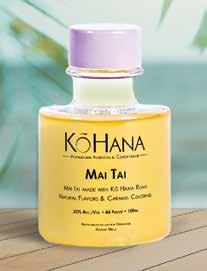

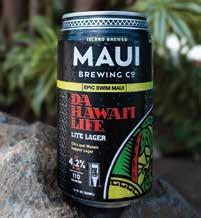
Complimentary beverages provided by
*Complimentary on Neighbor Island flights.
**Available for purchase on Neighbor Island flights. ***Complimentary glass of wine on flights to/from New York, Boston, Austin. Complimentary glass of Koloa Pineapple Passion on flights to/from West Coast North American cities. $8 per glass thereafter.
All beer, wine, champagne and spirits available for purchase on North American flights. Complimentary in First/Business Class.
Alcoholic Beverages
Only alcoholic beverages provided by Hawaiian Airlines and served by Flight Attendants may be consumed on board the aircraft. No alcoholic beverages will be served to persons who appear intoxicated or to those under 21 years of age.
Hawaiian Airlines’ complimentary items may change or vary from time to time, and availability can be affected by aircraft schedule changes.
Beverage menu is subject to change. Some items may not be available on all flights and/or classes of service. Beverage availability is limited. Beers, wines, spirits, snacks and sundries are available for purchase with major credit/debit cards only.
˙ Snack box components are subject to availability. Please see snack box for list of included items.
˙˙ Available on select North America flights only.
GF Gluten-Free
K Kosher
147 HO‘OKIPA
$9.00 $19.00 $9.00 $19.00 $8.00
$10.00 $10.00
$9.00 $9.00 $9.00 $9.00
$10.00 $10.00 $9.00 $9.00 $9.00 $9.00 $9.00 $9.00 $8.00
TERMINAL MAPS 148 E10 E11 E12 E9 E8 E7 E6 E5 E4 JetBlue codeshare flights operate from Terminal C Hawaiian Airlines flights use Terminal E, Gates E10-E12 B OS I Bo st on Loga n In t erna t io n al Airp o r t E3 E2 E1 E1A C8 C9 C10 C11 C15 C16 C17 C18 C19 C22 C20 C21 C14 C12 C28 C26 C27 C36 C34 C32 C30 C29 C31 C33 C25 C24 C23 TERMINAL E TERMINAL C Gates A13 A1 A2 A3 A4 A5 A6 A7 A8 A9 A10 A11 A12 A14 A15 A16 A17 A18 A19 A20 D2 D1 E1 E3 E5 E7 E2 E4 E6 E9 E10 E8 F1 F2 G1 G2 G3 G4 G5 G6 C1 C2 C3 C5 C4 C6 C7 C8 C9 B1 B2 B4 B3 B5 Parking Parking Parking Wiki Wiki Shuttle Wiki Wiki Shuttle Wiki Wiki Shuttle LOBBY 2 LOBBY 3 LOBBY 4 LOBBY 5 LOBBY 6 LOBBY 7 LOBBY 8 Gates Continental U.S. & International Departures Gates Continental U.S. & International Departures Customs Third Floor Neighbor Island, Continental U.S. & International Departures Gates Second Floor PREMIER CLUB LOBBY 3 International and Neighbor Island Check-in LOBBY 2 Continental U.S. Check-in
Ho no lulu Da n iel K I n ou ye In t erna t io n al Airp o r t • Check-in for our non-stop Japan flights is at Lobby 4 • Check-in for all International and Neighbor Island flights is at Lobby 3 • Check-in for our Continental U.S. flights is at Lobby 2 LOBBY 4 Japan Flights Check-in
HNL I
I
TERMINAL MAPS TERMINAL MAPS 149 114 149 14 8 147 14 6 145 14 4 143 142 14 0 141 113 112 110 111 109 108 Gates 105 -107 HND
Tokyo Ha ned a In terna tio nal Airpo rt INTERNATIONAL TO DOMESTIC 1. Collect baggage and proceed to Customs clearance. 2. Check in at the JAL Domestic Connection Counter on Level 2 3. Proceed through the domestic transfer security inspection area. 4. Take the escalator down to the JAL Domestic Transfers bus stop. Exit the bus at Domestic Terminal 1 INTERNATIONAL TO INTERNATIONAL
If you HAVE NOT checked in to your final destination at your departure airport, go to the International Transfers Counter just before Immigration.
All travelers must go to the Security Inspection Area (entrance next to the Transfers Counter) before heading to Departures on Level 3 For more information regarding transfers, please visit HawaiianAirlines.com INTERNATIONAL TERMINAL 3 JFK
John F. Kennedy International Airport Hawaiian Airlines Baggage Claim Level 1 TERMINAL 4 Level 3 Gates A2-A7 and B23 TERMINAL 5 Level 3 Gates 1-30 A2 A3 A5 A7 A4 A6 15,16 14 12 9 10 11 8 7 6 1 17 18 19 20 21 22 23 24 25 27 26 29 28 30 TSA/Security Checkpoint Level 3 Exit Security Level 1 Guests on JetBlue codeshare flights will need to transfer from Terminal 4 to Terminal 5. Please follow the yellow dotted-lined pathway as shown in the map below. Expected time is 45 minutes (15 minute walk, and time for AirTrain
security). Hawaiian Airlines Check-In Level 4 AirTrain Level3 AirTrain Level 3 SkyWalk Level 4 to Gates B24-B55 5 4 3 2 Gates B23 B20 B22 TERMINAL 4 Gates 40-49 TERMINAL 5 Gates 50-59 Tunnel Level Tunnel Level 210B 210A 209A 207 205 208 206 204 202 221 225 • Guests on JetBlue codeshare flights will need to transfer from Terminal B to Terminal 5. • Please follow the dotted-lined pathway as shown in the map above (minimum 30 minute walk). 209B 201B Gates 201-225 Fourth Floor TERMINAL 4 Connector UPPER LEVEL TERMINAL B Gates 130-225 Check-In Third Floor Baggage Claim First Floor to TERMINAL 6 Basement Level
Los A ngele s In te rnati onal Ai rp ort 203 201A 134 132 130 148 150 Gates E2 E4 E6 E10 E8 F1 F2 G1 G2 G3 G4 G5 G6 Parking Wikiwiki Shuttle LOBBY 6 LOBBY 7 LOBBY 8 Check-in for all International and Neighbor Island flights is at Lobby 3 Check-in for our North America flights is at Lobby 2 D40 D38 D36 D34 D32 D50 D16 D51 D18 D26 D25 D24 D23 D22 D21 D20 D19 D17 D4 D6 D8 D10 D11 D12 D14 D9 D7 D5 D3 D1 D53 D52 D54 55 D59 37 D35 D33 Terminal 1 Tram To Terminal 3 and E-Gates AS I La s Vegas Harry Reid In terna tio nal Airp or t CONCOURSE D NRT I Tokyo Narita International Airport TERMINAL 4 Gates 40-49 TERMINAL 5 Gates 50-59 Tunnel Level Tunnel Level 210 (A/B) 208 207 205 203 206 204 202 221 225 • Guests on JetBlue codeshare flights will need to transfer from Terminal B to Terminal 5. • Please follow the dotted-lined pathway as shown in the map above (minimum 30 minute walk). Hawaiian Airlines flights use Gates 201-225. 209 (A/B) 201 (A/B) Gates 201-225 Third Floor TERMINAL 4 Connector UPPER LEVEL TERMINAL B Gates 130-225 Check-In Third Floor Baggage Claim First Floor to TERMINAL 6 Basement Level L AX I Los Angeles International Airport 114 148 147 146 145 144 143 142 141 113 112 110 111 109 108 Gates 105 -107 HND I Tokyo Haneda International Airport INTERNATIONAL TO DOMESTIC 1. Collect baggage, if necessary, and proceed to Customs clearance. 2. Check-in at the JAL Domestic Connection Counter on Level 2 3. Proceed through the domestic transfer security inspection area. 4. Take the escalator down to the JAL Domestic Transfers bus stop. Exit the bus at Domestic Terminal 1 INTERNATIONAL TO INTERNATIONAL • If you HAVE NOT checked in to your final destination at your departure airport, go to the International Transfers Counter just before Immigration. • All travelers must go to the Security Inspection Area (entrance next to the Transfers Counter) before heading to Departures on Level 3 For more information regarding transfers, please visit HawaiianAirlines.com INTERNATIONAL TERMINAL 3 75 76 77 82 92 94 96 84 86 88 87 85 83 81 91 93 95 97 99 98 74 73 72 71 61 62 63 64 65 66 67 68 TERMINAL 3 TERMINAL 2
I
•
•
and
LAX I
Earn bonus HawaiianMiles ® and


Tori Richard
Discover resort wear inspired by the colors and beauty of the Islands.
Earn 3 bonus miles per $1 spent when using your Hawaiian Airlines® Mastercard® or Bankoh Hawaiian Airlines® Visa® Debit Card.1



Kahala
Refresh your wardrobe by shopping at Kahala in-store or online.
Earn 3 bonus miles per $1 spent when using your Hawaiian Airlines® Mastercard® or Bankoh Hawaiian Airlines® Visa® Debit Card.1


Lanikai Juice Hawaii
Experience the best in fresh, healthy smoothies, juices and fruit bowls.
Earn 2 bonus miles per $1 spent when using your Hawaiian Airlines® Mastercard® or Bankoh Hawaiian Airlines® Visa® Debit Card.1
Kualoa Ranch
Tour this iconic destination on horseback, e-bike, boat or UTV. And don’t miss the Jurassic Zipline. Earn 5 bonus miles per $1 spent when using your Hawaiian Airlines® Mastercard® or Bankoh Hawaiian Airlines® Visa® Debit Card.1
1 Hawaiian Airlines® Mastercard® includes Hawaiian Airlines® World Elite Mastercard® and Hawaiian Airlines® Business Mastercard®. Partner bonus miles earned through this offer are in addition to standard miles earned using Hawaiian Airlines® Mastercard® or Bankoh Hawaiian Airlines Visa Debit Card. Partner bonus miles are not awarded on debit card PIN transactions. No miles are awarded on cash back transactions. Please allow 4-6 weeks for miles to post to your HawaiianMiles account. HawaiianMiles standard terms and conditions apply. Additional restrictions may apply, see partner for details. Barclays Bank Delaware and Bank of Hawaii are not affiliated with the merchants participating in the HawaiianMiles Marketplace. Please log in to your account to view your Reward Rules for more information about the rewards associated with your account. The Hawaiian Airlines Mastercard is issued by Barclays Bank Delaware pursuant to a license from Mastercard International Incorporated. Mastercard, World Mastercard, World Elite Mastercard, and the circles design are registered trademarks of Mastercard International Incorporated. The Bankoh Hawaiian Airlines Visa Debit Card is used by Bank of Hawaii. VISA is a registered trademark of Visa International Service Association and used under license.

bring your next adventure closer
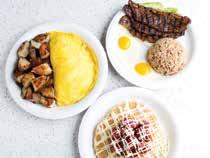
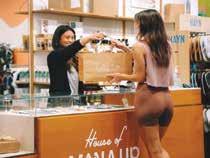
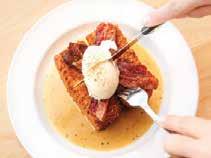


Koa Pancake House
Enjoy traditional breakfast and lunch plates with Island flair.
Earn 2 bonus miles per $1 spent when using your Hawaiian Airlines® Mastercard® or Bankoh Hawaiian Airlines® Visa® Debit Card.1

House of Mana Up
Support Hawai‘i entrepreneurs at this one-stop shop for products and gifts from the Islands. Earn 2 bonus miles per $1 spent when using your Hawaiian Airlines® Mastercard® or Bankoh Hawaiian Airlines® Visa® Debit Card.1

Koko Head Café
Visit this delicious Island-style brunch house and earn 2 bonus miles per $1 spent when using your Hawaiian Airlines® Mastercard® or Bankoh Hawaiian Airlines® Visa® Debit Card.1

Uncle Sharkii Poke Bar
Find poke paradise here, where fresh, high-quality ingredients go into every poke bowl. Earn 2 bonus miles per $1 spent when using your Hawaiian Airlines® Mastercard® or Bankoh Hawaiian Airlines® Visa® Debit Card.1
Visit Partners.HawaiianAirlines.com to learn more about earning bonus miles at thousands of locations nationwide.
ISLAND STYLE BRUNCH HOUSE
SOUTH KOREA
PHILIPPINES
AUSTRALIA
VIETNAM CAMBODIA MALAYSIA THAILAND CHINA
INDONESIA PAPUA NEW GUINEA NEW ZEALAND AMERICAN SAMOA JAPAN Tokyo / Haneda Tokyo / Narita Osaka / Kansai Pago Pago Seoul / Incheon Taipei Miyako Jima Ishigaki Guangzhou Sapporo / Chitose Sydney Brisbane Auckland Naha /Okinawa Guam Shanghai /Pudong Hong Kong Busan Osaka / Itami Seoul/Gimpo Dalian Komatsu Akita Niigata Yamagata Aomori Hanamaki Sendai Misawa Kushiro Obihiro Hakodate Memanbetsu Asahikawa Nagoya Izumo Hiroshima Kitakyushu Fukuoka Nagasaki Kumamoto Amami Oshima Shanghai/Hongqiao Kagoshima Miyazaki Matsuyama Kochi Takamatsu Tokushima Okayama Nanki Shirahama Oita Ube Bangkok Ho Chi Minh City Manila Hanoi Jakarta Kuala Lumpur Singapore Queenstown Melbourne Sunshine Coast Gold Coast Ballina Byron Cairns Launceston Hobart Perth Adelaide Beijing HAWAIIAN AIRLINES ROUTE MAP 152


Partners: Codeshare Partners: Hawaiian Airlines has 65 Interline Partners across the globe. Some international routes behind and beyond Japan pending receipt of government operating authority Not all routes operate year-round. TA H ITI NORTH AMERICA MEXICO KAUA‘I O‘AHU MAUI HAWAI‘I ISLAND HAWAI‘I MOLOKA‘I LANA‘I NI‘IHAU KAHO‘OLAWE PUERTO RICO
COOK ISLANDS Papeete Rarotonga San Jose San Francisco San Diego Long Beach Sacramento Portland Phoenix Austin Ontario Oakland Reno Las Vegas Los Angeles Seattle New York / Kennedy
Interline
CANADA
Kahului Kailua-Kona Kailua-Kona Hilo Lı hu‘e Honolulu Honolulu Lıhu‘e Portland Boston Nantucket Martha’s Vineyard Raleigh-Durham Charlotte RichmondWashington D.C./Reagan Philadelphia Charleston Orlando Savannah Atlanta Nashville Jacksonville West Palm Beach Fort Lauderdale Miami San Juan Tampa Fort Myers Rochester Buffalo Detroit Chicago Cleveland Pittsburgh Syracuse Newark Salt Lake City 153
Kahului
The ‘Ohana Pages

first of Hawaiian Airlines’ fleet of Boeing 787-9 Dreamliner aircraft
in service by the end of 2024, with another nine to follow.
Welcoming Kapuahi
Last February, we greeted our first Boeing 787-9 Dreamliner, which arrived in Honolulu after a delivery flight from South Carolina. “This day has been a long time coming—in fact, today marks almost six years to the day since we first announced our investment in the 787-9 as the new flagship fleet for our company,” said Peter Ingram, president and CEO of Hawaiian Airlines, during his welcome remarks. “Mahalo to Boeing for working collaboratively with us as we adjusted the delivery schedule and to our entire 787-9 team for managing our project and getting our first aircraft to its new home here in Honolulu.”
Leadership from Hawaiian and Boeing joined employees and local dignitaries at the Charles I. Elliott Maintenance and Cargo Facility for a special ceremony to induct the airplane then known as N781HA. Students from Windward O‘ahu’s Mālama Honua Public
Charter School opened the event with an ‘oli (chant), followed by remarks from special guests and a formal Hawaiian blessing of the aircraft.
“From the moment you step on board, you’ll see that Hawaiian culture is woven into the design of this 787 Dreamliner. It immediately connects passengers to the beauty of the Islands,” said Darren Hulst, vice president of commercial marketing at Boeing. “It’s an honor to know this airplane will bring Hawai‘i to the world for years to come.”
Over 1,500 employees and their guests joined the festivities, which included live music from slack key guitarist Kawika Kahiapo and guided tours of the 787-9. From the look and feel of its interior to each plane’s naming, nearly every element of our new fleet celebrates early Polynesian voyagers, who navigated the Pacific by observing the stars, sun, winds, waves and wildlife. Nods to Hawai‘i’s natural environment are also abundant, from wall panels in
native wood grains to the lavatory flooring inspired by shimmering black volcanic sand. Laminates and fabrics reflect the forms of native Hawaiian plants. Guests will also experience ‘ōlelo Hawai‘i (Hawaiian language) as they locate their seat row number and reference other placards installed throughout the airplane.
The 300-seat Dreamliner also features Hawaiian’s newest premium product, the Leihōkū Suites: 34 suites that envelop guests in a tranquil space with lie-flat seating, an 18-inch in-flight entertainment screen, personal power outlets, wireless cell phone charging and direct aisle access. Set in a 1-2-1 configuration, the suites offer privacy or a shared experience with combinable double suites that allow couples to fall asleep while gazing at a starlit ceiling. (Leihōkū translates as “garland of stars.”) Every aircraft in Hawaiian’s fleet is given a culturally significant name. For our long-haul, widebody aircraft, these names come from stars and constellations used
HAPPENINGS AT HAWAIIAN AIRLINES 154
The
arrived in Honolulu in February. The airline expects to have three 787-9s

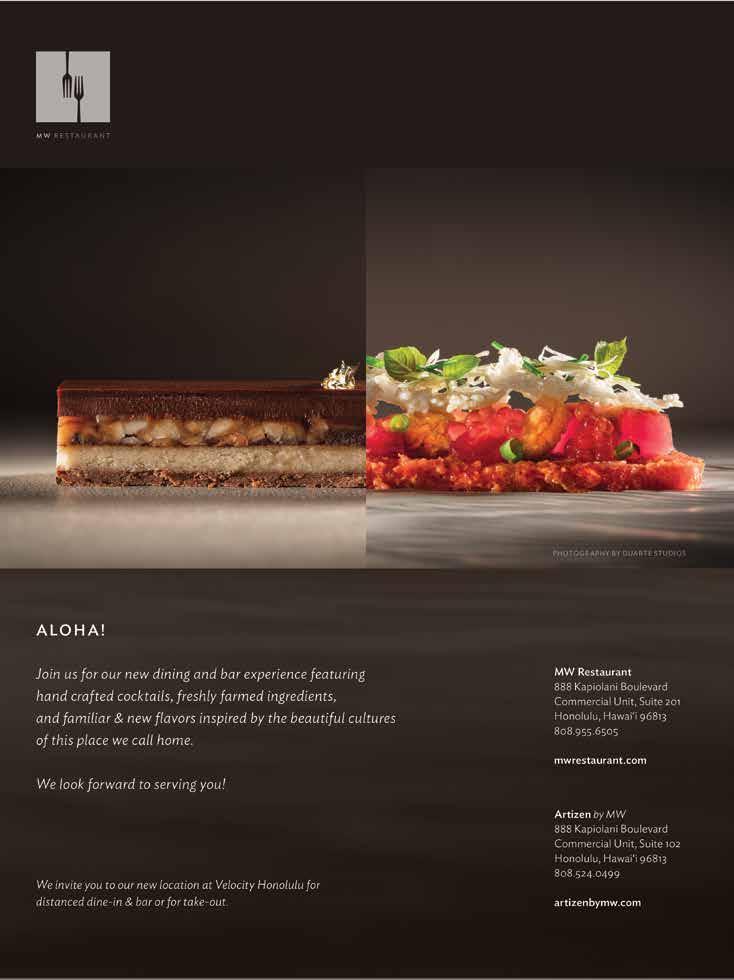

in the traditions of Polynesian navigators. N781HA’s permanent name, Kapuahi, was unveiled during the welcoming ceremony. Kapuahi is a red giant star known as Aldebaran in Western astronomy. It is the brightest star in the constellation Taurus and appears in the Pacific sky alongside Makali‘i, a celestial cluster of great importance in Hawaiian storytelling, wayfinding and agriculture.
“As we journey across the Pacific and take people to and from Hawai‘i on our planes, it is in the same spirit and tradition of Hawaiian voyaging,” explained Debbie Nakanelua-Richards, director of community and cultural relations at Hawaiian Airlines. “Our kinship with voyaging is rooted in our past, grounds us in our present and guides us toward our future. This connection is reflected in the design of our Boeing 787-9s, which further this effort to mingle with the stars and look to the constellations for direction, as wayfinders often do in the canoe.”
Starlink Debuts
Staying connected on a Hawaiian Airlines flight between the US Mainland and Hawai‘i, one of the most geographically remote archipelagos in the world, is becoming as effortless as using your home internet, thanks to Starlink’s advanced internet technology. In February, we became the world’s first major carrier to deploy Starlink’s high-speed, lowlatency broadband internet on a flight from Honolulu to Long Beach. This new service, which is rolling out first on our A321neo aircraft, is complimentary and available the moment guests step on board, without tedious registration pages or clunky payment portals.
“In marrying this best-in-class technology with our authentic Hawaiian hospitality, we are offering our guests a travel experience unlike any other airline flying to and from the Hawaiian Islands,”
said Chris Liebertz, senior director of engineering at Hawaiian Airlines.
Starlink’s speed allows streaming, gaming and other connected experiences often enjoyed at home, while traversing the farthest reaches of the Pacific Ocean. “Starlink’s self-designed aviation terminal, installed on Hawaiian’s aircraft, allows each plane to receive strong, fast internet signals from orbiting satellites,” said Will Seidel, director of Starlink engineering at SpaceX. “The terminal will seamlessly switch connections from satellite to satellite as planes cross the Pacific, providing uninterrupted internet for passengers.”
To ensure high performance, Hawaiian and Starlink conducted tests, including live flights to evaluate connectivity under different conditions and identify opportunities to improve user experience.
Hawaiian is working with Starlink to roll out the technology across its longhaul fleet. After installing and activating
HAPPENINGS AT HAWAIIAN AIRLINES 157
Starlink high-speed internet is now freely available on all Hawaiian Airlines’ A321neo aircraft. The service is planned for all A330 aircraft by the end of 2024, followed by the Boeing 787-9 fleet.
antennas on all eighteen of our A321neo, we plan to have our A330s online by the end of the year, followed by our new flagship aircraft, the Boeing 787-9.
For employees like Liebertz, who has been close to the project since before it was announced publicly in April 2022, the launch was a momentous occasion. “Today marks a huge milestone not just for my team but for both companies,” he said. “It has been an incredible journey working with the Starlink team to get our A321neos equipped with this exceptional service— I’m looking forward to my next flight so I can join our guests in experiencing this game-changing technology.”
Career Opportunities
In March Hawaiian Airlines and Phoenix-based Universal Technical Institute (UTI) announced a partnership designed to expand career opportunities for UTI airframe and powerplant graduates. Moving forward, graduates who have earned their FAA certifications are guaranteed a firstround job interview at Hawaiian. If hired, they are then eligible for a sign-on bonus of up to $10,000 and a relocation budget of up to $12,000. Hawaiian will also participate in UTI’s career fairs, classroom visits and webinars.

A new agreement with Universal Technical Institute is helping foster the next generation of Hawaiian Airlines airframe and powerplant mechanics.
“Hawaiian Airlines is pleased to support Universal Technical Institute graduates interested in building a rewarding aviation career with us,” said Jim Landers, senior vice president of technical operations at Hawaiian Airlines. “We look forward to meeting
students, sharing more about what it means to be Hawai‘i’s hometown airline and welcoming graduates to our team.”
Universal Technical Institute’s airframe and powerplant program is available at campuses in Avondale, Arizona; Long Beach, California; Miramar, Florida; Canton, Michigan and Houston, Texas.
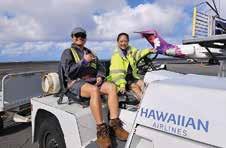
Wāhine at Work
In 1942, Hawaiian Airlines became the first commercial airline to take scheduled cargo service to the skies. Since then our business— and employee demographic—has continuously evolved to meet the needs of the day. The number of women working in aviation has steadily increased over the last eighty years, including in the air freight sector of the industry. What began as a mostly male division has neared equilibrium in representation. At Hawaiian Air Cargo, the freight arm of Hawaiian Airlines, that balance has been struck: Wāhine (women) now make up 50 percent of all cargo employees, a 12-percent increase across the operation over the past decade. Within that group, 48 percent are cargo agents with an average tenure of 17.5 years.
“One of the many things I love about my job is the meaningful impact Hawaiian Air Cargo has on Hawai‘i and beyond,” says Delrie “Ku‘uipo” Anderson, cargo capacity supervisor at Daniel K. Inouye International Airport in Honolulu. Ku‘uipo has worked at Hawaiian for 13 years. “Every day, we are moving fresh foods, dry goods, pets and more, directly supporting the communities we serve.
I was honored to be part of the Hawaiian Airlines Mālama Maui team helping to get needed goods and supplies to Maui after the Lāhainā wildfire. Hawaiian Airlines offers me the chance to make a positive difference every day and I’m proud to work for our hometown carrier.”
Virtually There
For the last 20 years, Ahuimanu Elementary School teachers, including Matthew Duarte, have facilitated a “trip to Europe” activity for third-grade students. The goal: Teach children about the world of aviation and the importance of travel experiences.
“Our kids are learning about different countries,” Duarte explains. “Each student researches a specific country and later presents their findings to the rest of the class. We also pretend we are on an airplane going to their country — we have passports that the kids get stamped and set up the chairs so it’s like they’re boarding an aircraft for an international trip.”
In reality, many of Duarte’s students have never been on board an aircraft. That’s where Hawaiian Airlines comes in. In March, thirty children and four chaperones traded their Windward O‘ahu public school campus for a special “trip abroad” at our in-flight training facility in Honolulu. Students boarded mock Boeing 717 and Airbus A321neo cabins. After a simulated take-off, they enjoyed meal and beverage service as though they were on an actual Hawaiian Airlines flight.
“We wanted every student to have the opportunity to reflect on what they learned here when it’s time for them to present,” says Duarte. “Learning about travel and aviation will open their minds about maybe one day going abroad, learning about other cultures and sharing those experiences with their family and friends.”
For more news and information about our airline ‘ohana, visit newsroom.hawaiianairlines.com
158 HAPPENINGS AT HAWAIIAN AIRLINES
Puanani ‘Pua’ Kaimiola (left) and Regina ‘Gina’ Mitchell are both cargo agents at Kona International Airport.
after first purchase *
Two free checked bags on eligible flights
One-time 50%-off companion discount
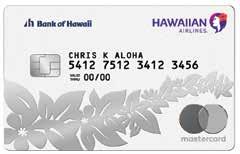
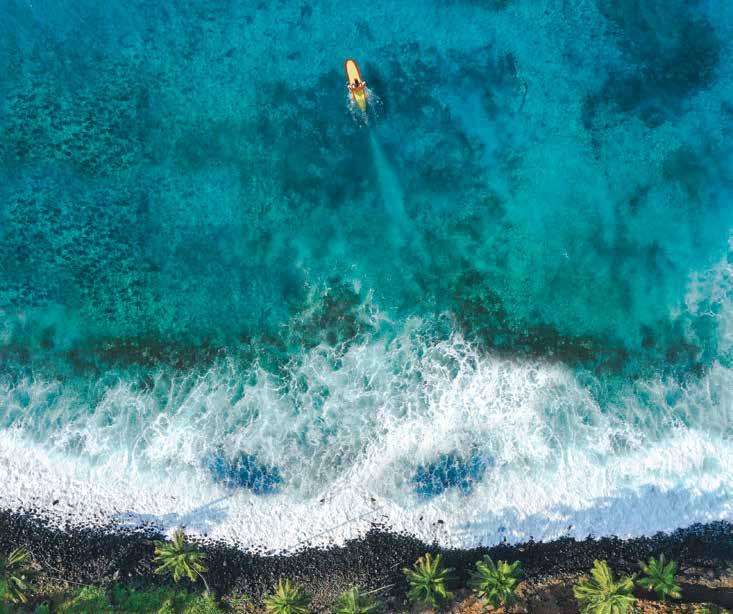
HAWAIIANMILES
Annual $100 companion discount Ask your Flight Attendant for an application.* Special in-flight offer is available through the in-flight application.
HAWAIIANMILES
Earn
ON GAS, DINING AND ELIGIBLE GROCERY STORE PURCHASES
ON ELIGIBLE HAWAIIAN AIRLINES PURCHASES
HAWAIIANMILES
ON ALL OTHER PURCHASES
*Offers may vary. Terms apply. See your flight attendant for an application with more information about this offer. The Hawaiian Airlines® Bank of Hawaii World Elite Mastercard® is issued by Barclays Bank Delaware pursuant to a license from Mastercard International Incorporated. Mastercard, World Mastercard, World Elite Mastercard, and the circles design are registered trademarks of Mastercard International Incorporated. © 2024 Barclays Bank Delaware, PO Box 8801, Wilmington, DE 19801, Member FDIC. 70,000 bonus HawaiianMiles® HAWN-38187_Consumer_HanaHouFP_JunJul2024.indd 1 3/11/24 10:25 AM
STORY BY SARAH ROSE
Interplanetary Culture
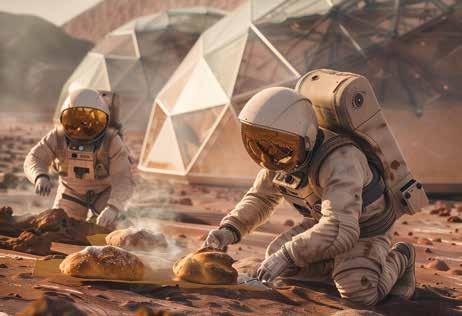
Aplastic baggie of deathly smelling goo arrived as a care package for Kim Binsted, a University of Hawai‘i professor, in late 2019. Inside was a note from chef Michael Kalanty, introducing her to the glop: Lucky Lady 99. Her strength and lineage, Kalanty wrote, might make her a good candidate for a three-year mission to Mars … someday. In the meantime, enjoy!
Lucky Lady is a microbial paste, specifically a sourdough yeast culture. She is the 99th entry in the sludge library of Belgium, otherwise known as the International Sourdough Library at St. Vith, a gift from the longtime executive baker for Le Cordon Bleu cooking schools. The library farms fungal colonies from around the world for a bakery conglomerate.
The guck arrived while Binsted and I were in southern China. It sat heating up in a mail locker in Kāne‘ohe until we returned to Hawai‘i, just barely avoiding—little did we know then—yet another hardy microbe, SARS-Co-V 2. Binsted and Kalanty had been
discussing the intricacies of baking bread on Mars. Binsted was the principal investigator on a space experiment on Mauna Loa, HI-SEAS, the Hawai‘i Space Exploration Analog and Simulation, where fake astronauts pretended to live in a Mars habitat to study real Martian problems—like what to cook for dinner and how to not murder other astronauts stuck with you in your 1,200-square-foot geodesic dome.
Bread is simple; it’s nothing but water, flour and yeast. But in space, simple is very, very hard. You have only the water you can carry; while it’s essential, it’s also expensive. Every drop gets weighed as a cost against rocket fuel. On Mars, water is scarce and must be extracted. Both on the trip to and on the surface of Mars, water will be recycled, meaning your own pee will become the water with which you bake your bread, which ends up back in your pee.
Flour is about half as heavy as water, requiring half as much boost to launch. The wheat-to-water ratio
became apparent when Binsted purchased a fifty-pound bag of flour, enough to fill a thirteen-gallon trash can (which is where we put it). By contrast, fifty pounds of water is only six gallons. Lucky Lady’s weight is negligible; she will get bigger so long as you feed her. No one knows how yeast will behave in microgravity other than (scientists assume) that it will blow bigger bubbles during fermentation. This alien bread experiment has yet to be conducted, as there’s no easy way to simulate zero-g or the low gravity of Mars long enough to bake a space baguette.
Nevertheless, with all three components—water, flour and Lucky Lady—I set to work feeding and cooking Miss 99. I’ve been escaping to Hawai‘i from New York winters for the past twenty years, and this is why I am a writer but also why I am broke. My rent gets paid in sweat, which means occasionally indulging Binsted’s sci-fi kitchen fantasies, including ostrich egg Scotch eggs and roast mer-pig, swapping halves of a parrot fish and a piglet.
Lucky Lady arrived just prior to the pandemic. Our pictures of meager sourdough loaves were posted to social media a few weeks ahead of the nationwide shortages that emptied supermarket shelves. All at once Lucky Lady 99 became very popular. Everyone wanted a piece of her, and she was breeding with vigor. Across the globe, sourdough practice soon colonized our own individual isolation experiments, however impractical it was for a prospective outpost on Mars. Bread on Earth takes time—and boy, did we have time—yet not so much time you can’t fold dough in the two minutes between Zoom cocktail hours.
Lucky Lady was a star—until our long national nightmare ended and supermarket shelves were once again full of wonder (bread). hh
160
PAU HANA



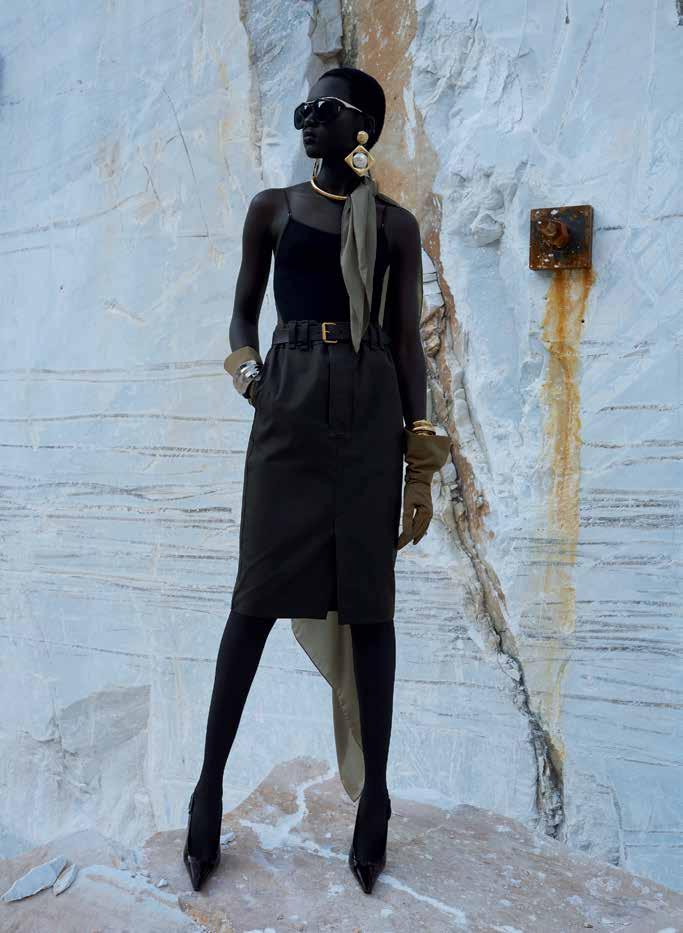




 THE LAUNIU WARD VILLAGE AMENITY LOBBY
THE LAUNIU WARD VILLAGE AMENITY LOBBY































 STORY BY CONNER GORRY
STORY BY CONNER GORRY


 STORY BY MARTHA CHENG
STORY BY MARTHA CHENG

















 STORY BY CONNER GORRY
STORY BY CONNER GORRY





























































 Tropical Blades practices a forward lunge line with a shoulder hold at Ice Palace, one of the maneuvers they’ll perform at the championships in San Jose in July.
Tropical Blades practices a forward lunge line with a shoulder hold at Ice Palace, one of the maneuvers they’ll perform at the championships in San Jose in July.








































































 photo courtesy akame
photo courtesy akame

















 Arizona Memorial Place, Honolulu
Arizona Memorial Place, Honolulu

















































 PHOTOGRAPHY
PHOTOGRAPHY

















































